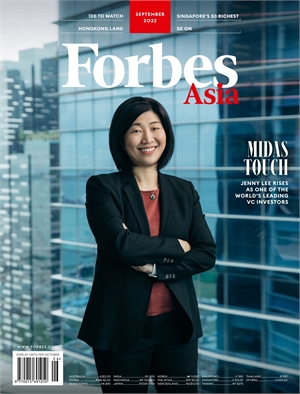


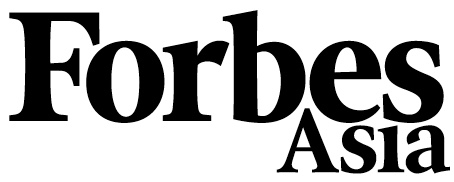
September 2022 Volume 18 • Number 6
INSIDE
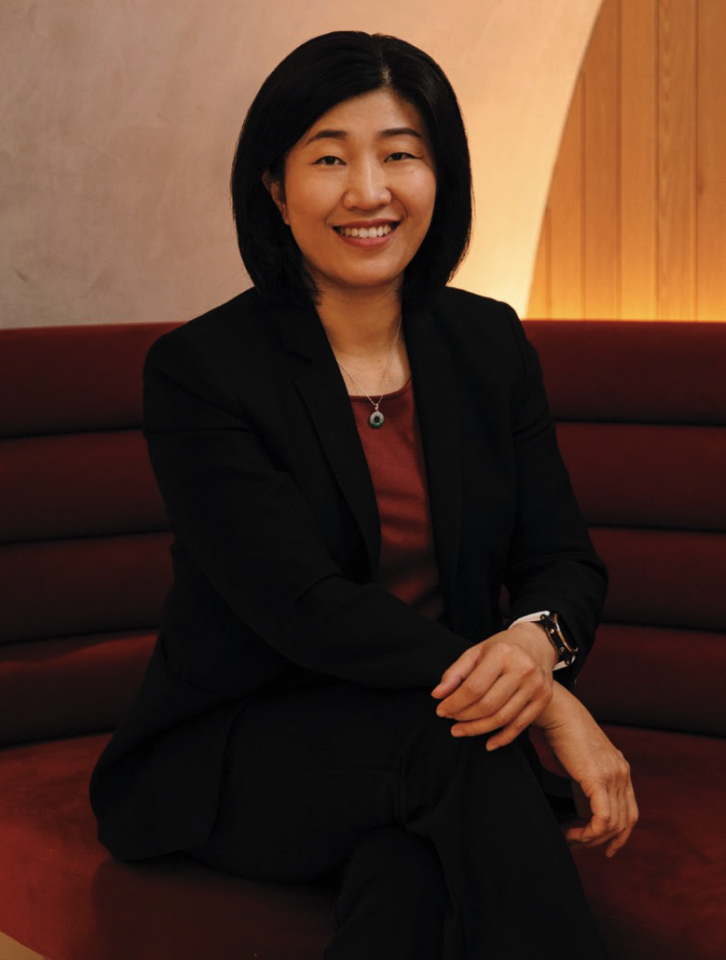
THE PROFILE
Veteran venture capitalist Jenny Lee made her mark backing some of China’s top tech startups. Now Southeast Asia may offer her similar early-stage opportunities in the region’s fast-growing digital economy.
By Jonathan Burgos
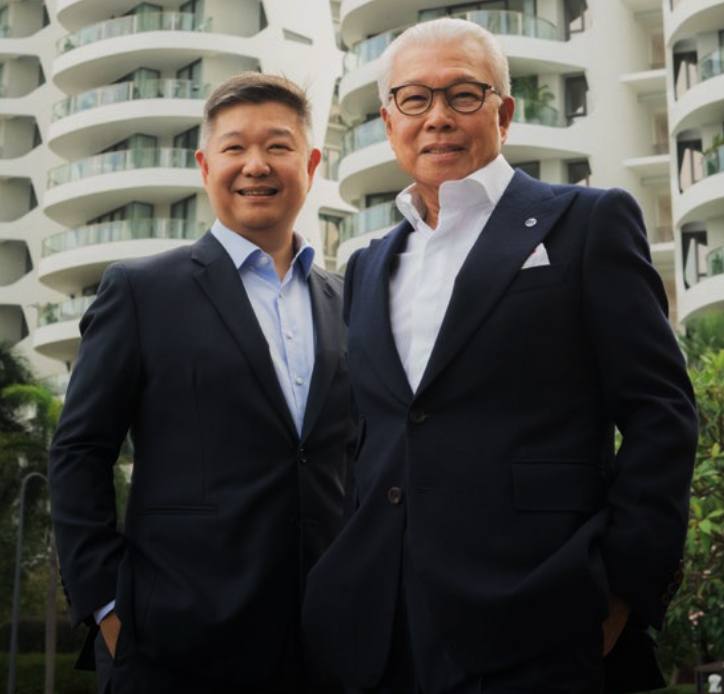
SINGAPORE’S 50 RICHEST
Chua Thian Poh has strengthened Ho Bee Land with well-timed condo sales in Sentosa Cove, a cash-generating commercial play and deals overseas.
By Jonathan Burgos and Gloria Haraito
While Singapore continued to draw wealthy foreigners, global headwinds took a toll on the combined fortunes of the nation’s richest this year.
By Naazneen Karmali and Jane Ho
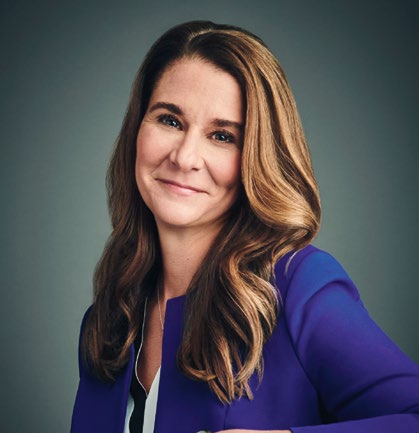
PHILANTHROPY
With more autonomy and perspective following her divorce, Melinda French Gates’ take might be just what philanthropy—and society at large—needs to solve for today’s most intractable issues.
By Moira Forbes
THE LIST
As Asia-Pacific moves into post-pandemic mode, the qualities of creativity, resilience and capacity for change shine through in the second 100 to Watch list.
Edited by John Kang and Catherine Wang
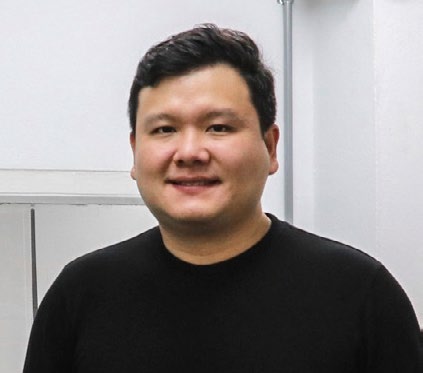
ENTREPRENEURS
Trained as an engineer, James Yenbamroong cut his teeth at defense giant Northrop Grumman before launching his own satellite company in Thailand. Mu Space is burning through capital to get his vision off the ground.
By Ron Gluckman
TECHNOLOGY
The maker of Photoshop and Premiere Pro gave the world AI-powered tools to create convincing fakes. Now CEO Shantanu Narayen wants to clean up the mess.
By Aayushi Pratap
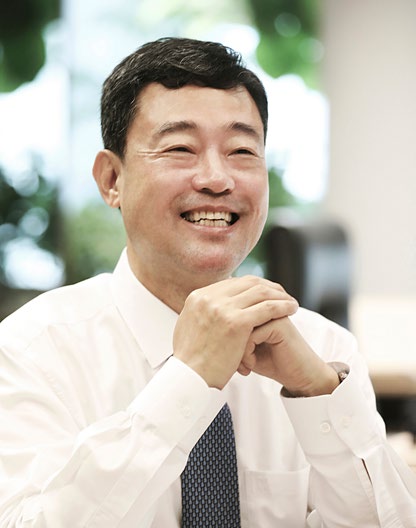
FEATURES
Jee Dong-seob aims to have Seoul-based SK On lead the global EV battery market by 2030, besting some powerful rivals from around the globe.
By Catherine Wang
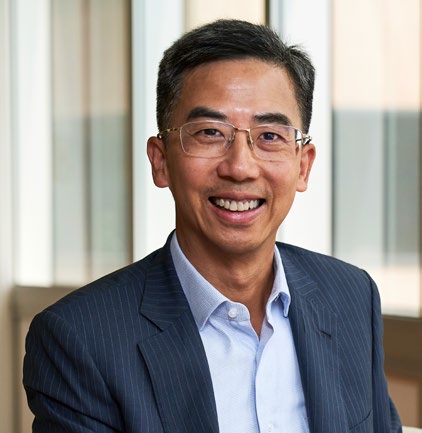
China’s property market turmoil hasn’t deterred Hongkong Land’s CEO Robert Wong from taking an $8.4 billion bet on an iconic Shanghai project—he says now is the time to seize opportunities.
By Zinnia Lee
Japanese education tycoon Soichiro Fukutake used his fortune to transform the industrially ravaged Seto Islands into a global art destination—giving a boost to the region’s economy along the way.
By James Simms
THE INVESTIGATION
In 2020, Adam Neumann’s family office became a lead investor in real estate tech company Alfred. Less than two years later, the ex-WeWork CEO announced a new venture, Flow, with $350 million in funding.
By Iain Martin, Alex Konrad and Cyrus Farivar
INNOVATION
Hospitals have long used ultraviolet light to zap viruses, but the devices were too expensive for businesses and schools. Spurred by the pandemic, an unlikely trio started R-Zero to develop a lower-cost alternative.
By Amy Feldman
FORBES LIFE
A new Forbes survey of the world’s richest people found many still do household chores like taking out the garbage and grocery shopping.
By Jemima McEvoy
Steve Forbes
The way forward to end inflation.
Rich Karlgaard
Live and learn.
On property.
CHUA: NICKY LOH FOR FORBES ASIA. COVER CREDIT JENNY LEE : Photograph by Juliana Tan for Forbes Asia. GATES: JASON BELL, YENBAMROONG: COURTESY OF MU SPACE, DONG-SEOB: COURTESY OF SK ON, WONG: KEN WU FOR FORBES ASIA

BUSINESS
Chief Executive Officer William Adamopoulos
Senior Vice Presidents Tina Wee, Eugene Wong
Vice Presidents Aarin Chan, Janelle Kuah
Director, Circulation Eunice Soo
Sales Directors Michelle Ong, Janice Ang, Kathy Cheng
Deputy Director, Circulation Pavan Kumar
Deputy Director, Events & Communications Audra Ruyters
Deputy Director, Conferences Jolynn Chua
Deputy Director, Marketing & Research Joan Low
Deputy Director, Ad Services – Digital Keiko Wong
Deputy Director/Assistant to CEO Jennifer Chung
Senior Manager, Events & Communications Melissa Ng
Senior Manager, Ad Services Fiona Carvalho
Conference Managers Clarabelle Chaw, Peh Ying Si
Managers, Marketing & Research Gwynneth Chan, Kwang Yoke Peng
Manager, Advertising Vanessa Lim
Assistant Manager, Marketing & Research Goh Yu Zhen
Advertising Executives Nurafida Ibrahim, Maggie Yeo, Lulinda Leung
Circulation Services Taynmoli Karuppiah Sannassy, Jennifer Yim
EDITORIAL
Editor Justin Doebele
Asia Wealth Editor & India Editor Naazneen Karmali
Senior Editors Robert Olsen, Jennifer Wells
Special Projects Director Rana Wehbe Watson
Design Director Mirna Aprilla
Senior Reporter Jonathan Burgos
Associate Editor John Kang
Senior Designer Mossy Chew
Reporter/Multimedia Producer Zinnia Lee
Multimedia Producer Shan Shan Kao
Reporter Catherine Wang
Executive Assistant Sharon Joseph
Contributing Editors Richard Borsuk, Susan Cunningham, Jane Ho, Gloria Haraito, Brian Mertens, Phisanu Phromchanya, Amit Prakash, Yessar Rosendar, Ardian Wibisono
ASIA CONTRIBUTOR NETWORK
Beijing Yue Wang
Chennai Anuradha Raghunathan
Delhi Megha Bahree
Ho Chi Minh Lan Anh Nguyen
Hong Kong Shu-Ching Jean Chen
Manila Roel Landingin
Perth Tim Treadgold
Singapore Jessica Tan
Taipei Joyce Huang
Tokyo James Simms

CHAIRMAN AND EDITOR-IN-CHIEF: STEVE FORBES
FORBES MEDIA
Chief Executive Officer and President Michael Federle
Chief Operating Officer Jessica Sibley
Chief Financial Officer Michael York
General Counsel MariaRosa Cartolano
Assistant General Counsel Nikki Koval
Editor-at-Large/Global Futurist Rich Karlgaard
EVP, ForbesWoman Moira Forbes
FOUNDED IN 1917
Editor-in-Chief (1917-54) B.C. Forbes
Editor-in-Chief (1954-90) Malcolm S. Forbes
Editor (1961-99) James W. Michaels
Editor (1999-2010) William Baldwin
EDITORIAL
Chief Content Officer Randall Lane
Executive Editors Caroline Howard, Bob Ivry, Luisa Kroll, Kerry Lauerman, Michael Noer, John Paczkowski, Matt Schifrin
Design Director Alicia Hallett-Chan
Managing Editor Joyce Bautista Ferrari
Assistant Managing Editors Steven Bertoni, Diane Brady, Seth Cohen, Kerry A. Dolan, Alice Jackson-Jolley, Rob LaFranco, Rashaad Lambert (Culture & Community), Jeffrey Marcus, Janet Novack, Michael Ozanian, Michael Solomon
Editorial Counsel Jessica Bohrer
DIGITAL
Chief Product Officer Nina Gould
Chief Technology Officer Vadim Supitskiy
SEPTEMBER 2022 — VOLUME 18 • NUMBER 6
FORBES ASIA (ISSN 1793 2181) is published monthly, except bimonthly in December/January, February/March and April/May. FORBES ASIA is printed at Times Printers in Singapore. Singapore MCI (P) 046/11/2021. Malaysia KDN PPS 1411/01/2013 (022902). All rights reserved. Title is protected through a trademark registered with the U.S. Patent & Trademark Office. FORBES ASIA is a trademark of FORBES ASIA. Copyright © 2013 FORBES ASIA.
CONTACT INFORMATION
For Subscriptions: visit www.ForbesAsiaSubscribe.com, email subscribe@forbesasia.com.sg or call FORBES ASIA at +65 6836 1652 / +65 6836 9476.
For Advertising: email advertising@forbesasia.com.sg or call FORBES ASIA at +65 6836 3408.
For Article Reprints or Permission to use FORBES ASIA content including text, photos, illustrations and logos: email reprints@forbesasia.com.sg or call FORBES ASIA at +65 6836 3408. Use of FORBES ASIA content without the express written permission of FORBES ASIA or copyright owner is expressly prohibited.
The Way Forward
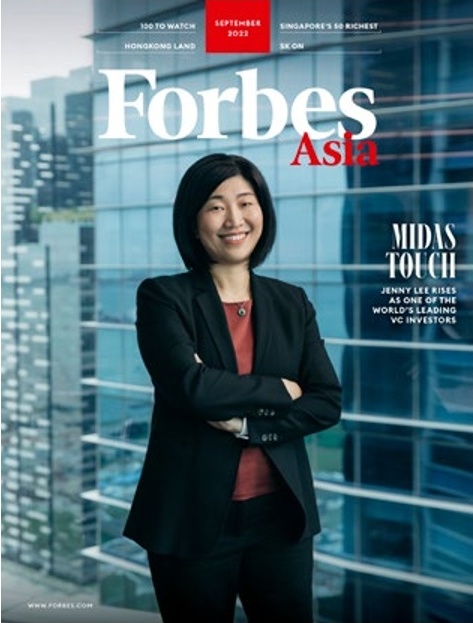
T he title of this column has found its way across many of this issue’s pages. It’s also an allusion to the theme of the Forbes Global CEO Conference being held in Singapore this month—on the global community’s search for a way forward in the post Covid-19 era.
This event has the twin significance of being the 20th time it has been held, the inaugural event also in Singapore in 2001, and the first live version since 2019. A younger me helped shape that earlier conference, which remains a signature event worldwide for Forbes.
One concern in finding a way forward is how to deal with rising inflation. It’s a topic that Steve Forbes tackles in a special Fact & Comment column that excerpts from his recent book on inflation—and drawn from a chapter aptly entitled “The Way Forward.”
This issue has other special elements. The two lists that appear are like bookends—Singapore’s 50 Richest list and the second annual 100 to Watch list. Aside from the obvious tie-in with the conference’s location, Singapore’s 50 Richest list features many who created their wealth by building major companies out of startups akin to those populating the 100 to Watch list.
Exemplifying the entrepreneurial journey from humble start to billionaire is Chua Thian Poh. While his property firm Ho Bee Land was a respectable success around the time of our first CEO event, Chua had the foresight to make Ho Bee the largest developer of properties on Sentosa Cove in its early days, the success of which led to major moves into commercial properties and international holdings.
Another risk-taker is Jenny Lee of VC firm GGV Capital. Her cover profile encapsulates many facets of the way forward theme. Lee rose up in a highly competitive industry and overcame challenges in China in the mid-2000s that led to spectacular investments. She now ranks among the world’s top VC investors.
Finding a way forward describes the actions of SK On’s co-CEO Jee Dong-seob and Hongkong Land CEO Robert Wong, both of whom run sizable companies and have embarked on outsized expansions despite strong competitive and economic headwinds. Then there’s Thai entrepreneur James Yenbamroong whose ambitions literally reach the stars with his spacetech startup mu Space.
Rounding it all out is a look at Japan’s art islands created by education tycoon Soichiro Fukutake—a wonderful tale of entrepreneurship, art patronage, philanthropy and guts. His determination to transform an industrial wasteland into a stunning mix of world-class art venues across a cluster of islands is the very embodiment of finding a way forward.
Oh, and one more thing. This is our biggest magazine, at 152 pages, that’s been published since the 100th anniversary issue in 2017. This heft confirms Forbes Asia’s way forward is to keep providing content valued by Asia-Pacific’s business community. So please enjoy this carefully crafted special issue timed to our CEO conference. As always, all comments welcome at editor@forbesasia.com.


JUSTIN DOEBELE
EDITOR, FORBES ASIA
“With all thy getting, get understanding”
• FACT & COMMENT •
The Way Forward to End Inflation
By Steve Forbes, Editor-in-Chief
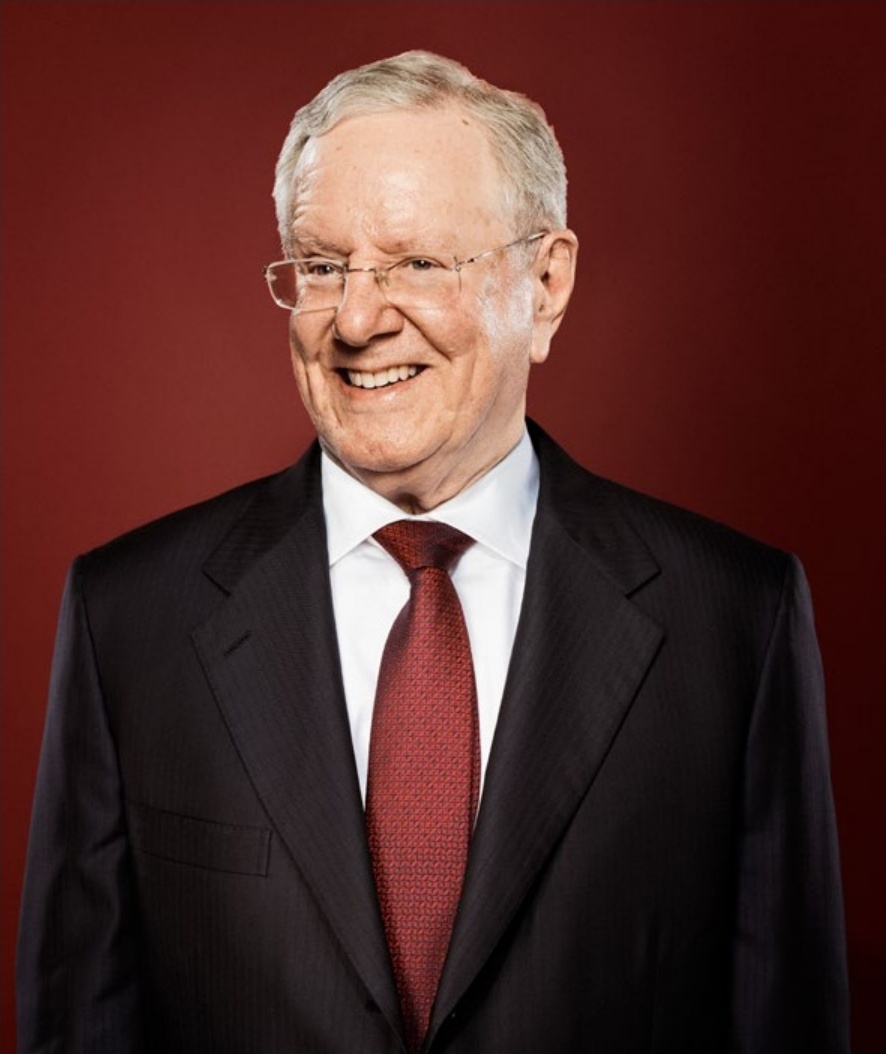
Below is an edited excerpt from Chapter Six “The Way Forward” of the book Inflation: What It Is, Why It’s Bad, and How To Fix It, which I co-authored with Nathan Lewis and Elizabeth Ames. All too many policymakers and central bankers don’t grasp that an economy works best when money has a stable value. If they did, the U.S. economy—and all of us—would benefit.
There are some good reasons why a replay of the 1970s is not inevitable. In fact, it is very possible that recent events may prove to be a turning point—an opportunity to open the discussion about ending inflation by returning to stable money and a gold standard.
For one thing, the twenty-first century is not the 1970s, when there was no Internet or cable television to do a deep dive into a subject and endlessly discuss and debate. Back then, people didn’t get constant breaking news notifications on their handhelds. They didn’t live with a big news story 24/7.
Today, inflation, for the first time in decades, is that story. Americans are getting constant updates about spikes in gas and food prices, and record increases in the CPI. They’re able to process this information in a way they couldn’t forty years ago. Individuals who might not have previously paid attention are hearing warnings about the connection between today’s dangerous level of government spending and the rising prices that have been eating away at their paychecks.
Younger people struggling to pay off student loans are learning that their salaries are being inflated away so that Uncle Sam can keep printing and borrowing zero-interest-rate free money, and they don’t like what they’re hearing.
Something else is happening, too. The rise of social media and the recent pandemic have raised doubts about the judgment of public officials, whose tweets and ever-changing declarations show them to be as human and fallible as the rest of us. In the words of Newsweek, the experience of Covid-19 has “dealt an irreparable blow to the credibility of America’s ruling class.”
WITH A GOLD STANDARD, THERE WOULD BE NO INFLATION. FULL STOP.
That includes not only public-health bureaucrats but, presumably, central bankers. As the CPI continues to rise, more people will see through their opaque justifications for rising prices and conclude that they simply don’t make sense.
Americans alarmed about the rise of socialism may also question a central banking system whose manipulation of money and interest rates comes perilously close to Soviet-style central planning. How can a handful of banking bureaucrats presume to make monetary policy that can effectively control the activity of a U.S. economy comprised of 330 million people?
There are other reasons to be optimistic. One of them is the central truth that policymakers and Keynesians inevitably fail to grasp: governments may debase currency, but people instinctively seek monetary stability. Remember, that was why money was invented in the first place: to provide a trusted and unchanging unit of value. The need for stability is why, after the U.S. abandoned gold, the euro was established by European nations seeking refuge from floating fiat currencies. It is why the Swiss franc is in high demand on the global markets.
It is also why the Bank of England and the young United States, centuries earlier, ended inflation by pegging their money to gold, which set off an explosion of prosperity that changed the world. So how do we recover monetary sanity and return to a healthy economy with low inflation? The first step is for citizens to promote awareness of the principles of sound money.
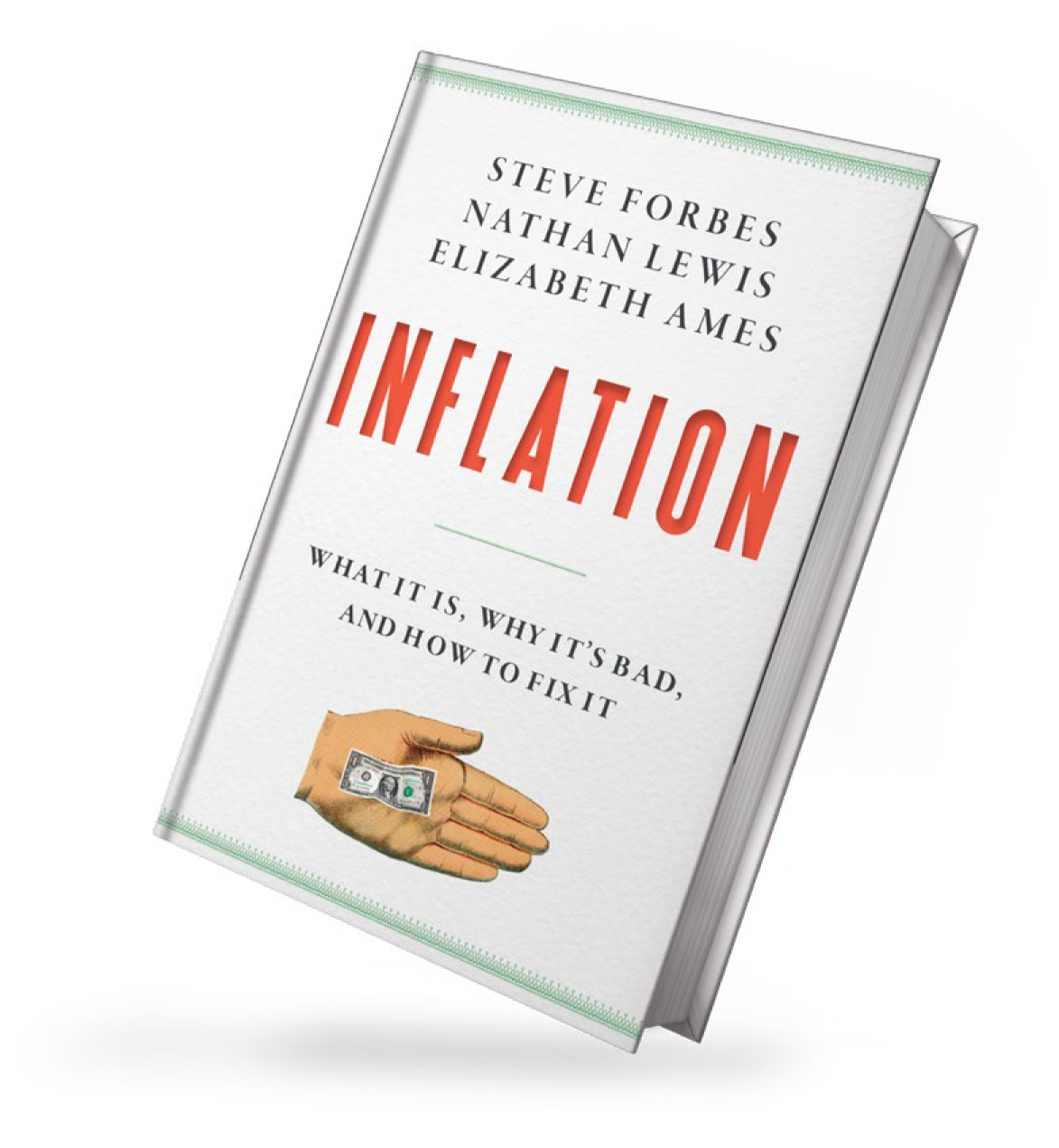
Money loses value and you get inflation when the dollar is no longer trusted as a reliable unit of worth. We discard a clock when it breaks down and no longer can be trusted to tell time. Or throw away a scale that stops working. The same applies to money. People lose faith in a currency that is no longer reliable, or whose supply is increasing beyond all reasonable need. Demand decreases. Money loses value. You get inflation.
A rise in the gold price means the dollar has lost value. The yellow metal is the most stable commodity in the world. Therefore, when the price of gold rises, that means that more dollars are needed to buy gold. In other words, the dollar’s value has declined. Gold’s stable value is what makes it the best barometer of the worth of the dollar, or any other currency. Skeptics commonly claim that we can’t go back to a gold monetary standard because gold is “unstable.” Nothing is farther from the truth. If the dollar was stable, the price of gold wouldn’t fluctuate.
The best way to end inflation, and to spur economic growth, is through a return to a sound dollar anchored by gold. A gold standard simply links the greenback to gold, in much the same way that dozens of countries today link their currencies to the dollar or euro. The U.S. relied on a sound dollar for nearly two centuries and it became the wealthiest country in the history of the world. Remember, money is, above all, a measure of worth. We should no more manipulate the dollar’s value than we should float the number of inches in a ruler. And yet we have—with disastrous results.
The last fifty years of inflationary Fed policies and the floating fiat dollar has seen slower growth and more economic crises. According to one study, their frequency has doubled since the early 1970s, compared with the Bretton Woods and classical gold standard periods. That study was conducted before the financial meltdown of 2008. With a gold standard, there would be no inflation. Full stop. A gold standard simply means that money has a fixed value and can fulfill its intended function as a trusted unit of worth.
YOU GET INFLATION WHEN THE DOLLAR IS NO LONGER TRUSTED AS A RELIABLE UNIT OF WORTH.
Stable money and no inflation would mean more investment and a soaring economy. During the late 1800s era of the classical gold standard, when the U.S., England, most of Europe, and eventually Japan, linked their currencies to gold, more wealth was created during that century than all the previous centuries put together. The United States had what could be characterized as “full employment” ( jobless rates of less than 5%) during most of the decade of the 1920s, and also the decade of the 1960s, when the dollar was pegged to gold. Contrary to what many people believe, you don’t necessarily need a large supply of gold to maintain a gold standard. A system could be phased in within about twelve months. After that, watch the U.S. economy take off!
• TECH CONNECTOR •
Live and Learn
By Rich Karlgaard

Now in its 20th year, the Forbes Global CEO Conference will be held Sept. 26-27 in Singapore. The Way Forward is this year’s theme. Good timing!
The global economy is at a crossroads. One road points to an exciting new era of prosperity and inclusion, with life-changing improvements in widespread availability of healthcare, education, transportation, housing—and, critically, access to capital and opportunity. The other fork points to a dark place: economic stagnation, social instability, geopolitical turmoil, more energy and climate uncertainty, and persistent barriers to healthcare, education and opportunity.
Nearly all of us would choose the first road—let’s call it the path to sustainable prosperity. The challenge for leaders in business, investment, academia and government is to move decisively in that direction and avoid false paths and dead ends. To do that, we must start with an honest assessment of where we find ourselves today. This advice especially applies to Asia-Pacific, home to China, the world’s second-largest economy, plus five more, each with over $1 trillion in GDP: Australia, Japan, Korea, India and Indonesia.
We begin with the Covid-19 pandemic. It has caused nearly 7 million deaths and trillions in economic damage as of June 30—and hit Asia first and arguably the hardest worldwide. While the peak danger appears to be over, the pandemic has not yet settled into predictable seasonal patterns, which creates lingering uncertainty. Another uncertainty is a level of inflation not seen since the 1970s. Add to that, supply disruptions, including semiconductors that drive 21st century innovation. And finally, labor shortages, which prevail in all developed countries around the world. Asia-Pacific’s varied economies, from developed to emerging, feel the pain of these in different ways.
The longer-term challenge remains what it was before Covid: Today’s global population of 8 billion is projected (by the United Nations and other sources) to become 9.5 billion by 2050—much of that growth coming from Asia. Average global temperatures are expected to rise 1 to 1.5 degrees centigrade over that period. The world is becoming hotter and more crowded. Covid has not altered this longer term forecast.
The tasks for business, financial and political leaders are not trivial—both now and for the future. The paths to sustainable prosperity are not as clear as idealists would have us believe. Take energy. Prosperity (and peace) depend on it—the more, the better. Hope is not a strategy. We also need insights to move forward—in terms of knowledge, tools, management practices, leadership skills—to get on the path to sustainable prosperity.
It all comes down to learning.
Do you know that the average person in the world is about five times richer today than in 1950? (The tremendous strides in growth in China, Japan and Indonesia had an outsized contribution to these figures.) Back then, the global population was 2.5 billion, less than a third of today’s 8 billion. We humans have a remarkable ability to create more net resources and wealth than we consume. There is only one explanation for this entropy-defeating miracle. It is learning.
As Steve Forbes likes to say, what separates humans today from 1950 or 1650 can be stated in three simple words: We know more. Two hundred years ago, no one knew that fuel could be extracted from buried rocks, or that this fuel would replace horses and steam as transportation energy. No one knew the speed of light, or how to increase crop yields or even filter water. For the most part, no one knew what made people sick.
If the global economy today is at a crossroads—and it is—the only path forward goes through accelerated learning. In order to solve today’s largest problems and create new foundations for sustainable prosperity, we must have more people in the world, credentialed or not, who know more, learn faster, and apply and spread their knowledge—thus creating a feedback loop of accelerated learning for all. Asia’s role in this process will be critical for the global economy.
Learning is the whole game, dear readers. It is our salvation and hope. I believe learning will be the global growth industry of the next two decades. As Steve Forbes says at the top of his Fact & Comment column: “With all thy getting, get understanding.” Wise words.

Rich Karlgaard is editor at large at Forbes. As an author and global futurist, he has published several books, the latest of which is Late Bloomers, a groundbreaking exploration of what it means to be a late bloomer in a culture obsessed with SAT scores and early success. For his past columns and blogs visit our website at forbes.com/sites/richkarlgaard
ERHUI1979/GETTY IMAGES
• PHILANTHROPY •
Next Act
With more autonomy and perspective following her divorce, MELINDA FRENCH GATES’ take might be just what philanthropy—and society at large—needs to solve for today’s most intractable issues.
By Moira Forbes
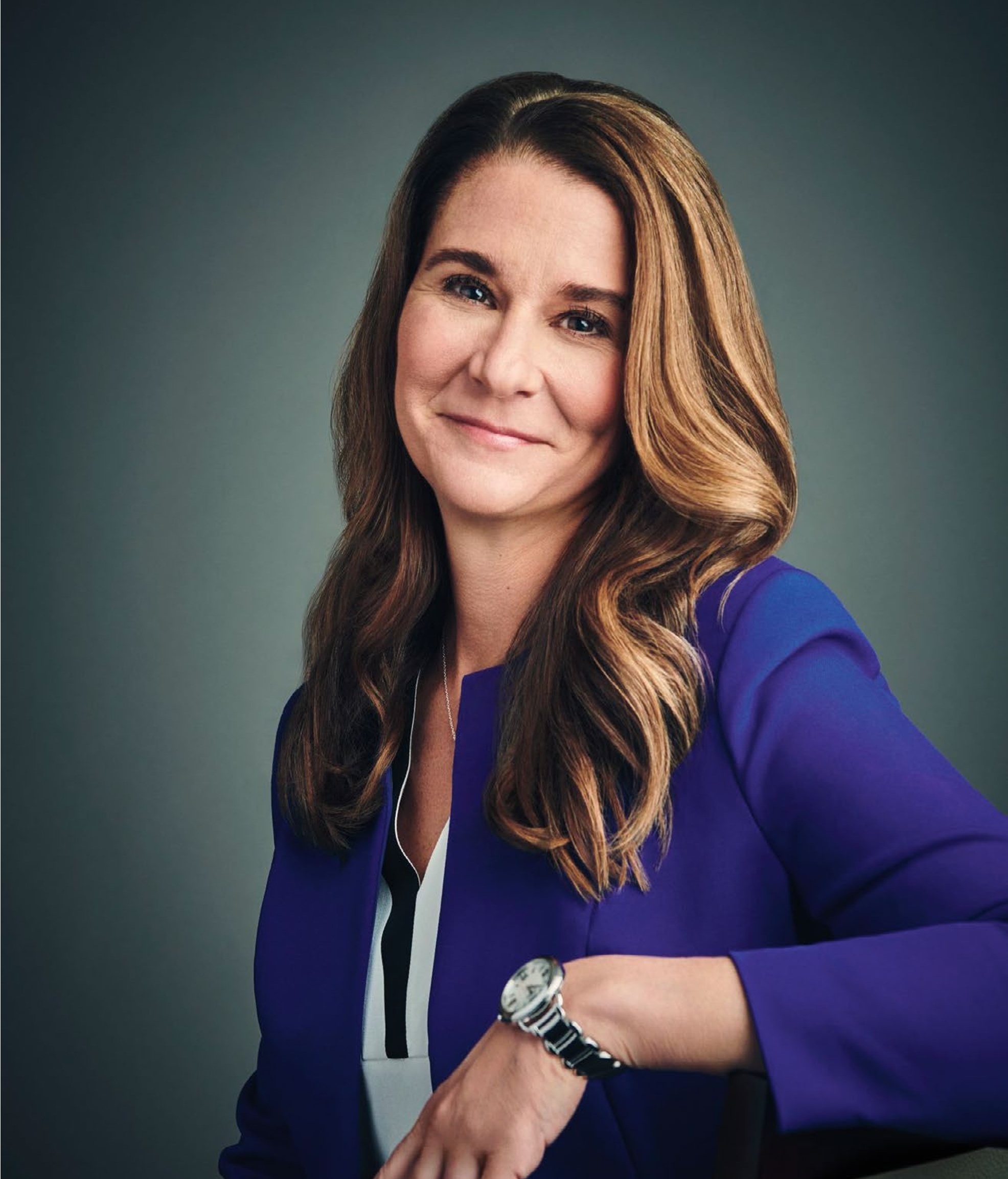
“I’m now an incredibly confident giver. I know what I believe in,” says philanthropist Melinda French Gates in an exclusive interview with Forbes. “I know I have so much still to learn, and that actually excites me. I have certain convictions, and I’m living those out through my giving.” After 22 years as co-chair of the Gates Foundation, the world’s largest private philanthropic entity, French Gates is once again shifting the focus of philanthropy as she steps into a new chapter following her divorce from Bill Gates.
The latest endeavor of French Gates isn’t backed by a nine-figure check, but something equally as powerful, her voice. With the mission of making philanthropy more accessible to everyone, French Gates is now distilling her decades of giving experience into empowering individuals to enact change in their own communities. Today, the online learning platform, MasterClass, announced the release of a new class on impactful giving taught by French Gates. Challenging the perception that philanthropy should be relegated to billionaires with big checkbooks, French Gates offers members a roadmap on how anyone can be a giver and make an impact, regardless of their resources. “We all have something to give back, and I think people often don’t think about those other pieces beyond the money,” says French Gates.
From donating time, giving money, or leveraging an area of expertise, French Gates draws on lessons from her personal philanthropic journey to equip viewers with the tools to begin giving. Class chapters dive into the everyday application of giving and offer best practices on everything from identifying actionable goals to accurately measuring progress and leveraging your voice for the greater good.
As a catalyzing force behind The Giving Pledge which inspired billionaires to commit the majority of their wealth to charitable causes, French Gates is now shifting gears to accelerate giving on a grassroots level. Ultimately, French Gates’ MasterClass is about more than inspiring individuals to act. It’s a call to action to make giving more inclusive and to balance philanthropic power in a way that better aligns all stakeholders.
“I’ve learned how important it is to ensure that the people closest to those problems have a role in designing solutions,” said French Gates in her solo Giving Pledge letter, which she updated late last year. “Philanthropists are generally more helpful to the world when we’re standing behind a movement rather than trying to lead our own,” a sentiment that addresses the growing criticism of billionaire philanthropy head-on.
“People are seeking community right now. We’re seeking ways to come together to create change in our communities, in our countries, and in our world. Philanthropy and giving back are an unbelievably great way to do that,” says French Gates. In increasingly divided times, when economic gaps are widening and skepticism around traditional power structures is on the rise, she believes the message behind her MasterClass is more urgent than ever.
Addressing systemic inequities and bringing new voices to the tables of power have been throughlines across French Gates’ work. As she began to chart her own philanthropic course, she realized that one of her greatest personal challenges was also critical to solving some of the world’s most intractable problems: closing gender gaps. “I think the world has always seen gender as kind of a nice thing to do or as a side issue, particularly in male-run institutions. It took me a while to find my stride and to say, “No, no, no. This is actually the central issue.” She was at the philanthropic forefront with this message, first championing women’s empowerment inside the Gates Foundation and later through the launch of Pivotal Ventures, her independent investment company dedicated to advancing gender and social progress.
Speculation remains around the future of the Gates Foundation and its $55 billion endowment, as she and former husband Bill Gates agreed that French Gates would step down as co-chair in 2023 if they decided they could no longer work together. “I think all the evidence I see says that we’ll be able to run the foundation together forever,” Bill Gates told Forbes in a recent interview.
What’s clear is that the might of French Gates’ philanthropic muscle extends far beyond the walls of the world’s largest private foundation. She’s emerged as one of the most transformational givers not solely by means of wealth, but through her relentless commitment to empowering others and her appreciation that true progress can only be achieved when all voices participate in the solution.
“At the end of my life, it’s not really about what I’ve done,” says French Gates. “It’s much more, ‘Was I loved by my family and friends, and did I change the world in some way to make it better for the next generation?’ And I hope to have done that.”
JASON BELL/COURTESY OF MELINDA FRENCH GATES
THE LIST

Asia-Pacific’s small companies and startups on the rise
EDITED BY JOHN KANG AND CATHERINE WANG
Editing assistance and reporting by Yue Wang
Additional reporting by Jayde Cheung, Zinnia Lee, Yessar Rosendar, Simran Vaswani and Ardian Wibisono
As Asia-Pacific moves into post-pandemic mode, the qualities of creativity, resilience and capacity for change shine through in the second Forbes Asia 100 to Watch list. We spotlight 100 small companies and startups across the region that are addressing real-world challenges with fresh thinking and innovative products and services. These include faster blood tests, more accessible elderly care services, and well-being apps to help those struggling with isolation or burnout. Others on our list are taking aim at climate change, through uber-long-lasting batteries, for example, and more-resilient crops. Some offer fintech solutions to digitalize—and connect—underserved markets. Fifteen countries and territories are represented across 11 categories that include biotechnology and healthcare, e-commerce and retail, and finance. Singapore’s vibrant startup community contributed 19 companies to the list, followed closely by Hong Kong with 16. For the full list, please visit forbes.com/100toWatch.
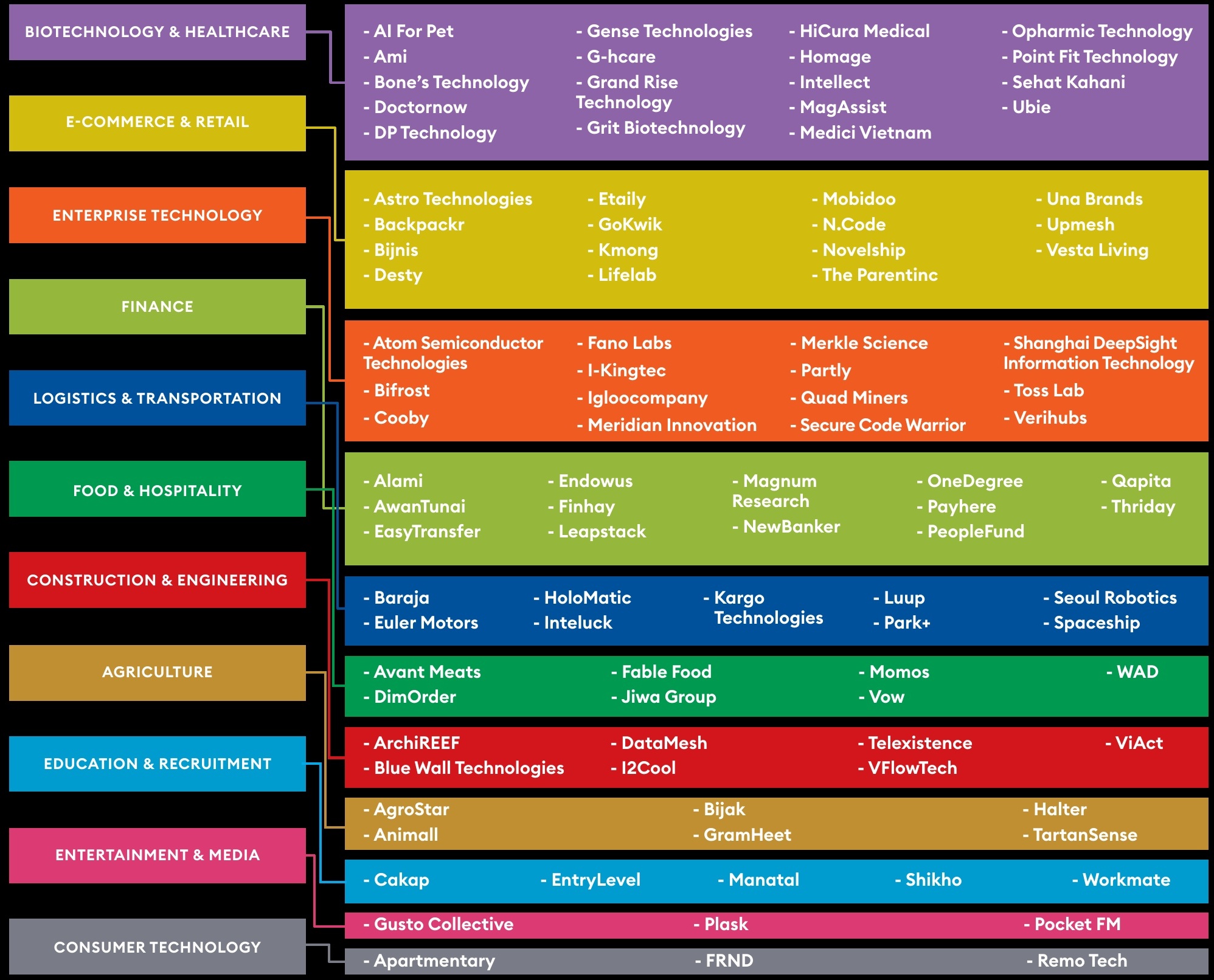
METHODOLOGY: To select our 100 to Watch, Forbes Asia solicited online submissions, and invited accelerators, incubators, SME advocacy organizations, universities, venture capitalists and others to nominate companies as well. The final 100 was selected from over 650 submissions. To qualify for consideration, companies had to be headquartered in the Asia-Pacific region, privately owned, for profit, have no more than $50 million in its latest annual revenue and have no more than $100 million in total funding through Aug. 1. Our team evaluated each submission, looking at metrics such as a positive impact on the region or industry, a track record of strong revenue growth or ability to attract funding, promising business models or markets, and a persuasive story. The editors reserve the right to remove or replace any company or individual included in a list in light of any new information that would disqualify them from inclusion.
THE LIST

AI FOR PET
SOUTH KOREA
BIOTECHNOLOGY & HEALTHCARE
AI For Pet operates an app that can detect eye and skin diseases in cats and dogs using software that analyzes photos users take with their phones. Over 1 million samples of imaging data, labeled by veterinary experts, were used to develop its AI models, the company says.
YEAR FOUNDED: 2020
CEO: Euna Hur
KEY BACKERS: Google for Startups, Industrial Bank of Korea, Korea Asset Investment Securities, Postech Holdings, Shinhan Square Bridge
ALAMI
INDONESIA
FINANCE
Alami aims to transform the Islamic finance industry, starting with its Shariacompliant peer-to-peer lending platform for small and midsized businesses. The startup says its annual disbursement growth tripled over the past two years as it tapped into Indonesia’s growing fish farming and logistic sectors, to bring the total to over $200 million disbursed so far.
YEAR FOUNDED: 2019
CEO: Dima Djani
KEY BACKERS: AC Ventures, East Ventures, FEBE Ventures, Golden Gate Ventures, Lendable, Tryb Group, Quona Capital
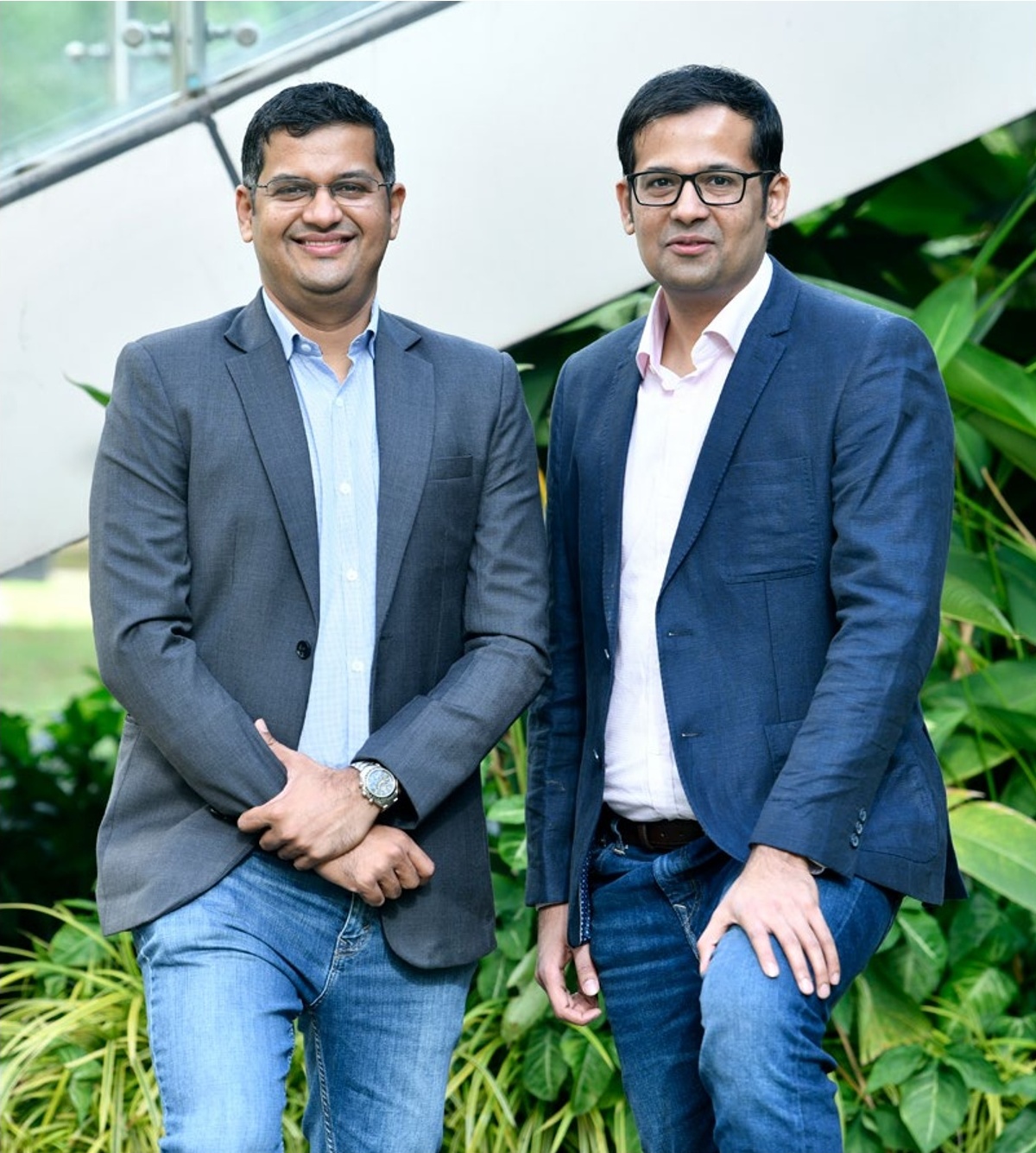
From left: AgroStar cofounders Shardul Sheth and Sitanshu Sheth
AGROSTAR
INDIA
AGRICULTURE
AgroStar’s mission is to “help farmers win” by providing advisory services to improve crop yields and the chance to connect with exporters. It also launched a quality assurance lab in May to test seeds and fertilizers. The startup says its digital network spans over 6.5 million farmers across India, and it processes roughly 70 million data points each month used to tailor recommendations. Through the AgroStar app, farmers can ask questions to experienced “AgroDoctors,” watch tutorials on topics such as soil quality, and network with other farmers. So far it has raised $96 million in funding.
YEAR FOUNDED: 2013
CEO: Shardul Sheth
KEY BACKERS: Aavishkaar Capital, Accel, Bertelsmann India Investments, British International Investment, Chiratae Ventures, Evolvence, Hero Enterprise, International Finance Corporation, Rabo Frontier Ventures, Schroders Capital
AMI
SINGAPORE
BIOTECHNOLOGY & HEALTHCARE
Ami, a “human-centric” mental wellness startup, pairs employees with mental-health professionals to help improve workplace well-being in Asia. The startup has raised $4 million to date and serves over 20 companies and startups in Singapore and Indonesia, with plans to expand into South Korea, Hong Kong, Thailand and Vietnam.
YEAR FOUNDED: 2022
CEO: Justin Kim
KEY BACKERS: Collaborative Fund, Goodwater Capital, January Capital, K3 Ventures, Meta, Strong Ventures
ANIMALL
INDIA
AGRICULTURE
Animall lets farmers in India trade cattle directly with each other via its app. The startup, which began as a part-time project in 2019, has now reached more than 8 million dairy farmers, it says. Animall has supported 850,000 cattle sales in the past three years. It also trades its own animals.
YEAR FOUNDED: 2019
CEO: Neetu Yadav
KEY BACKERS: Beenext, Rocketship.vc, Susquehanna Asia
APARTMENTARY
SOUTH KOREA
CONSUMER TECHNOLOGY
Apartmentary aims to digitalize South Korea’s large but fragmented home renovation market. The Seoul-based startup developed a website and app for end-to-end home renovation services. It claims almost 60% of its customers were very satisfied with its services, higher than the industry average.
YEAR FOUNDED: 2015
CEOS: Junyoung Kim, Soyeon Yoon
KEY BACKERS: Daol Investment, KB Investment, Reverent Partners, Samsung Venture Investment, Shinhan Capital, SoftBank Ventures Asia
ARCHIREEF
HONG KONG
CONSTRUCTION & ENGINEERING
A spinoff company from the University of Hong Kong, ArchiREEF is on a mission to restore coral reefs destroyed by climate change with 3D-printed terracotta tiles. The company works with the governments of Hong Kong and Abu Dhabi, and aims to replace 4,000 coral fragments across the Atlantic, Pacific and Indian oceans by 2025.
YEAR FOUNDED: 2020
CEO: Vriko Yu
KEY BACKER: HKSTP
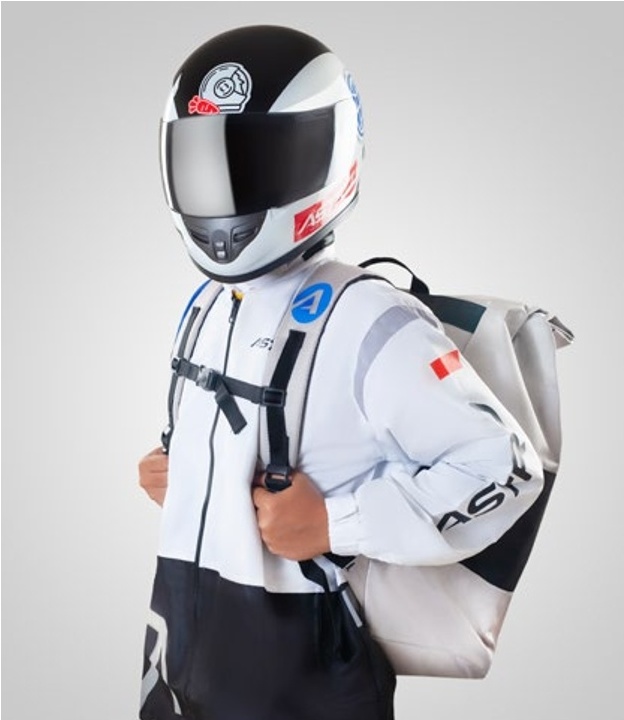
ASTRO TECHNOLOGIES
INDONESIA
E-COMMERCE & RETAIL
Astro Technologies promises a 15-minute delivery of groceries to 50 locations in the greater Jakarta area. To ensure on-time delivery, it operates a network of dark stores—distribution centers for online shopping—and claims to have 1,500 dedicated drivers. The startup says it raised $91.6 million from three funding rounds.
YEAR FOUNDED: 2021
CEO: Vincent Tjendra
KEY BACKERS: AC Ventures, Accel, Citius, Global Founders Capital, Lightspeed Venture Partners, Sequoia India, Tiger Global

ATOM SEMICONDUCTOR TECHNOLOGIES
HONG KONG
ENTERPRISE TECHNOLOGY
Founded by George Yuan, a Hong Kong University of Science and Technology electrical engineering professor who earned a Ph.D. from the University of Pennsylvania, Atom Semiconductor Technologies is one of Hong Kong’s few semiconductor companies. It designs high-performance signal-chain chip solutions for the Internet of Things, with consumer, medical and industrial applications.
YEAR FOUNDED: 2020
CEO: George Yuan
KEY BACKERS: Alibaba Entrepreneurs Fund, HKSTP, Hong Kong University of Science and Technology, Qiming Venture Partners
AVANT MEATS
HONG KONG
FOOD & HOSPITALITY
Using cell-culture technology, Avant Meats is growing fish filets and fish maw (air bladders), which are considered a delicacy in China. The startup has raised about $14 million in funding so far, and is planning to launch a pilot plant in Singapore next year.
YEAR FOUNDED: 2018
CEO: Carrie Chan
KEY BACKERS: Artesian, China Venture Capital, CPT Capital, HKSTP, Lever VC, ParticleX
AWANTUNAI
INDONESIA
FINANCE
AwanTunai provides Indonesia’s larger grocery stores as well as mom-and-pop shops with online financing and payment services, helping to digitalize an otherwise offline sector that mainly relies on cash transactions. Its app also connects stores with suppliers and provides inventory and order management services.
YEAR FOUNDED: 2016
CEO: Dino Setiawan
KEY BACKERS: Global Brain, IFC, Insignia Ventures Partners
BACKPACKR
SOUTH KOREA
E-COMMERCE & RETAIL
Backpackr operates an online marketplace for handmade goods called Idus, a Korean version of Etsy. Idus has garnered more than 5 million downloads on the Google Play store and about 30,000 artisans are on the platform. In 2015, Backpackr acquired crowdfunding site Tumblbug to develop a creator ecosystem.
YEAR FOUNDED: 2012
CEO: Donghwan Kim
KEY BACKERS: Altos Ventures, IMM Investment
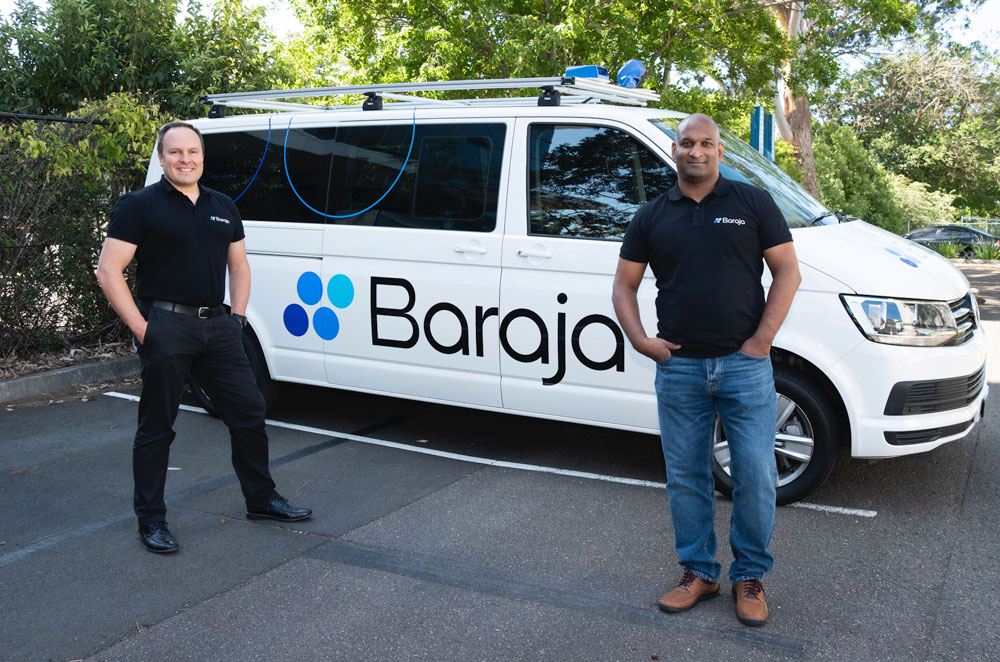
From left: Baraja cofounders Federico Collarte and Cibby Pulikkaseril
BARAJA
AUSTRALIA
LOGISTICS & TRANSPORTATION
Based on lidar technology—which uses lasers to detect objects—Baraja developed a product called Spectrum-Scan that makes self-driving safer. The Sydney-based startup says Spectrum-Scan uses refractive optics to increase the resolution and range of object detection. Last year, Baraja raised A$40 million ($28 million) in series B funding led by Blackbird Ventures.
YEAR FOUNDED: 2016
CEO: Federico Collarte
KEY BACKERS: Blackbird Ventures, HESTA, Hitachi Construction Machinery, InterValley Ventures, Main Sequence, Perennial Partners, Regal Funds Management, Sequoia China

From left: Bifrost cofounders Aravind Kandiah and Charles Wong
BIFROST
SINGAPORE
ENTERPRISE TECHNOLOGY
Bifrost is addressing the biggest hindrance to developing AI: collecting and annotating vast amounts of data. Instead of manually collecting data, the startup builds virtual worlds to create synthetic datasets that train AI models for applications in areas such as gaming, the metaverse, mobility, robotics, space and defense.
YEAR FOUNDED: 2019
CEO: Charles Wong
KEY BACKERS: Cap Vista, Champion Hill Ventures, Hustle Fund, Lux Capital, Sequoia India, Wavemaker Partners
BIJAK
INDIA
AGRICULTURE
Bijak aims to digitalize India’s agricultural sector through its B2B commodity trading platform. To simplify the process of finding reliable trade partners, its app supports online payments, and includes a rating system for users to leave reviews. The startup says its 30,000 users are spread across 27 Indian states.
YEAR FOUNDED: 2019
CEO: Nukul Upadhye
KEY BACKERS: Bertelsmann India, ON Mauritius, RTP Global, Sequoia India
BIJNIS
INDIA
E-COMMERCE & RETAIL
Bijnis cuts out the middleman and lets India’s manufacturers sell directly online, while also offering them credit, payment and logistics services. The startup says its app is used by more than 5,000 factories producing apparel and lifestyle products. Its separate “buyer app” serves more than 100,000 retailers.
YEAR FOUNDED: 2015
CEO: Siddharth Vij
KEY BACKERS: InfoEdge, Matrix Partners India, Sequoia India, WaterBridge Ventures
BLUE WALL TECHNOLOGIES
CHINA
CONSTRUCTION & ENGINEERING
Blue Wall Technologies’ cloud-based collaboration platform allows real estate companies to manage projects throughout the sales cycle, including tenders, construction, sales and leasing. Despite the Chinese property downturn, Blue Wall Technologies in March bagged $7.4 million in a round led by the venture capital arm of U.S. media giant Hearst Corp.
YEAR FOUNDED: 2019
CEO: Jeffrey Bai
KEY BACKERS: GGV Capital, Hearst Ventures, ZhenFund
BONE'S TECHNOLOGY
HONG KONG
BIOTECHNOLOGY & HEALTHCARE
Bone’s Technology develops surgical robots and computer systems to make orthopedic surgery safer and bone health assessments more accurate. The startup says its technology, developed by chief technology officer Huan Qi, who earned a Ph.D. in biomedical engineering from Oxford University, can raise the accuracy of bone quality testing from 60% to over 90%.
YEAR FOUNDED: 2018
CEO: Chi Ma
KEY BACKERS: HKSTP, Hong Kong Innovation and Technology Commission, MiraclePlus, Sequoia China, Shukun Technology
CAKAP
INDONESIA
EDUCATION & RECRUITMENT
Cakap helps Indonesian workers learn other languages online. According to its website, the startup has connected over 2.5 million students studying English, Japanese, Korean and Chinese with over 1,500 teachers through text and video calls. Cakap has also begun to explore using virtual reality and a metaverse platform for its services.
YEAR FOUNDED: 2019
CEO: Tomy Yunus Tjen
KEY BACKERS: Heritas Capital, Indonesia Impact Fund, KB Investment, Mandiri Capital Indonesia, MDI Ventures
COOBY
TAIWAN
ENTERPRISE TECHNOLOGY
Customer relationship management software Cooby helps streamline B2C sales on WhatsApp. Its platform for the messaging app allows businesses to analyze conversations with customers, aggregate contacts and share statistics about team performance. With a total of $2.9 million in funding, the startup claims its users span over 80 countries.
YEAR FOUNDED: 2020
CEO: Wen Shaw
KEY BACKERS: Pear VC, Sequoia India
DATAMESH
CHINA
CONSTRUCTION & ENGINEERING
Using extended reality (XR) technology, DataMesh enables real-life inspection of construction projects before completion. It has been deployed to simulate the construction of the venue for the SAGA2024 Japan Games and National Sports Festival for People with Disabilities. DataMesh says it has about 200 clients.
YEAR FOUNDED: 2015
CEO: Jie Li
KEY BACKERS: IDG Capital, Lenovo Capital, Susquehanna Asia
DESTY
INDONESIA
E-COMMERCE & RETAIL
Using Desty’s service, merchants in Indonesia with no coding skills are said to be able to easily create online stores and social media landing pages. The startup also offers features to manage inventories and provide customer metrics. Desty claims nearly 1 million merchants use its services.
YEAR FOUNDED: 2020
CEO: Mulyono Xu
KEY BACKERS: 5Y Capital, East Ventures, Fosun RZ Capital, January Capital, Jungle Ventures
DIMORDER
HONG KONG
FOOD & HOSPITALITY
DimOrder started out helping restaurants digitize their menus and then expanded to providing a one-stop platform that enables order and inventory management, payment processing, income analytics and marketing. In the past year, more than 1,000 restaurants started using its platform, it says, including Singapore billionaire Zhang Yong’s Haidilao hotpot chain.
YEAR FOUNDED: 2019
CEO: Ben Wong
KEY BACKERS: Cyberport, HKSTP, Pareto Holdings, Y Combinator
DOCTORNOW
SOUTH KOREA
BIOTECHNOLOGY & HEALTHCARE
The telemedicine startup partners with hospitals and pharmacies to provide remote treatment and prescription-drug delivery services. Its app has reached more than a million downloads on the Google Play store, making it one of the top medical apps in South Korea. The startup said it raised $32 million in funding in June.
YEAR FOUNDED: 2019
CEO: Jiho Jang
KEY BACKERS: CRIT Ventures, Hashed, Saehan Venture Capital, SoftBank Ventures Asia
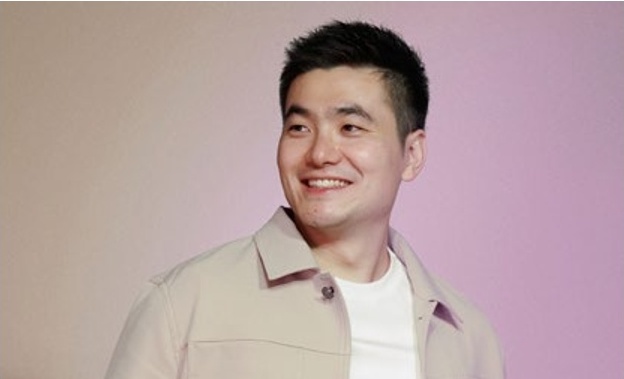
Weijie Sun
DP TECHNOLOGY
CHINA
BIOTECHNOLOGY & HEALTHCARE
DP Technology seeks to reduce the high cost associated with drug discovery through AI. The company uses quantum mechanics to develop algorithms that simulate how disease-causing proteins may work. Its partnerships with biopharma companies include Wuxi Biortus Biosciences and Hong Kong-listed Hansoh Pharmaceutical.
YEAR FOUNDED: 2018
CEO: Weijie Sun
KEY BACKERS: Baidu Ventures, Crystal Stream Capital, Hillhouse Capital, Matrix Partners China, Qiming Venture Partners, Source Code Capital, Vision Plus Capital
EASYTRANSFER
SINGAPORE
FINANCE
Founded by former international students, the fintech startup helps process tuition payments from overseas students. Easy-Transfer says it has serviced more than 250,000 students from over 30 countries since its founding. It has also developed an anti-money laundering platform, based on machine learning, that improves compliance reviews and fraud risk identification.
YEAR FOUNDED: 2013
CEO: Michael Shang
KEY BACKERS: IDG Capital, Taiyou Fund, ZhenFund

Gregory Van
ENDOWUS
SINGAPORE
FINANCE
Digital wealth platform Endowus provides investment advisory services and allows users to manage their private cash savings as well as contributions to Singapore’s Central Provident Fund. The startup is looking to expand to Hong Kong this year.
YEAR FOUNDED: 2017
CEO: Gregory Van
KEY BACKERS: Lightspeed Venture Partners, K3 Ventures, Prosus Ventures, Singtel Innov8, SoftBank Ventures Asia, UBS
ENTRYLEVEL
AUSTRALIA
EDUCATION & RECRUITMENT
Education startup EntryLevel’s mission is to reskill 1 billion people through online cohort-based programs. To join a six-week class, users pay a $99 bond, which is refunded when they graduate, or they can opt for premium perks like extra content. The startup says its course completion rate is up to 20 times that of competitors, such as Coursera or General Assembly.
YEAR FOUNDED: 2020
CEO: Ajay Prakash
KEY BACKERS: Blackbird Ventures, Possible Ventures, Startmate, TEN13
ETAILY
SINGAPORE
E-COMMERCE & RETAIL
Etaily aims to digitalize retail in Southeast Asia by helping stores embrace e-commerce. Its smart services for shops include tech support, operations, branding and data management. Led by former executives of online fashion retailer Zalora, Etaily claims its revenue growth increased eightfold in 2022.
YEAR FOUNDED: 2020
CEO: Alexander Friedhoff
KEY BACKERS: Ayala Ventures, Foxmont Capital Partners, Gobi Partners, JG Digital Equity Ventures
EULER MOTORS
INDIA
LOGISTICS & TRANSPORTATION
Euler Motors’ flagship product is an electric three-wheeler called HiLoad, which touts a driving range of up to 151km and can be charged within 15 minutes. The startup also operates its own charging network and an app that lets users monitor their vehicles.
YEAR FOUNDED: 2018
CEO: Saurav Kumar
KEY BACKERS: ADB Ventures, Blume Ventures, Jetty Ventures
FABLE FOOD
AUSTRALIA
FOOD & HOSPITALITY
Cofounded by a vegetarian, a fine-dining chef and an organic mushroom farmer, Fable Food offers a plant-based meat alternative made from shiitake mushrooms. The startup provides ready-to-eat meal boxes, such as “beef ” stroganoff and curry rice, and supplies food chains including Australia’s Grill’d Healthy Burgers.
YEAR FOUNDED: 2019
CEO: Michael Fox
KEY BACKERS: Blackbird Ventures, Grok Ventures
FANO LABS
HONG KONG
ENTERPRISE TECHNOLOGY
An AI startup spun off from the University of Hong Kong, Fano Labs specializes in speech recognition and natural language processing technologies. Its products help companies with their customer service, compliance and sales. The startup says it counts over 40 finance and telecoms companies and government bodies as customers.
YEAR FOUNDED: 2014
CEO: Miles Wen
KEY BACKERS: HKSTP, Horizons Ventures, Saltagen Ventures, University of Hong Kong
FINHAY
VIETNAM
FINANCE
Through its micro-investment and wealth management platform, Finhay aims to offer a one-stop shop for investors in Vietnam. The startup says its 2.7 million app users can start investing with as little as $2.20, improving financial inclusion. Finhay’s institutional partners include Dragon Capital and Malaysian bank CIMB Group.
YEAR FOUNDED: 2017
CEO: Huy Nghiem
KEY BACKERS: Insignia Ventures Partners, Openspace Ventures, Thien Viet Securities
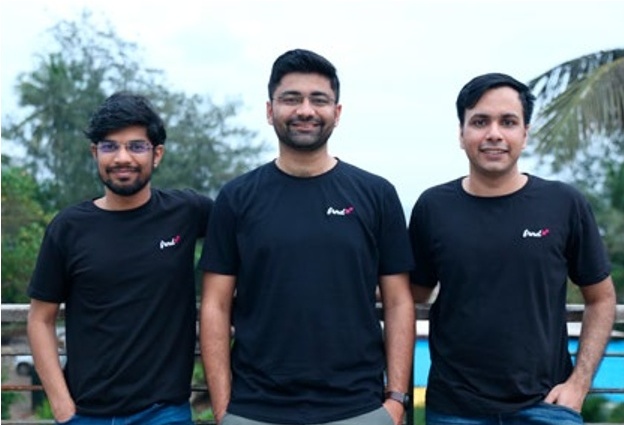
From left: FRND cofounders Hardik Bansal, Harshvardhan Chhangani and Bhanu Pratap Singh Tanwar
FRND
INDIA
CONSUMER TECHNOLOGY
Dating app FRND helps users connect while playing online games. To help break the ice, the company’s matchmakers kick-start audio-based conversations, which are designed to be fun—and safe—experiences. FRND says the app has been downloaded more than 5 million times, and has a rating of 4.2 out of 5 on Google Play.
YEAR FOUNDED: 2018
CEO: Bhanu Pratap Singh Tanwar
KEY BACKERS: Elevation Capital, India Quotient, Krafton
G-HCARE
CHINA
BIOTECHNOLOGY & HEALTHCARE
G-hcare works with Chinese insurers including China Life, China Taiping and Ping An to develop and sell tailored life and healthcare insurance products. It also provides add-on services such as healthcare consulting and insurance for overseas treatment, which its enterprise customers can then market to their users.
YEAR FOUNDED: 2018
CEO: James Chiu
KEY BACKERS: BAI Capital, CCV Capital, Unity Ventures
GENSE TECHNOLOGIES
HONG KONG
BIOTECHNOLOGY & HEALTHCARE
Gense Technologies aims to make medical checkups possible at home. The startup developed a medical-imaging device and accompanying app to identify diseases in the lungs, kidneys and liver at an early stage. The technology can also monitor chronic diseases affecting vital organs.
YEAR FOUNDED: 2017
CEO: Justin Chan
KEY BACKERS: Alibaba Entrepreneurs Fund, Hong Kong University of Science and Technology, ParticleX
GOKWIK
INDIA
E-COMMERCE & RETAIL
Launched during the pandemic, e-commerce startup GoKwik’s mission is to help direct-to-consumer brands and marketplaces increase their sales. Its AI and machine learning software assists online checkouts, automatically correcting addresses and confirming orders. The startup claims it has been used by over 250 brands, to help create more than $1 billion of gross merchandise value.
YEAR FOUNDED: 2020
CEO: Chirag Taneja
KEY BACKERS: Matrix Partners India, RTP Global, Sequoia India, Think Investments
GRAMHEET
INDIA
AGRICULTURE
GramHeet, a blend of two Marathi words that translates into “prosperity of the village,” aims to help India’s farmers store and profit from their harvests. Through its app, farmers can access GramHeet’s storage services, which the startup claims can increase the shelf life of grains by up to 12 months, and directly sell to buyers.
YEAR FOUNDED: 2020
CEO: Pankaj Prakash Mahalle
KEY BACKERS: Acumen, Indian Ministry of Agriculture & Farmers Welfare
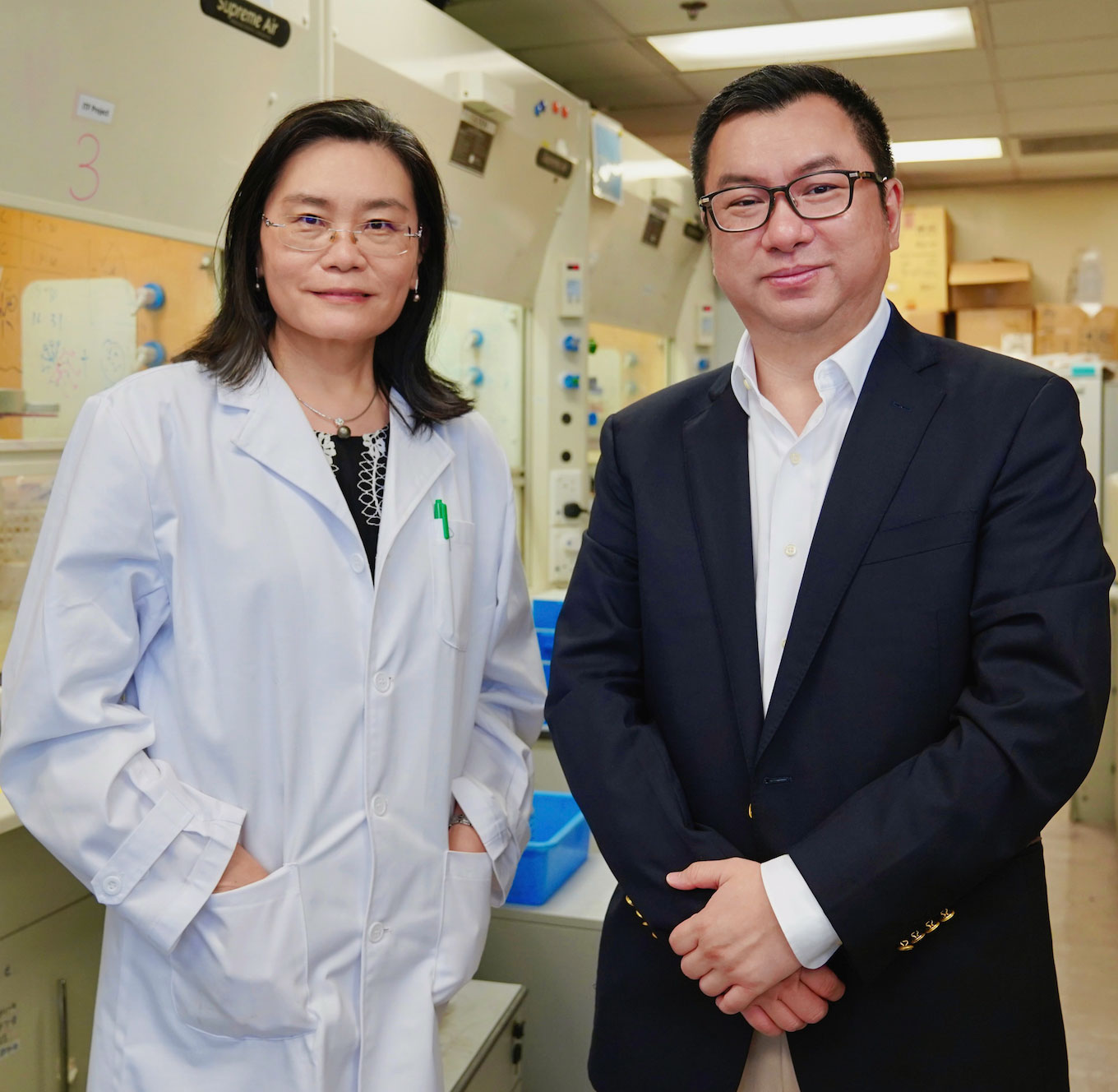
From left: Grand Rise Technology cofounders Pauline Li and Tenny Lam
GRAND RISE TECHNOLOGY
HONG KONG
BIOTECHNOLOGY & HEALTHCARE
Using proprietary nanotechnology, biotech startup Grand Rise Technology makes health and safety products derived from biodegradable materials, including crustacean shells and thyme. The startup’s InnoCoa- tex antimicrobial coating is applied to textiles like masks and wipes. It also makes an edible coating that can protect foods from germs and extend the shelf life of fruits. As sanitizing becomes the norm in the wake of the pandemic, Grand Rise Technology says its formulation is safer than that of commercial disinfectants.
YEAR FOUNDED: 2019
CEO: Tenny Lam
KEY BACKERS: HKSTP, Hong Kong Polytechnic University
GRIT BIOTECHNOLOGY
CHINA
BIOTECHNOLOGY & HEALTHCARE
Novel cell therapy company Grit Biotechnology seeks to treat cancer and tumors by enhancing lymphocytes, a type of immune system cell. The startup extracts and then cultivates a patient’s disease-fighting lymphocytes before re-injecting the modified cells. Grit Biotechnology says it entered clinical trials in China in April, having raised a total of $40 million.
YEAR FOUNDED: 2016
CEO: Yarong Liu
KEY BACKERS: Apricot Capital, Decheng Capital, Hillhouse Capital, Matrix Partners China, Sherpa Capital

Virtual influencer created by Gusto Collective
GUSTO COLLECTIVE
HONG KONG
ENTERTAINMENT & MEDIA
Gusto Collective is taking marketing to the next level, helping brands engage customers through metaverse technology, including virtual and augmented reality. In February, the startup partnered with auction house Phillips to launch an NFT. Gusto Collective says it has about 90 clients, including Sino Group and The Peninsula Hotels.
YEAR FOUNDED: 2020
CEO: Aaron Lau
KEY BACKERS: Animoca Brands, Gaw Capital
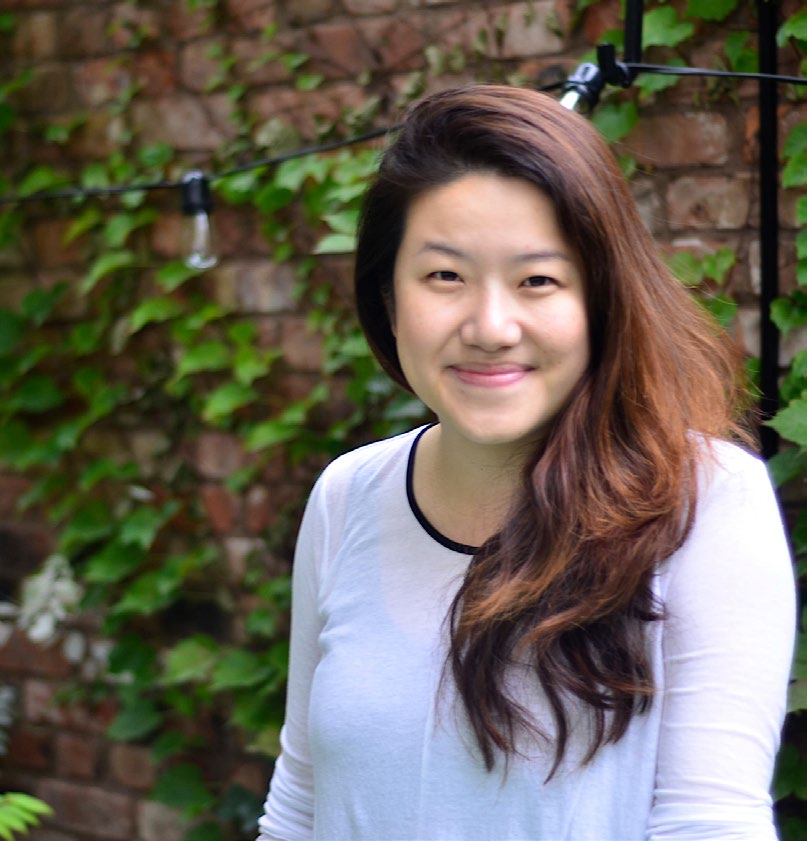
Gillian Tee

HOMAGE
SINGAPORE
BIOTECHNOLOGY & HEALTHCARE
Inspired by the founder’s experiences of struggling to find caregivers for her ill mother, Homage aims to help customers quickly obtain personalized medical support for their loved ones. The startup’s healthcare services platform caters to adults and the elderly, connecting households with licensed caregivers, nurses, therapists and physicians. It claims its network of over 10,000 care professionals has rendered over 1 million hours of services, including doctor consultations, in-home living assistance, rehabilitation and specialized treatment for conditions like Parkinson’s disease and dementia. Already available in Malaysia and Australia, Homage plans to expand in the region with its $30 million funding round in September.
YEAR FOUNDED: 2016
CEO: Gillian Tee
KEY BACKERS: East Ventures, Golden Gate Ventures, HealthXCapital, Temasek
HALTER
NEW ZEALAND
AGRICULTURE
Halter developed solar-powered, GPS-enabled electronic collars for cows. The collars use noise and vibration to direct cows without the need for farmhands, dogs or fences, allowing farmers to manage and monitor their herds remotely through Halter’s accompanying app. The startup says the app can save up to 20 hours of work a week.
YEAR FOUNDED: 2016
CEO: Craig Piggott
KEY BACKERS: Blackbird Ventures, DCVC, Icehouse Ventures, Promus Ventures
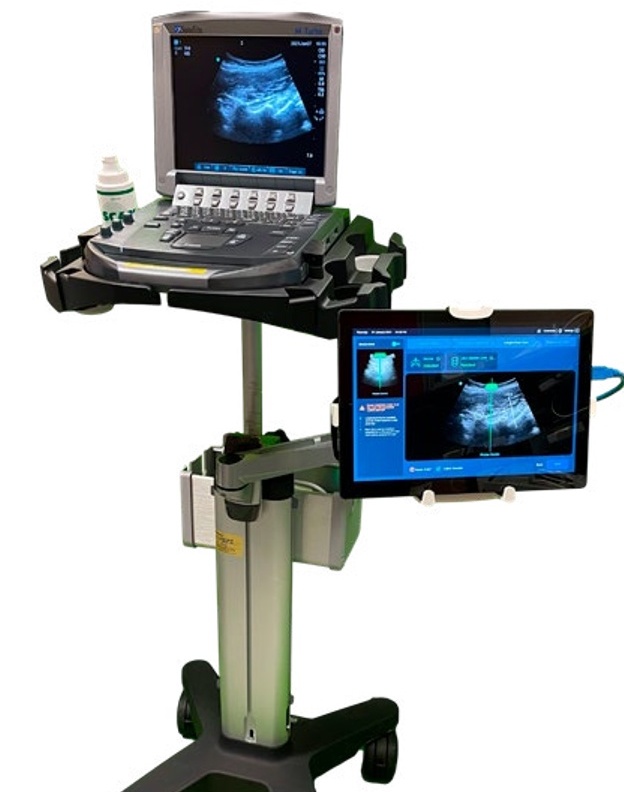
HICURA MEDICAL
SINGAPORE
BIOTECHNOLOGY & HEALTHCARE
Using ultrasound imaging and AI, HiCura Medical developed a device to help anesthetists administer an epidural more precisely to women in labor. The startup claims its technology improves the success rate for initial needle insertion.
YEAR FOUNDED: 2019
CEO: Cailin Ng
KEY BACKERS: Enterprise Singapore, National University of Singapore
HOLOMATIC
CHINA
LOGISTICS & TRANSPORTATION
Self-driving startup HoloMatic develops autonomous parking and autopiloting systems. Its HoloParking software can be enabled remotely from a user’s smartphone and guide cars into preferred parking spots. A strategic investor of the startup, China’s Guangzhou Automobile Group will use HoloMatic autonomous driving software in car models slated for market debut later this year.
YEAR FOUNDED: 2017
CEO: Kai Ni
KEY BACKERS: BAI Capital, GAC Capital, IDG Capital, Sequoia China
I2COOL
HONG KONG
CONSTRUCTION & ENGINEERING
I2Cool, a spin-off company from City University of Hong Kong, invented an exterior paint to cool down hot buildings. The startup’s iPaint reflects sunlight and dissipates thermal radiation to lower indoor temperatures without consuming energy.
YEAR FOUNDED: 2021
CEO: Martin Zhu
KEY BACKERS: China Prosperity Capital, City University of Hong Kong, HKSTP
I-KINGTEC
CHINA
ENTERPRISE TECHNOLOGY
IoT startup i-Kingtec develops industrial drones and related analytics software. The startup claims its Orca and Tiger Den drones are fully autonomous, with batteries that charge on return to a portable control platform. The drones’ uses include building inspections and emergency rescues.
YEAR FOUNDED: 2017
CEO: Fangping Chen
KEY BACKERS: Bluerun Ventures, Hongtai Capital, Suzhou Industrial Park

IGLOOCOMPANY
SINGAPORE
ENTERPRISE TECHNOLOGY
Igloocompany’s vision to “create a world without keys” underlies its smart access management products. Besides its smart locks for homes, the company helps businesses monitor, control and manage access to properties and facilities like data centers. The startup says it remotely serves over 400 enterprise customers and has issued 5 million digital credentials, as the pandemic spurred demand for contactless access.
YEAR FOUNDED: 2015
CEO: Anthony Chow
KEY BACKERS: EDBI, Insignia Ventures Partners, K3 Ventures, Kickstart Ventures, Wavemaker Partners
INTELLECT
SINGAPORE
BIOTECHNOLOGY & HEALTHCARE
Intellect provides a wide range of mental health services to workforces across Asia through its app. Employees can speak with behavioral health coaches and subscribe to self-guided programs. The startup, which has raised $23 million in funding, says it has connected 3 million people to mental health professionals across 20 countries.
YEAR FOUNDED: 2019
CEO: Theodoric Chew
KEY BACKERS: East Ventures, Headline, HOF Capital, Insignia Ventures Partners, JAFCO Asia, K3 Ventures, MS&AD Ventures, PERSOL Holdings, Singtel Innov8, Tiger Global, Y Combinator
INTELUCK
PHILIPPINES
LOGISTICS & TRANSPORTATION
The tech-driven logistics startup initially helped logistics companies track their vehicle fleets. Today, it facilitates first and mid mile delivery on its data-driven trucking platform. Clients include Coca-Cola, Nestle and billionaire Lucio Tan’s Asia Brewery. The company aims to expand into Vietnam and Indonesia next year.
YEAR FOUNDED: 2014
CEO: Kevin Zhang
KEY BACKERS: Creo Capital, East Ventures, MindWorks Capital

JIWA GROUP
INDONESIA
FOOD & HOSPITALITY
From a single coffee shop in 2018, Jiwa Group now manages three food and beverage chains, comprising over 1,000 outlets in more than 100 Indonesian cities. The company attributes its growth to collaborations with other brands, including those for cosmetics and apparel.
YEAR FOUNDED: 2018
CEO: Billy Kurniawan
KEY BACKERS: Capsquare Asia, Openspace Ventures
KARGO TECHNOLOGIES
INDONESIA
LOGISTICS & TRANSPORTATION
The Indonesia-based “Uber for trucks” startup Kargo Technologies is trying to bring down logistics costs by removing middlemen and reducing empty trips. The startup says it has 75,000 trucks and 30,000 shippers on its platform, serving small and midsized businesses and bigger clients like Coca-Cola, Danone and Ula.
YEAR FOUNDED: 2018
CEO: Tiger Fang
KEY BACKERS: AC Ventures, AirAsia Group, Intudo Ventures, Sequoia India, Tenaya Capital
KMONG
SOUTH KOREA
E-COMMERCE & RETAIL
Kmong is the largest online freelance marketplace in South Korea as measured by users, with over 1 million downloads on the Google Play store. In 2019, it launched an enterprise version of its platform that connects skilled freelancers with employers. The Seoul-based startup raised $28 million in series C funding in May last year.
YEAR FOUNDED: 2012
CEO: Hyeonho Park
KEY BACKERS: Altos Ventures, Company K Partners, IMM Investment, InterVest, Mirae Asset Venture Investment
LEAPSTACK
CHINA
FINANCE
Leapstack helps insurers in China control risks, using AI and big data-driven algorithms to calculate payments and detect potential abnormalities, such as excessive fees and fraudulent claims. Building on its total of $50 million in funding, the startup plans to expand outside mainland China—it’s already established offices in Vietnam and Hong Kong.
YEAR FOUNDED: 2016
CEO: Jason Liu
KEY BACKERS: 360 DigiTech, Danhua Capital, DCM, Fomou Assets, FinVolution Group, Gaorong Capital, Puhua Capital, Legend Capital, Lingfeng Capital, UpHonest Capital
LIFELAB
SOUTH KOREA
E-COMMERCE & RETAIL
Lifelab operates Cleaning Lab, one of the most popular house-cleaning apps in South Korea. The app, which connects cleaners with residents, has more than 1 million downloads in the Google Play store. The Seongnam-based startup is led by Hyunjoo Yeon, the former head of Kakao’s O2O home services business.
YEAR FOUNDED: 2016
CEO: Hyunjoo Yeon
KEY BACKERS: Altos Ventures, Daol Investment, Kakao Ventures
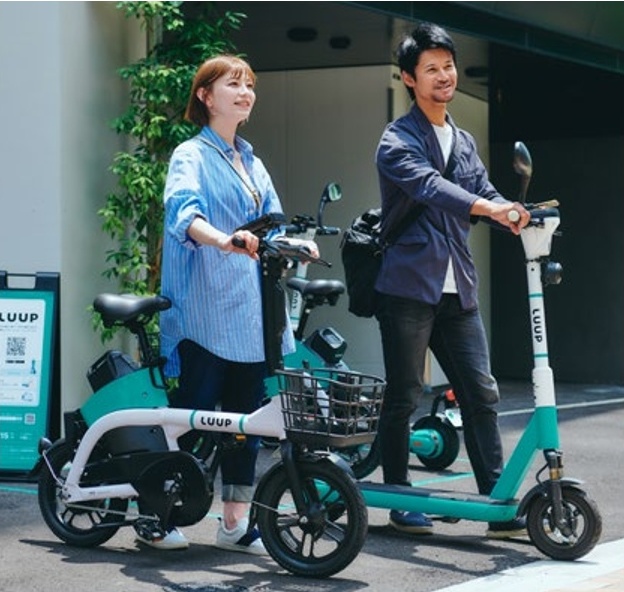
LUUP
JAPAN
LOGISTICS & TRANSPORTATION
Mobility startup Luup offers a sharing service for electric bikes and scooters. The startup says its 5,000 vehicles are available in the Japanese cities of Tokyo, Osaka, Kyoto, Sendai and Yokohama. Going forward, Luup plans to introduce rental options with three and four wheels, which will be more accessible to the elderly and people with disabilities.
YEAR FOUNDED: 2018
CEO: Daiki Okai
KEY BACKERS: ANRI, ENEOS Innovation Partners, East Ventures, FamilyMart, Obayashi Corporation, Mercuria Investment, Mori Trust, Spiral Capital, SMBC Venture Capital, Sankei Building
MAGNUM RESEARCH
HONG KONG
FINANCE
The startup’s AI-powered app, called Aqumon, provides automated financial services to retail and institutional investors. Magnum Research says its software leverages 100 terabytes of data from over 100,000 financial instruments. In October 2020, the fintech startup raised $30 million in a funding round.
YEAR FOUNDED: 2016
CEO: Kelvin Lei
KEY BACKERS: Alibaba Entrepreneurs Fund, Cyberport, Hong Kong University of Science and Technology, Lenovo Capital, Zheng He
MANATAL
THAILAND
EDUCATION & RECRUITMENT
Manatal’s AI-powered software helps HR professionals sift through the online profiles of job seekers and identify candidates who best fit the role. The cloud-based recruitment software developer also helps companies distribute job openings on platforms such as Careerjet, JobStreet and LinkedIn. The startup claims it has $5.1 million in funding.
YEAR FOUNDED: 2019
CEO: Jeremy Fichet
KEY BACKER: Sequoia India
MEDICI VIETNAM
VIETNAM
BIOTECHNOLOGY & HEALTHCARE
Combining medical services and insurance, Medici Vietnam aims to make high-quality healthcare “accessible, available and affordable for every Vietnamese.” The startup says its digital ecosystem encompasses doctors, hospitals and pharmaceutical companies in almost 40 provinces and cities.
YEAR FOUNDED: 2019
CEO: Ngo Duc Anh
KEY BACKERS: Insignia Ventures Partners, Jungle Ventures, Wavemaker Partners

Polin Hsu
MAGASSIST
CHINA
BIOTECHNOLOGY & HEALTHCARE
Medtech startup MagAssist’s ventricular assist device functions as a heart outside the human body, to provide life support to patients with critical heart failure. Called MoyoAssist, it uses magnetic levitation technology and computational models to ensure blood flow and prevent blood clots. In June, a hospital in China’s Shanxi Province used the device to successfully treat a patient in cardiac shock. A hospital in Wuhan in 2021 used it to provide life support to a patient waiting for heart surgery.
YEAR FOUNDED: 2017
CEO: Polin Hsu
KEY BACKERS: CDH Investments, Cenova Ventures, Guoqian Medical, Huatai Zijin Investment, Med-Fine Capital, Northern Light Venture Capital, Sequoia China, SND Ventures, TigerYeah Capital
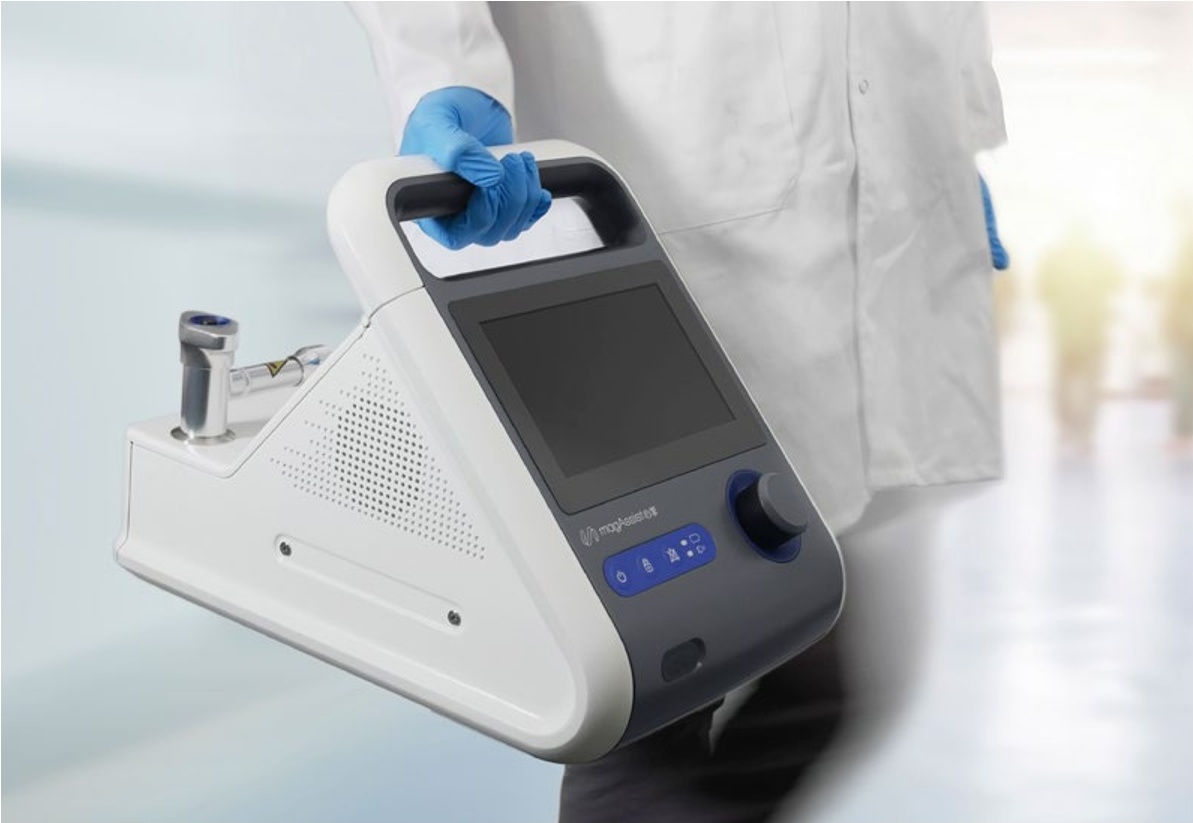
MoyoAssist

MERIDIAN INNOVATION
SINGAPORE
ENTERPRISE TECHNOLOGY
With its thermal imaging technologies, Meridian Innovation developed a line of low-cost thermal sensors. Its products are used in healthcare, transportation and smart home markets.
YEAR FOUNDED: 2016
CEO: Hock Leow
KEY BACKERS: Creative Technology, Excelpoint, HKSTP, Seeds Capital
MERKLE SCIENCE
SINGAPORE
ENTERPRISE TECHNOLOGY
Merkle Science develops compliance and risk monitoring software for the crypto industry. Its products can analyze transactions, flag risk and detect potential fraud.
YEAR FOUNDED: 2018
CEO: Mriganka Pattnaik
KEY BACKERS: Darrow Holdings, Fenbushi Capital, K3 Ventures, Uncorrelated Ventures
MOBIDOO
SOUTH KOREA
E-COMMERCE & RETAIL
Mobidoo is a one-stop live shopping platform. It operates an app called SauceLive, which allows companies to sell their products via livestream shopping. Mobidoo also provides software that analyzes customer behavior, including viewing time and purchase conversion, and livestream-support services, such as content planning and casting.
YEAR FOUNDED: 2013
CEO: David Lee
KEY BACKERS: Capstone Partners, FuturePlay, Lotte Ventures, Samsung Next, SparkLabs
MOMOS
SINGAPORE
FOOD & HOSPITALITY
Acting as a “mission control” for restaurateurs, Momos’ software helps restaurants digitalize their businesses. Launched in 2020, during the peak of the pandemic, the software-as-a-service startup now has 60 employees in four countries and says thousands of restaurants use its time-management tools and customer-response features.
YEAR FOUNDED: 2020
CEO: Sai Alluri
KEY BACKERS: Alpha Wave, HOF Capital, K3 Ventures, Sequoia India
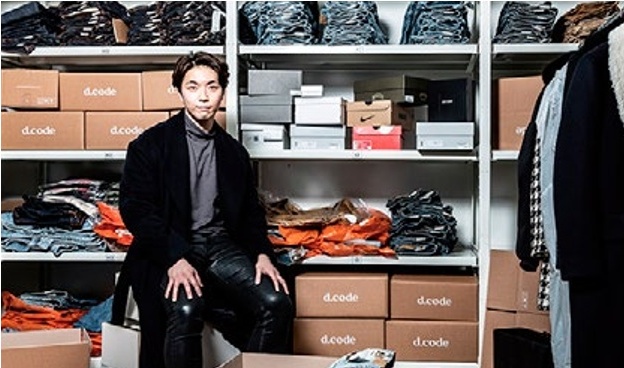
Jun Jung
N.CODE
SOUTH KOREA
E-COMMERCE & RETAIL
N.Code is trying to solve one of the luxury fashion industry’s biggest problems: unsold inventory. Its platform, called D.Code, allows users to pre-order luxury items so that brands can better forecast demand, thereby reducing unwanted items.
YEAR FOUNDED: 2015
CEO: Jun Jung
KEY BACKERS: Coolidge Corner Investment, MashUp Angels, Shinhan Venture Investment
NEWBANKER
CHINA
FINANCE
NewBanker taps into China’s growing demand for wealth management products. It develops online marketing and consulting software for financial institutions such as banks, public funds and securities companies. According to its website, the startup works with dozens of top funds in China including China Merchants Fund Management and Harvest Fund Management.
YEAR FOUNDED: 2016
CEO: Qinghao Li
KEY BACKERS: Ant Group, Atlas Capital, CICC Capital, Genesis Capital, MindWorks Capital, Matrix Partners China
NOVELSHIP
SINGAPORE
E-COMMERCE & RETAIL
Novelship operates an online marketplace for limited-edition sneakers, streetwear and other collectibles such as electronics and figurines. The startup claims to have a user base of half a million across the Asia-Pacific, including Singapore, Australia, Indonesia and Malaysia.
YEAR FOUNDED: 2018
CEO: Richard Xi
KEY BACKERS: East Ventures, GSR Ventures, K3 Ventures
ONEDEGREE
HONG KONG
FINANCE
The insurtech startup’s first product was Pawfect Care, offering pet owners insurance for their cats or dogs. Since then, OneDegree, which is one of four virtual insurers in Hong Kong, has expanded into home and fire insurance, as well as digital asset insurance. The startup raised $28 million in an August 2021 funding round.
YEAR FOUNDED: 2016
CEO: Alvin Kwock
KEY BACKERS: Alibaba Entrepreneurs Fund, BitRock Capital, Cathay Venture, Cyberport, Sun Hung Kai & Co.
OPHARMIC TECHNOLOGY
HONG KONG
BIOTECHNOLOGY & HEALTHCARE
Founded by Langston Suen, a Ph.D. graduate of Hong Kong University of Science and Technology, Opharmic Technology is replacing needle injections for treatment of retinal disease with ultrasound technology. The company invented drug delivery technology that uses ultrasound to speed up the absorption of drugs administered to the sclera (or white part) of the eye.
YEAR FOUNDED: 2016
CEO: Langston Suen
KEY BACKERS: HKSTP, Hong Kong University of Science and Technology, Pentepebble, Sino Group
PARK+
INDIA
LOGISTICS & TRANSPORTATION
Park+ started as a platform that helped users find nearby parking spaces. It has since expanded into multiple auto-related services such as car washing, insurance and toll payment. It also provides corporate clients with real-time parking data, allowing them to manage parking spaces.
YEAR FOUNDED: 2019
CEO: Amit Lakhotia
KEY BACKERS: Epiq Capital, Matrix Partners India, Sequoia India
PARTLY
NEW ZEALAND
ENTERPRISE TECHNOLOGY
Partly helps businesses throughout the auto-parts supply chain to organize their data online. Its software solutions include PartsPal, an inventory management tool that can manage compatibility data and connect to e-commerce platforms. With a total of $3.8 million in funding, the startup says its services reach 20 markets worldwide.
YEAR FOUNDED: 2020
CEO: Levi Fawcett
KEY BACKERS: Blackbird Ventures, Hillfarrance Venture Capital, I2BF Global Ventures, Icehouse Ventures

PAYHERE
SOUTH KOREA
FINANCE
Payhere operates cloud-based software and an app that uses a customer’s smartphone camera to transact payments without expensive point-of-sale terminals. More than 20,000 brick-and-mortar stores in South Korea use Payhere, according to the startup’s website. In March, it raised about $9 million in series A funding.
YEAR FOUNDED: 2019
CEO: Jungi Park
KEY BACKERS: Hashed, Kimgisa Lab, Mirae Asset Capital, Postech Holdings, SoftBank Ventures Asia
PEOPLEFUND
SOUTH KOREA
FINANCE
The fintech startup operates a peer-to-peer lending platform focused on South Korean subprime borrowers, whose household debt ranks among the world’s highest. PeopleFund says it has a low delinquency rate, thanks to its AI-powered credit-scoring system. The startup has raised about $80 million in funding, including a $63 million series C round in December.
YEAR FOUNDED: 2015
CEO: Joey Kim
KEY BACKERS: 500 Global, Bain Capital, CLSA Capital Partners, D3 Jubilee Partners, Goldman Sachs, Kakao Pay
PLASK
SOUTH KOREA
ENTERTAINMENT & MEDIA
Plask’s AI-powered tool enables even novices to create animations for games and video content using just a webcam. The startup’s software turns a person’s movement captured through a webcam into motion data and automates most of the animation work.
YEAR FOUNDED: 2020
CEO: Junho Lee
KEY BACKERS: Bigbang Angels, KT Investment, Naver, Smilegate Investment, SpringCamp, Timewise investment
POCKET FM
INDIA
ENTERTAINMENT & MEDIA
Audio streaming startup Pocket FM aims to build an entirely personalized, seamless platform for audiobook and podcast content. The startup claims its app features more than 100,000 hours of content in eight Indian languages, drawing over 15 million monthly active users.
YEAR FOUNDED: 2018
CEO: Rohan Nayak
KEY BACKERS: Goodwater Capital, Lightspeed Venture Partners, Naver, Tanglin Venture Partners
POINT FIT TECHNOLOGY
HONG KONG
BIOTECHNOLOGY & HEALTHCARE
Point Fit Technology developed a skin patch that aims to replace invasive blood tests. The patch analyzes chemicals in sweat to monitor health, such as lactic acid for athletes and glucose levels for elderly people. The startup’s technology in July won the top prize at a business proposal contest sponsored by Japanese sporting goods company Asics.
YEAR FOUNDED: 2020
CEO: Kenny Oktavius
KEY BACKERS: HKSTP, Hong Kong University of Science and Technology
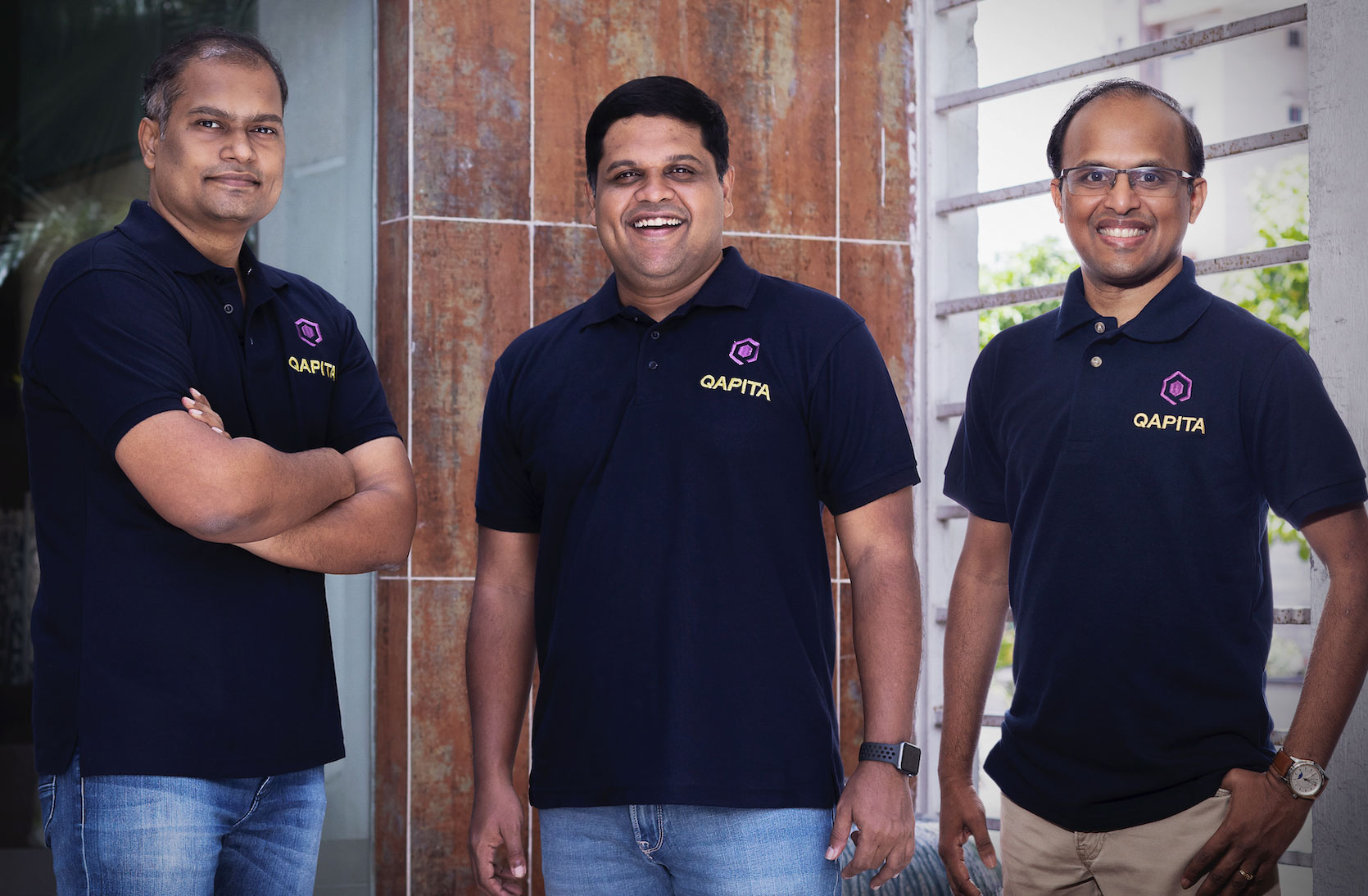
From left: Qapita cofounders Vamsee Mohan Kamabathula, Ravi Ravulaparthi and Lakshman Gupta Kanamarlapudi
QAPITA
SINGAPORE
FINANCE
Qapita automates equity ownership management for companies through its capitalization table and employee stock ownership plans (ESOP) management software. The startup says more than 700 customers and 22,000 stakeholders across Singapore, India and Indonesia use its software. Qapita has raised more than $32 million in funding.
YEAR FOUNDED: 2019
CEO: Ravi Ravulaparthi
KEY BACKERS: Alto Partners, East Ventures, Endiya Partners, K3 Ventures, MassMutual Ventures, NYCA Partners, Vulcan Capital
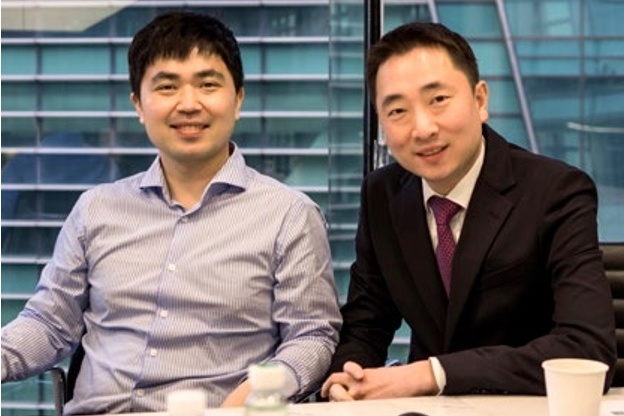
From left: Quad Miners cofounders Dennis Hong and Ven Park
QUAD MINERS
SOUTH KOREA
ENTERPRISE TECHNOLOGY
The cybersecurity company’s software products can detect security threats, such as internal leakage, and analyze abnormal network behavior. Quad Miners chief technology officer Felix Kim was previously a security consultant at Cisco and a security engineer at Symantec (now known as NortonLifeLock). The startup raised about $6.5 million in series A funding in June.
YEAR FOUNDED: 2017
CEO: Ven Park
KEY BACKERS: Bigbang Angels, Korea Credit Guarantee Fund, L&S Venture Capital, NAU IB Capital, Partners Investment
REMO TECH
CHINA
CONSUMER TECHNOLOGY
Remo Tech’s cameras use AI-powered chips to track movement in front of the lens, from gesture controls to dance moves. The company claims it has secured over 100 patents. Best known for its Obsbot line of smart webcams and phone mounts, the company sells the cameras primarily in Europe, Japan and the U.S.
YEAR FOUNDED: 2016
CEO: Bo Liu
KEY BACKERS: Bohai Industrial Investment Fund Management, Forebright Capital, Sequoia China
SECURE CODE WARRIOR
AUSTRALIA
ENTERPRISE TECHNOLOGY
Cybersecurity startup Secure Code Warrior provides training, consulting and assessment services to developers so that they can write secure code. The company says it has worked with more than 400 organizations worldwide. Its clients include Atlassian, DBS and Zoom.
YEAR FOUNDED: 2015
CEO: Pieter Danhieux
KEY BACKERS: AirTree Ventures, Goldman Sachs, Paladin Capital Group
SEHAT KAHANI
PAKISTAN
BIOTECHNOLOGY & HEALTHCARE
Founded by two medical doctors, Sehat Kahani’s platform provides telemedicine services by connecting patients in remote regions with doctors. According to the startup, more than half of Pakistan’s 220 million population lack access to quality healthcare. Sehat Kahani says its platform has facilitated 1.2 million medical consultations to date with 800 medical experts.
YEAR FOUNDED: 2019
CEO: Sara Saeed Khurram
KEY BACKERS: 10Pearls Ventures, Elahi Group, Impact Investment Exchange, Islamic Development Bank
SHANGHAI DEEPSIGHT INFORMATION TECHNOLOGY
CHINA
ENTERPRISE TECHNOLOGY
Led by former Intel computer vision scientist Michael Li, DeepSight taps into the growing need for faster and automated quality inspection at Chinese factories. The startup’s AI software identifies potentially defective items, alerting manufacturers to problems such as scratches and dirt spots on metals, tires and small electronic parts.
YEAR FOUNDED: 2017
CEO: Michael Li
KEY BACKERS: CCV Capital, Chenhui Venture Partners, Shunwei Capital, SND Financial Holdings, Zizhu National High-Tech Industrial Development Park
SHIKHO
BANGLADESH
EDUCATION & RECRUITMENT
Cofounded by a graduate of University College London’s education school, Shikho is a tutoring platform that prepares students for Bangladesh’s high school exams through live lectures, online mock tests, notes and animations. The startup estimates it has 500,000 daily users.
YEAR FOUNDED: 2019
CEO: Shahir Chowdhury
KEY BACKERS: DSG Consumer Partners, Learn Capital, Wavemaker Partners

SEOUL ROBOTICS
SOUTH KOREA
LOGISTICS & TRANSPORTATION
Aiming to become the Microsoft of lidar, Seoul Robotics is expanding the use of the laser-based technology beyond autonomous driving. Its software, called Sensr, uses AI to analyze lidar data to detect, classify and track objects and people for industrial operations, smart city infrastructure, security and retail, among other applications. Seoul Robotics says Sensr is currently used to monitor pedestrian safety and detect obstacles on roads. Its clients include German carmakers BMW—which is using the software to automate fleet logistics at a manufacturing plant—and Mercedes-Benz. The startup also partnered with Nasdaq-listed Velodyne Lidar, backed by Amazon, to develop office monitoring tech for Qualcomm.
YEAR FOUNDED: 2017
CEO: Hanbin Lee
KEY BACKERS: KB Investment, Korea Development Bank
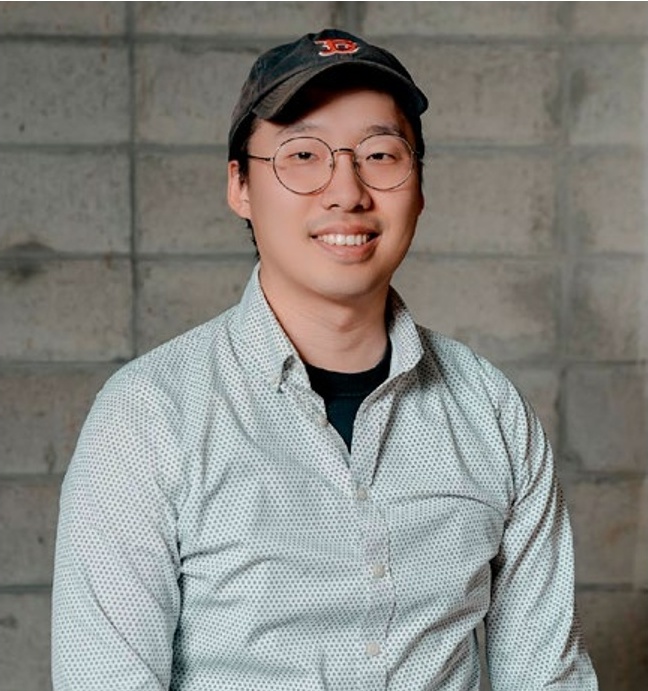

Hanbin Lee
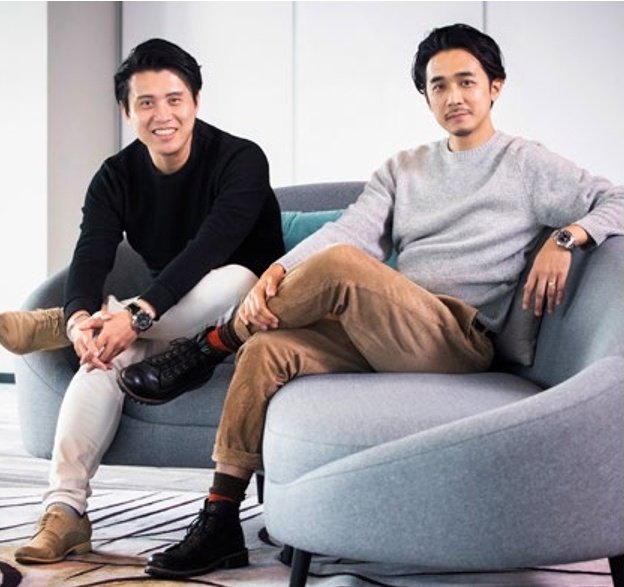
From left: Spaceship cofounders Wun Chi Lam and Stanley Wong
SPACESHIP
HONG KONG
LOGISTICS & TRANSPORTATION
Spaceship’s logistics and supply-chain management system covers first-mile logistics, cross-border shipping, fulfillment services and last-mile delivery. The startup, which expanded into Taiwan in March, says it has processed more than 2.5 million item shipments to date. Spaceship has raised more than $6 million in funding so far, including a funding round in May.
YEAR FOUNDED: 2019
CEO: Wun Chi Lam
KEY BACKERS: 500 Global, HKSTP, Paragon Investment, ParticleX, SparkLabs Taipei
TARTANSENSE
INDIA
AGRICULTURE
Armed with an electrical and computer engineering degree from Carnegie Mellon University, Jaisimha Rao is using AI and robotic technologies to make farmers’ lives easier. His agtech startup says it has developed a precision-spraying system that can reduce water and chemical usage by up to 70%. Another AI-powered product is claimed to help farmers remove weeds without using chemicals.
YEAR FOUNDED: 2015
CEO: Jaisimha Rao
KEY BACKERS: Beenext, Blume Ventures, FMC Ventures, Omnivore
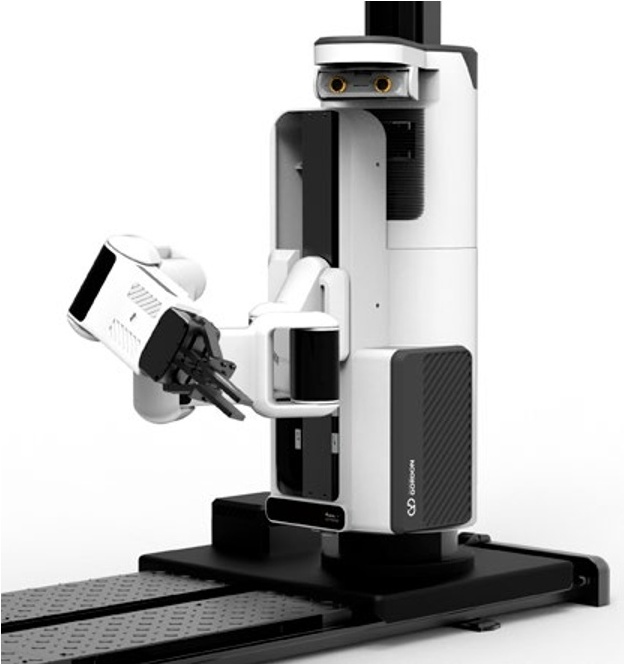
TX Scara
TELEXISTENCE
JAPAN
CONSTRUCTION & ENGINEERING
AI and robotics startup Telexistence developed TX Scara, a robotic arm that automatically replenishes empty store shelves. The device can be controlled remotely by staff equipped with VR helmets. Japanese convenience store chain FamilyMart uses TX Scara devices to restock canned beverages, according to the startup.
YEAR FOUNDED: 2017
CEO: Jin Tomioka
KEY BACKERS: Airbus Ventures, KDDI Open Innovation Fund, Monoful, Softbank Group, University of Tokyo
THE PARENTINC
SINGAPORE
E-COMMERCE & RETAIL
The Parentinc is best known for its community platform, theAsianparent, that provides content related to parenting and pregnancy in 11 languages across 12 countries, it says. The company also sells halal nursing and baby-care products, such as massage oil and stretch mark cream under the Mama’s Choice brand.
YEAR FOUNDED: 2009
CEO: Roshni Mahtani Cheung
KEY BACKERS: Central Retail Corporation, East Ventures, Fosun International, WHG Holdings
THRIDAY
AUSTRALIA
FINANCE
Thriday, formerly known as Thrive, is an accounting app that manages finances for small businesses. It automates bookkeeping by scanning receipts and estimating taxes, among other functions. CEO Michael Nuciforo was previously the head of mobile at Lloyds Banking Group and senior mobile banking manager at ANZ.
YEAR FOUNDED: 2021
CEO: Michael Nuciforo
KEY BACKER: AfterWork Ventures
TOSS LAB
SOUTH KOREA
ENTERPRISE TECHNOLOGY
Aiming to become the Slack of Asia, Toss Lab’s workplace-collaboration tool, Jandi, is available in Korean, Chinese, Japanese and Vietnamese as well as English. The startup says its customers include Lotte Department Store, Korean furniture maker Hanssem and LG CNS, LG Group’s IT services unit. Toss Lab raised $13 million in series B funding in 2020.
YEAR FOUNDED: 2014
CEO: Matt Kim
KEY BACKERS: Atinum Investment, Must Asset Management, Qualcomm Ventures, SBI Investment Korea, Shinhan Capital, SoftBank Ventures Asia, SparkLabs, TInvestment
UBIE
JAPAN
BIOTECHNOLOGY & HEALTHCARE
Ubie’s AI-powered app helps users identify their medical conditions, from diabetes to congestive heart failure, based on symptoms filled out in a questionnaire. The startup says it’s attracted 5 million monthly users in Japan. It seeks fresh growth in the U.S., where it officially launched its services in April.
YEAR FOUNDED: 2017
CEOs: Yoshinori Abe, Kota Kubo
KEY BACKERS: D4V, K4 Ventures, SBI Investment, Suzuken
UNA BRANDS
SINGAPORE
E-COMMERCE & RETAIL
The e-commerce aggregator acquires local brands with the aim of growing them into regional players using its growth capital and retail expertise. To date, it has bought more than 20 companies, including Singaporean ergonomic furniture brands ErgoTune and EverDesk+. In March, Una Brands announced a partnership with KlickBrands to expand its presence in South Korea.
YEAR FOUNDED: 2020
CEO: Kiren Tanna
KEY BACKERS: 468 Capital, 500 Global, Alpha JWC Ventures, Claret Capital Partners, Global Founders Capital, Kingsway Capital, White Star Capital
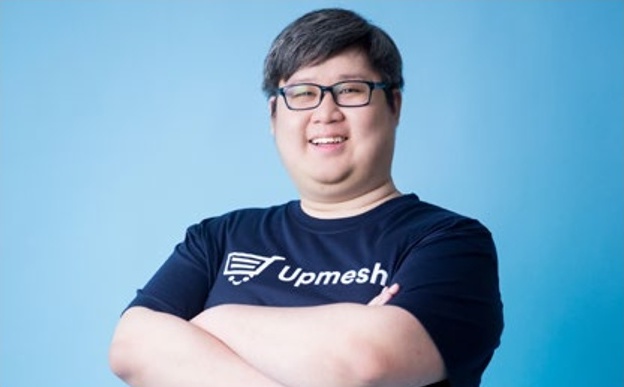
Wong Zi Yang
UPMESH
SINGAPORE
E-COMMERCE & RETAIL
Upmesh aims to reinvent shopping by merging retail and entertainment. Its platform helps merchants sell products through livestreams on Facebook and Instagram Live, managing orders in real-time. Online sellers can send checkout links to viewers who comment during livestreams and view analytics about bestselling items or user behavior.
YEAR FOUNDED: 2019
CEO: Wong Zi Yang
KEY BACKERS: Beenext, Monk’s Hill Ventures
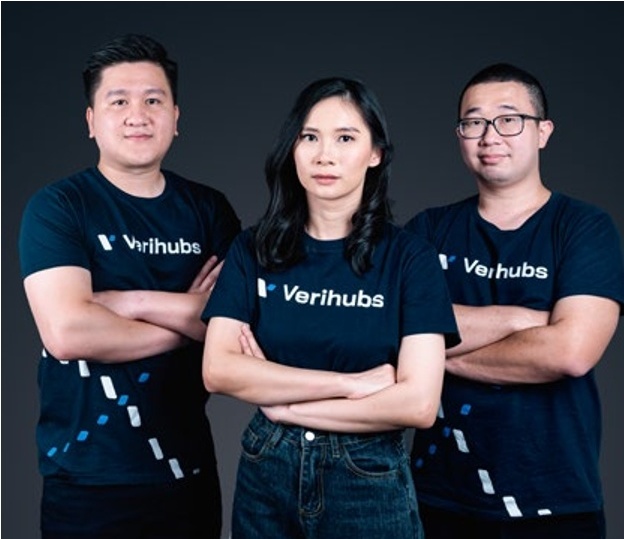
From left: Verihubs CEO, Rick Firnando, COO Vivi Mandasari and CTO Williem Williem
VERIHUBS
INDONESIA
ENTERPRISE TECHNOLOGY
Verification platform Verihubs uses AI-based authentication technology to prevent financial fraud. Counting clients such as one of Indonesia’s largest banks, Bank Central Asia, and e-commerce firm Bukalapak, the startup says it authenticated over 36 million users in the past year, with its revenue growing by 50 times over that period.
YEAR FOUNDED: 2019
CEO: Rick Firnando
KEY BACKERS: Insignia Ventures Partners, Number Capital, Y Combinator
VESTA
CHINA
E-COMMERCE & RETAIL
Vesta makes bed linen with eco-friendly materials such as silk, bamboo fiber and recycled PET plastic. These materials allow the company to design blankets and pillows that it claims help regulate body temperature by improving airflow and directing heat away from the body. The startup says it makes most of its money through sales outside of China, with customers in Australia, Canada, Singapore and the U.S.
YEAR FOUNDED: 2020
CEO: Gu Zhenyu
KEY BACKERS: K2VC, Sequoia China, Tiantu Capital
VFLOWTECH
SINGAPORE
CONSTRUCTION & ENGINEERING
As the world turns to renewable energy, VFlowTech aims to develop the cheapest and most scalable vanadium redox flow (V-flow) batteries. The startup says its energy-storage system has an expected lifespan of 25 years with low cost of ownership, thereby avoiding the potential pitfalls of large-scale applications of lithium-ion batteries.
YEAR FOUNDED: 2018
CEO: Avishek Kumar
KEY BACKERS: Enterprise Singapore, Sing Fuels, Wavemaker Partners

VIACT
HONG KONG
CONSTRUCTION & ENGINEERING
ViAct’s AI-powered software helps identify dangerous behavior and environmental risks at construction sites through video cameras. Using light and sound to alert construction workers, ViAct says its software can reduce up to 95% of on-site accidents. It can also track construction progress and carbon emissions.
YEAR FOUNDED: 2016
CEO: Gary Ng
KEY BACKERS: Key backers: Alibaba Entrepreneurs Fund, Artesian, HKSTP, ParticleX, SOSV, Vectr Ventures
VOW
AUSTRALIA
FOOD & HOSPITALITY
The foodtech startup produces lab-grown meat from animal cells, including traditional meats like chicken and beef and more exotic fare like lions and tigers. Vow built its first cultivated meat factory in Sydney in July and is preparing to launch a quail product in Singapore later this year. Vow has raised about $14 million in funding.
YEAR FOUNDED: 2019
CEO: George Peppou
KEY BACKERS: Blackbird, Grok Ventures, Square Peg Capital, Toyota Ventures
WAD
SOUTH KOREA
FOOD & HOSPITALITY
WAD operates a real-time restaurant reservation platform called CatchTable. According to the startup, the platform hosts about 3,000 restaurants throughout South Korea. Users can also write and read restaurant reviews. In April, WAD raised 30 billion won (about $25 million) in series C funding.
YEAR FOUNDED: 2017
CEO: Yong Tae-soon
KEY BACKERS: Altos Ventures, DSC Investment, InterVest
WORKMATE
SINGAPORE
EDUCATION & RECRUITMENT
Formerly known as Helpster, Workmate connects gig workers with companies in sectors ranging from hospitality to logistics. The startup has offices in Bangkok, Jakarta and Singapore.
YEAR FOUNDED: 2016
CEO: Mathew Ward
KEY BACKERS: Atlas Venture, Gobi Partners, Wavemaker Partners
COURTESY OF AGROSTAR; COURTESY OF ASTRO TECHNOLOGIES; COURTESY OF ATOM SEMICONDUCTOR; COURTESY OF BARAJA; COURTESY OF BIFROST FANG YAN FOR FORBES ASIA; COURTESY OF ENDOWUS COURTESY OF FRND; COURTESY OF GRAND RISE TECHNOLOGY; COURTESY OF GUSTO COLLECTIVE; COURTESY OF HOMAGE; COURTESY OF HICURA MEDICAL; COURTESY OF IGLOO; COURTESY OF JIWA GROUP; COURTESY OF LUUP; COURTESY OF MAGASSIST; COURTESY OF MERIDIAN INNOVATION; COURTESY OF N.CODE; COURTESY OF PAYHERE; COURTESY OF POINT FIT TECHNOLOGY; COURTESY OF QAPITA; COURTESY OF QUAD MINERS; COURTESY OF SEOUL ROBOTICS; COURTESY OF SPACESHIP; COURTESY OF TELEXISTENCE; COURTESY OF UPMESH; COURTESY OF VERIHUBS; COURTESY OF VIACT
THE LIST

By the Numbers
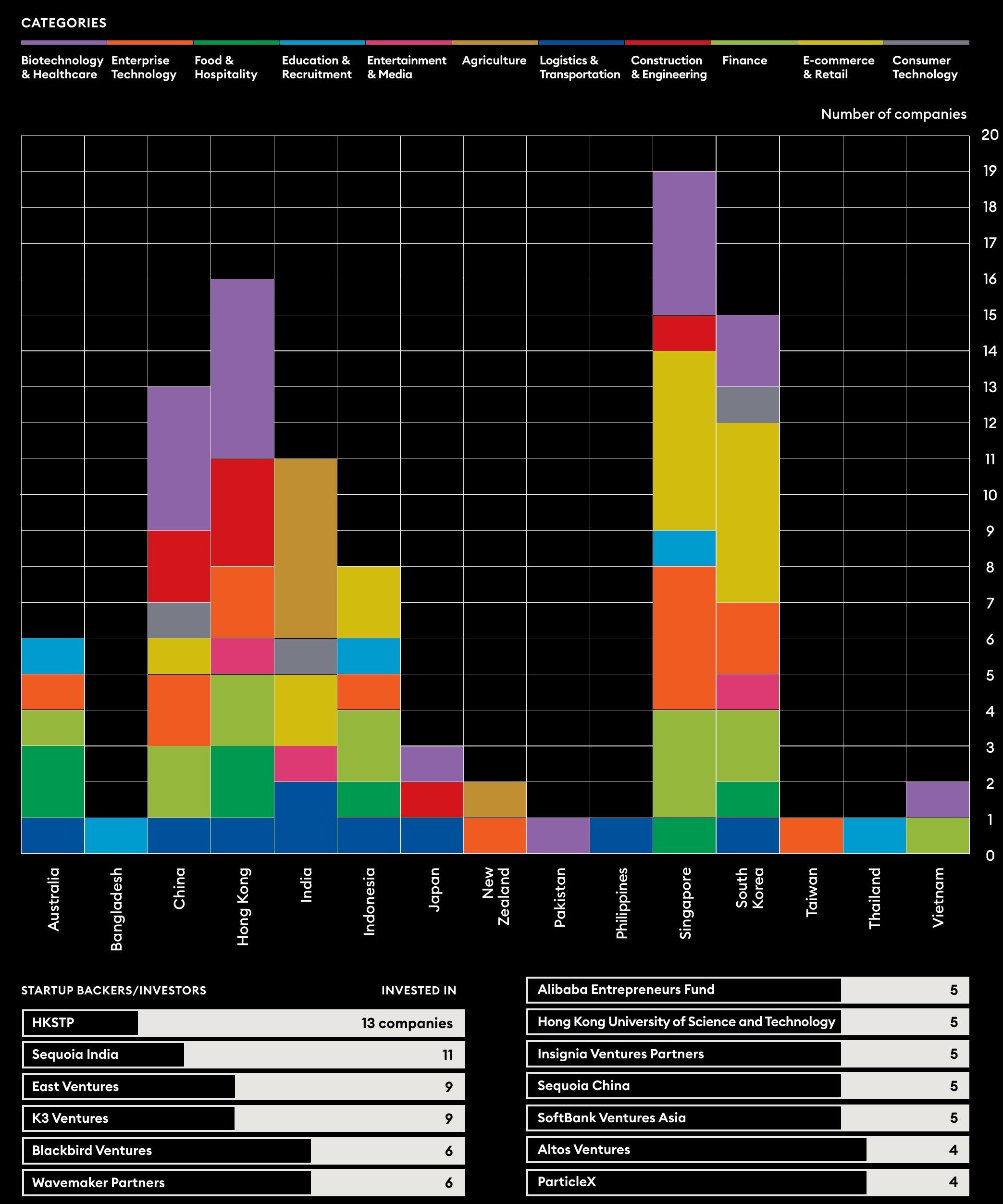









• ENTREPRENEURS •
Space Race
Trained as an engineer, JAMES YENBAMROONG cut his teeth at defense giant Northrop Grumman before launching his own satellite company in Thailand. Mu Space is burning through capital to get his vision off the ground.
By Ron Gluckman

Artist's rendering of the mu-B200 satellite.
The largest private satellite research and assembly center in Southeast Asia can be found on a busy frontage road parallel to Bangkok’s six-lane Don Muang tollway, tucked between a tractor dealer and an empty lot. It's early December 2021, and inside Factory 1, an ultramod 2,202-square-meter hanger, jeans-clad James Yenbamroong, founder and CEO of Thai aerospace manufacturing firm mu Space, takes to the stage to talk robotics, remote space machinery and power systems to the press and potential investors.
Projected on a screen behind him is the undeniable star of the show, artist's renderings of the mu-B200—Thailand’s first in-house-designed commercial satellite that the five-year-old company hopes to build and put into orbit by early 2023. It's an ambitious, if not a little improbable, bet for the soft-spoken 38-year-old, who has raised millions of dollars from investors banking that his firm will do just that.
Its success could open a pipeline of orders for the customizable 200kg satellite for low-Earth orbit payloads (like Earth observation, disaster prevention and weather monitoring) that has a build time of 12 months and a $4 million price tag—about half that of its competitors, the firm says. At a minimum, mu Space’s ability to make parts on-site has the potential to bridge the gap with Western suppliers and create a spacetech supply chain in Southeast Asia.
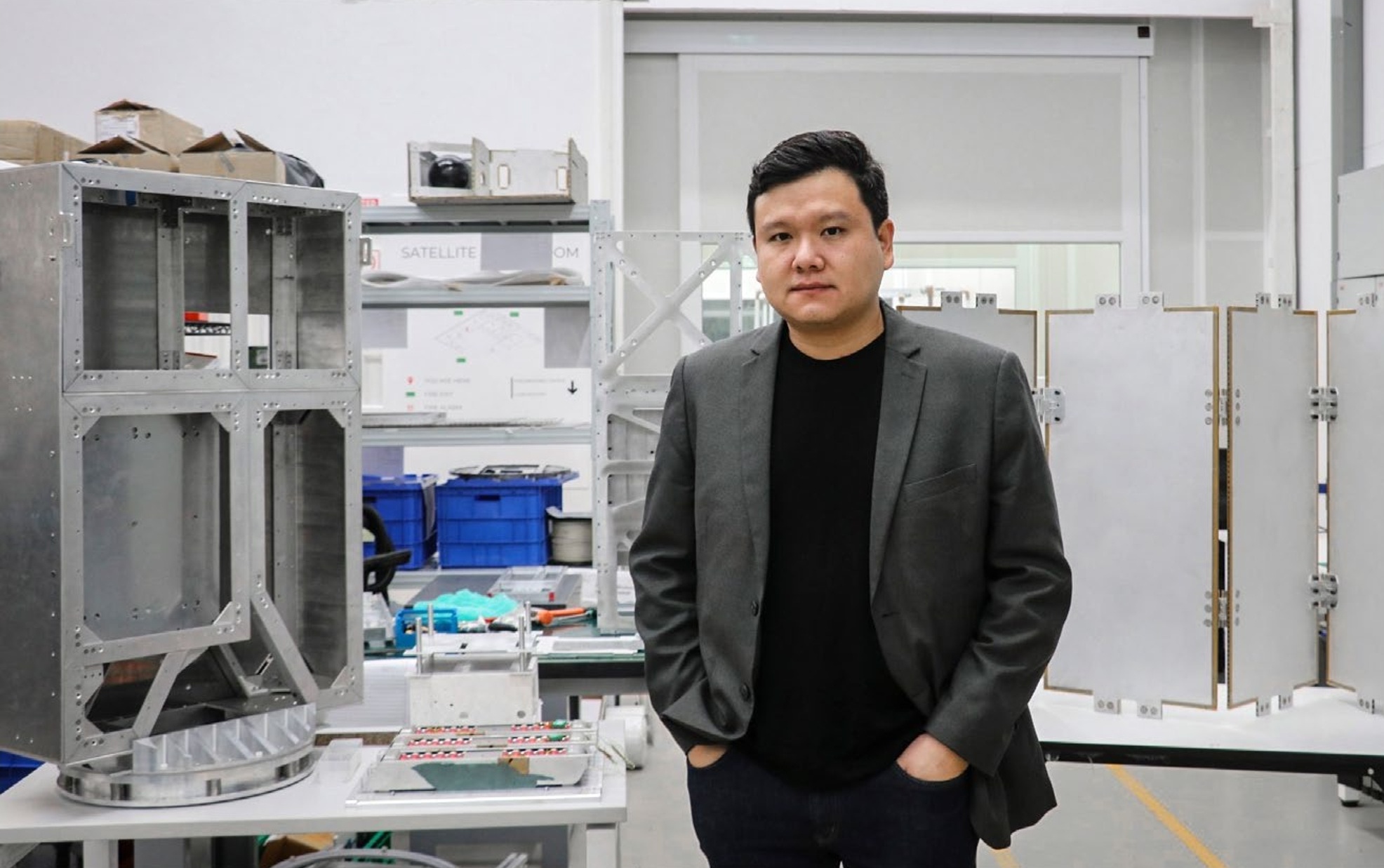
James Yenbamroong inside mu Space's Factory 1 in Bangkok.
A few months later at mu Space’s head office, flanked by models of rockets and astronauts, Yenbamroong extols his underdog advantage. “Companies are looking at alternatives to being dependent on China, especially now,” he says, noting current geopolitical strains between space powers America, China and Russia.
Additionally, pandemic-fueled supply chain disruptions have limited shipments from China, including batteries and sophisticated hardware demanded by the aerospace industry. “That definitely gives us an advantage, being here in Asia,” he says. “Also, everyone in this industry is looking for a reliable supplier that will protect their intellectual property.”
Mu Space made its first splash in 2018 when it put a modest 8kg payload into space atop New Shepard, a new rocket from Jeff Bezos’ Blue Origin. The payload, with experiments from local universities, was the spaceflight firm’s first Thai client. A second Blue Origin launch followed, then a third at the end of 2019. A year later, mu Space expanded to a payload of computers and electronics to test how its data systems would operate in space as it got its spacetech production facilities up and running. It’s currently selling space on the mu-B200, with the launch date dependent on those commitments.
WITHIN A FEW YEARS, YENBAMROONG EXPECTS THAT THE PRIVATELY FUNDED COMPANY WILL SEND AS MANY AS 10 CUSTOM-DESIGNED SATELLITES INTO SPACE A YEAR.
Projecting a satellite image on a computer screen and blasting a real one into space aren’t the same things. With investments in infrastructure, technology and manufacturing capability, mu Space is burning through capital. Yenbamroong expects to take in between $10 million and $20 million in revenue this year—thanks to contracts to design and test telecoms equipment as well as satellite-monitoring services—while expenditures are estimated at over $30 million. “We’ll probably not make a profit for five to ten years,” he says.
By then, if all goes according to plan, mu Space will have scaled up from its first generation of satellites. “This is just the start,” says Yenbamroong, who is also the startup’s chief technology officer. Within a few years, Yenbamroong expects that the privately funded company will send as many as 10 custom-designed satellites into space a year, and beyond that, mass produce hundreds satellites as well as its parts and power systems annually from one of his Bangkok factories (there are three currently). Like other, bigger, players in the private space industry, such as Elon Musk’s SpaceX and Richard Branson’s Virgin Galactic, he shares a loftier goal of space tourism and moon settlements.
Among his earliest childhood memories are attending air shows with his father, Vilas Yenbamroong, a Thai general who took his only son to military exhibitions. “I always wanted to be a pilot,” says James, who grew up with drawings of planes and rockets on his bedroom walls.
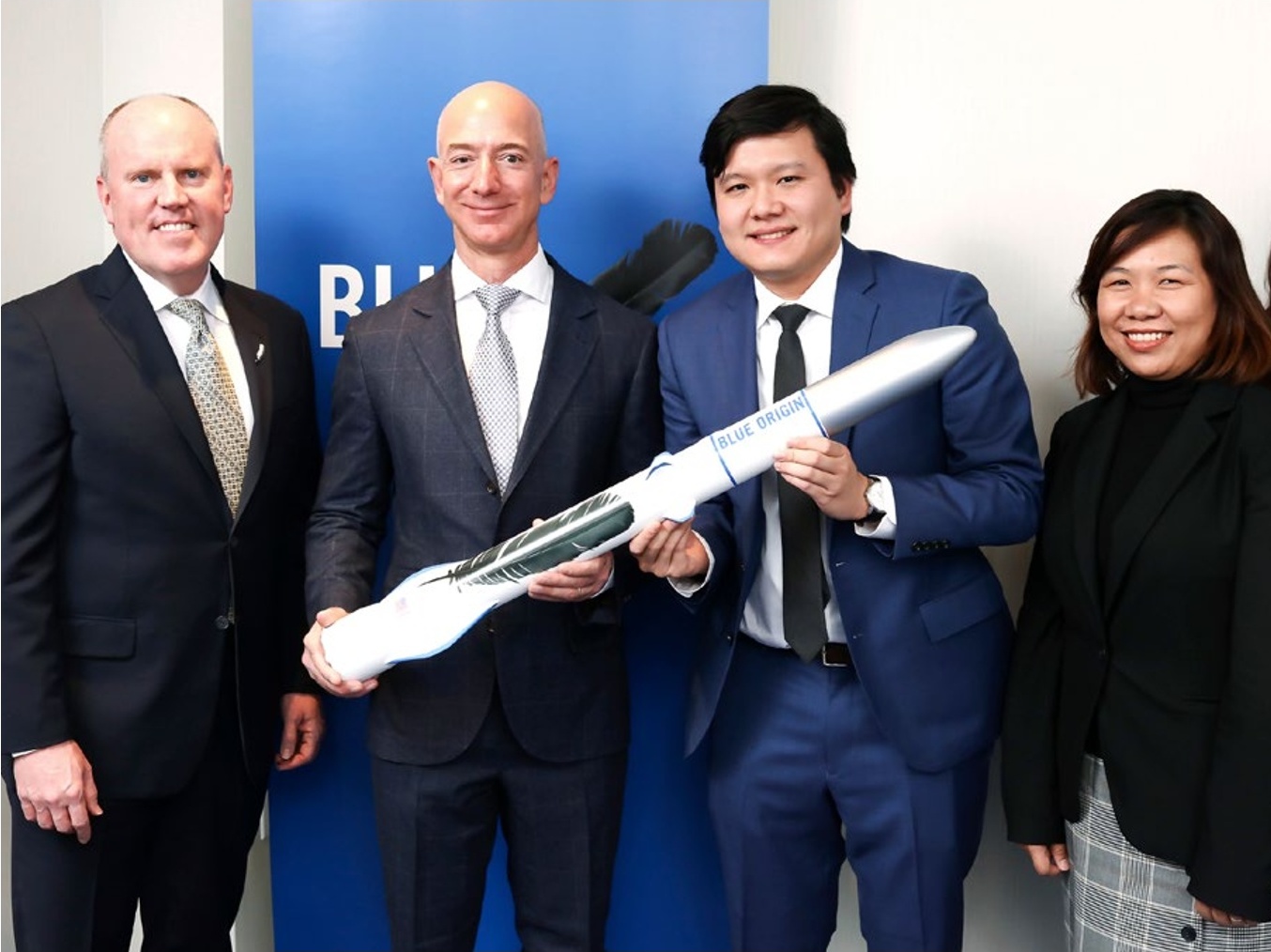
James Yenbamroong with Blue Origin founder Jeff Bezos holding a replica of New Glenn rocket.
He attended high school in New Zealand, then moved to the U.S. to study at the University of California, Los Angeles, where he got a bachelor’s degree in aerospace engineering and then a master’s in mechanical engineering. Plans for pilot training gave way to an engineer’s job working on unmanned vehicle systems at defense giant Northrop Grumman in California.
Home beckoned, so in 2014 Yenbamroong returned to Thailand. He then went into business with his uncle Chatchai Yenbamroong to set up telecoms and satellite operator Mobile LTE (now Thaisat Global). The family is well known in Thailand’s powerful telecoms industry. Chatchai, a one-time journalist and Fulbright scholar, helped steer former prime minister Thaksin Shinawatra into telecoms, although they later parted ways and became competitors.
James led the company to becoming the country’s second licensed satellite operator, then saw an opportunity to launch mu Space in 2017 with five million baht ($150,000) of his own money, and another 100 million baht in funding from angel investor Prasop Jirawatwong, owner and CEO of Bangkok-based apparel maker Nice Apparel. Other early investors included infrastructure giant B.Grimm Power and Singapore venture capital firm Majuven. Mu Space quickly applied for—and got—a 15-year government license to operate and provide satellite services to Thailand.
A $25 million series B round followed in 2019 and a year later, a $2.7 million investment from state-owned telecoms TOT after the two firms partnered to explore the tech for low Earth orbit satellites. He expects to raise $34 million in new series C funding, due to close in the fourth quarter, that would bump up mu Space’s valuation to $330 million.
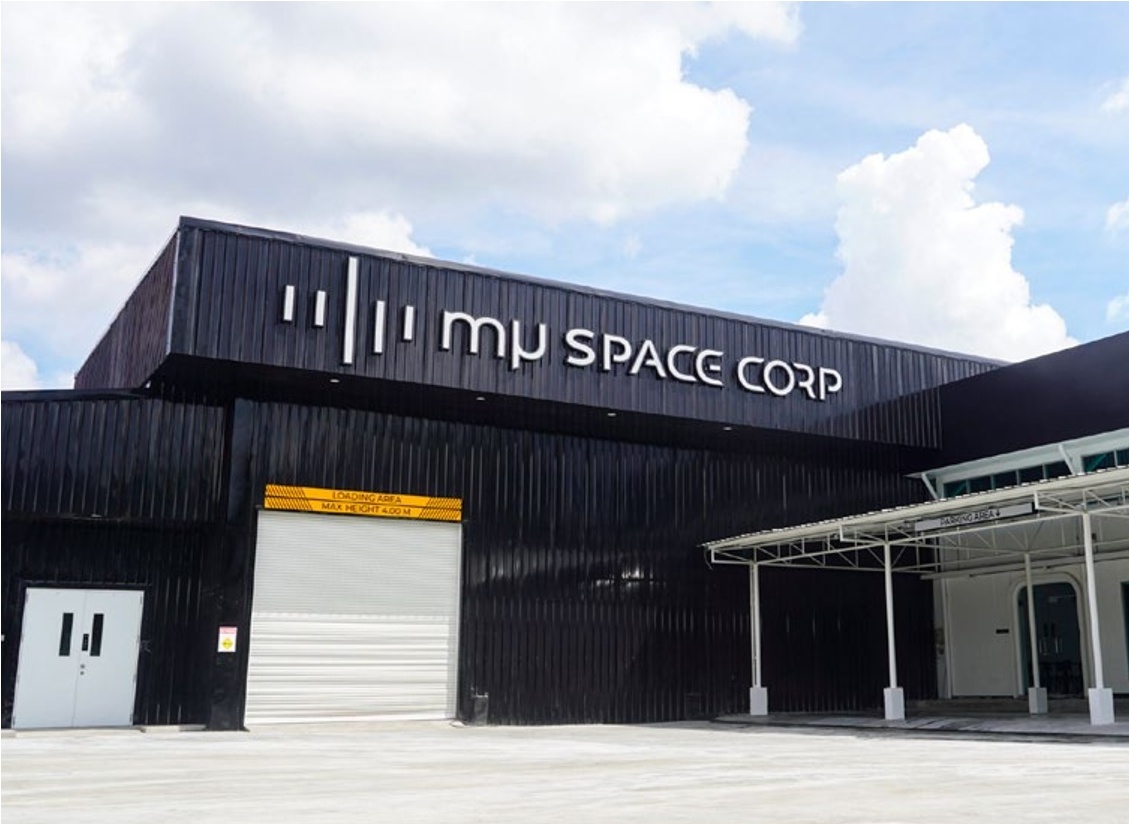
Located in Bangkok, mu Space’s Factory 1, Thailand's first private satellite-assembly plant.
Numerous startups have emerged in a booming space field awash with venture capital, but so far little of that money has found its way to Southeast Asia, says Gregg Daffner, president of Asia-Pacific Satellite Communications Council and cofounder of satellite leasing firm GapSat. Overall, global funding to commercialize space doubled in 2021 to about $15 billion from a year earlier, according to U.S. analytics firm BryceTech. Much of that will be directed to launch an estimated 1,700 satellites annually on average through 2030, according to space intelligence firm Euroconsult. The majority are deployed by Western firms that have dominated space exploration for decades.
Yet costs of entry have come down and a proliferation of new launch firms has helped to democratize the field, says Daffner. Mu Space is the only visible player in Thailand, he adds, and has the advantage among Southeast Asia’s space startups.
“It’s an exciting time for space, and to think, you could potentially build satellites in Thailand,” Daffner says. “This is a big deal.” But he sounds a note of caution about ambitions to launch. “An entrepreneur might be willing to take a big risk,” he adds, but “the industry [will] not buy a satellite from a manufacturer with nil heritage.”
Asia has long had the space bug. India blasted off its first rocket in the 1960s, and started sending satellites into space over 40 years ago. China became the third nation to land astronauts on the moon, and has an estimated 500 satellites in orbit. Japan was the first country to land on, and harvest material from, an asteroid. South Korea launched a small satellite in June atop its first homegrown rocket.
MU SPACE MADE ITS FIRST SPLASH IN 2018 WHEN IT PUT A MODEST 8KG PAYLOAD INTO SPACE ATOP NEW SHEPARD, A NEW ROCKET FROM JEFF BEZOS’ BLUE ORIGIN.
Southeast Asia has mostly remained an onlooker. Thailand is backing a space consortium to develop a pilot satellite to survey the earth next year. Indonesia formed space agency Lapan almost 60 years ago, reviving dormant ambitions recently with plans to build the region’s first launch site on Biak Island. Singapore is doing its best to carve out a role in the intelligence area, while providing funding to universities to spur development and incubate space startups.
Ng Zhen Ning, cofounder and CEO of Nu-Space—a Singapore startup that makes tiny satellites—received a year’s worth of government support that was crucial to launching its first nanosatellite on SpaceX in January. Still, operating in Southeast Asia remains challenging, he concedes. “Space is really hot right now,” he says. But “you really have to prove yourself to investors, show a track record.”
Apart from brisk production growth, mu Space has expanded its workforce to 160, and Yenbamroong aims to make it 300 by year's end. “My goal is to work with people who have the same passion for space as I do,” he says. Homegrown talent isn’t an issue, he claims, with a pipeline of engineers who studied overseas or worked in related industries. Still, plans are far from assured, especially amid a global belt-tightening. “We'll probably see fewer investments,” says Therese Jones, senior director of policy at the Satellite Industry Association, who expects the industry to consolidate in the next few years.
As the countdown continues for mu Space’s biggest test—putting its own satellite into orbit—Yenbamroong looks forward to proving skeptics wrong. “Everyone will see we are no longer this company that is fresh out of the box. We’ll show people we are for real,” he said. “We’re ready to lift off.”
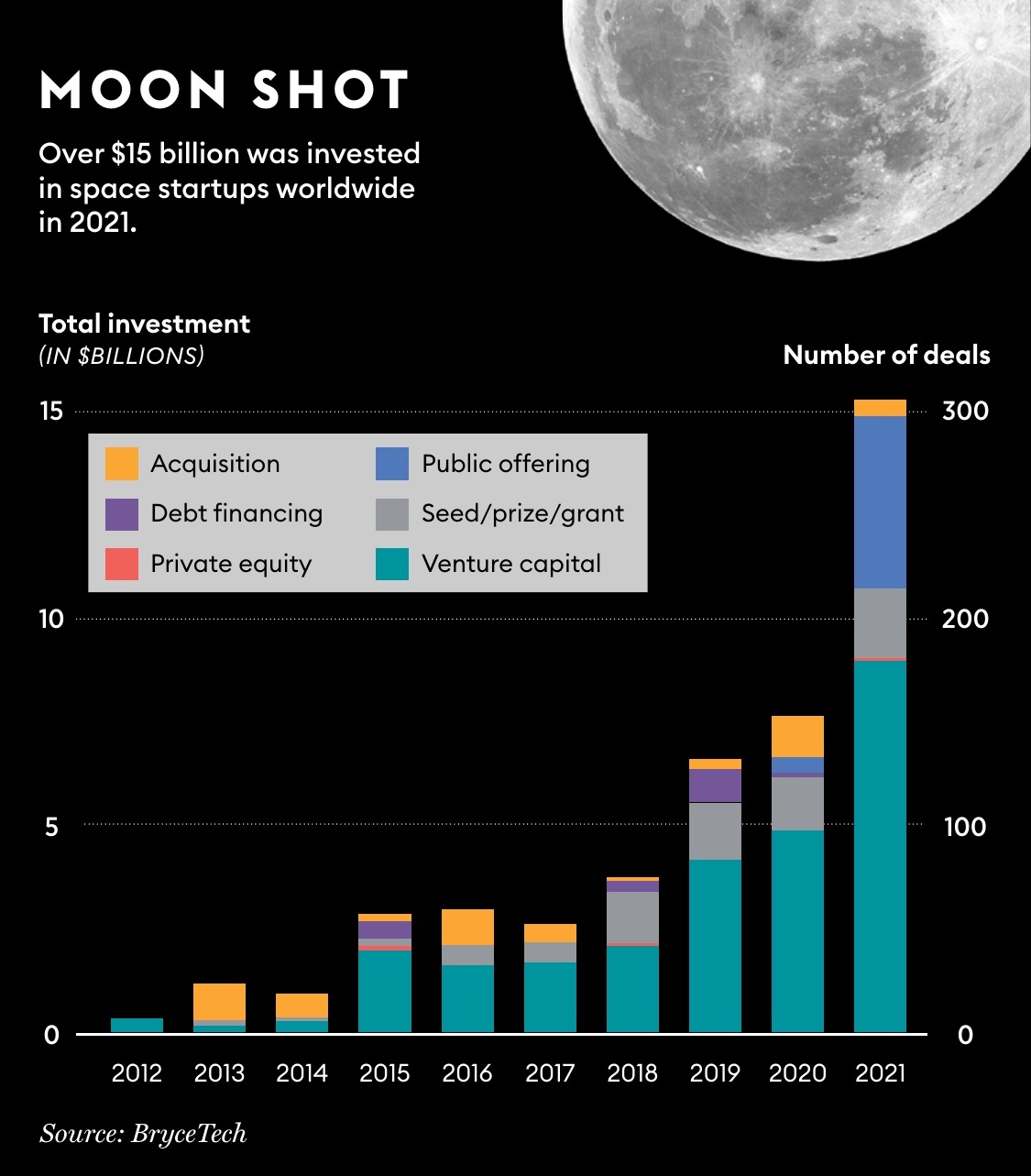
COURTESY OF MU SPACE; COURTESY OF MU SPACE, COURTESY OF BLUE ORIGIN

SINGAPORE'S 50 RICHEST
PATIENT FOR PROFITS
Chua Thian Poh has strengthened HO BEE LAND with well-timed condo sales in Sentosa Cove, a cash-generating commercial play and deals overseas.
BY JONATHAN BURGOS AND GLORIA HARAITO
PHOTOGRAPHS BY NICKY LOH FOR FORBES ASIA
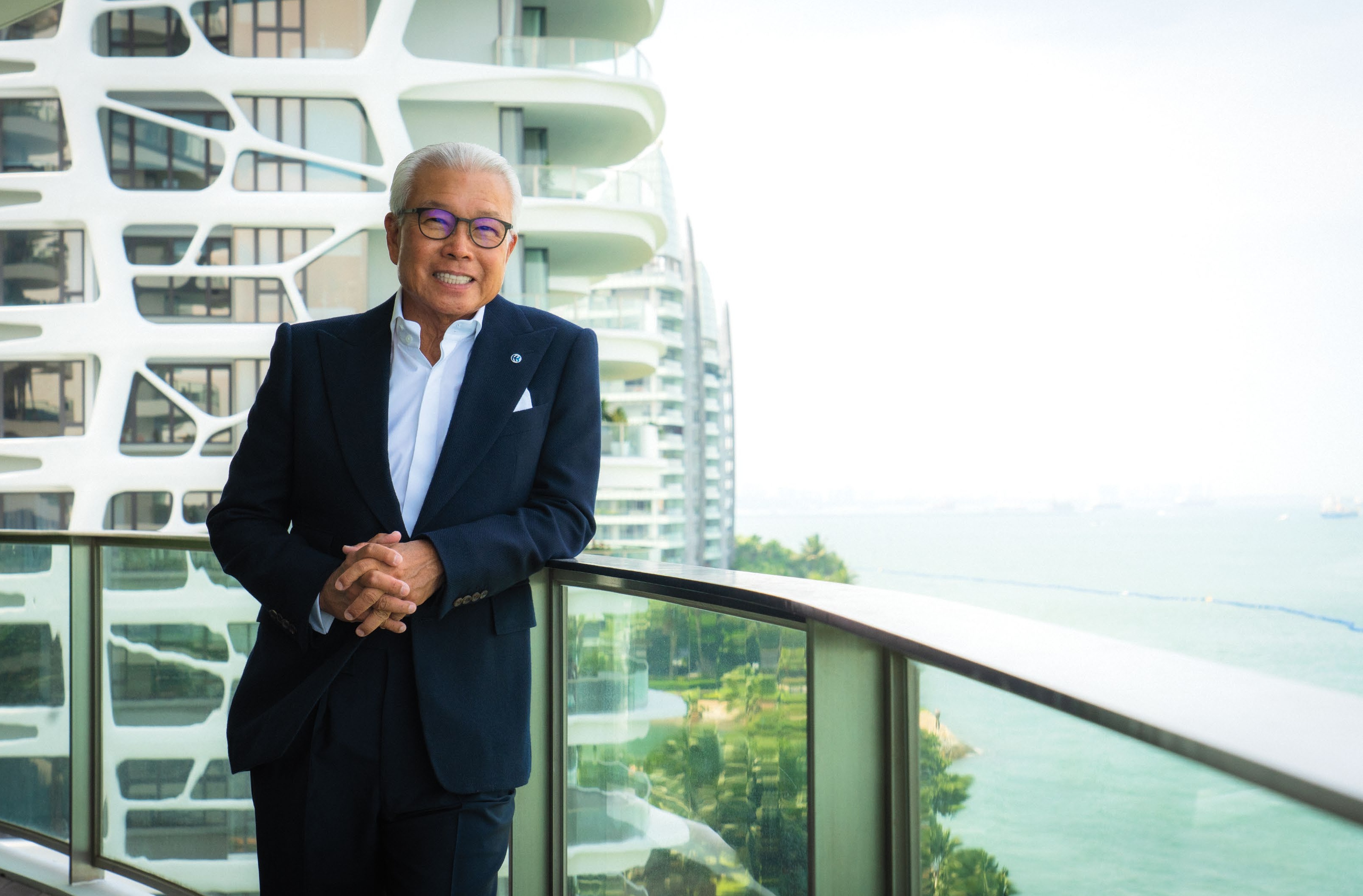
Chua Thian Poh, founder and executive chairman of Ho Bee Land, at Cape Royale in Sentosa Cove.
M any property developers pay lip service to taking a long-term view on their projects, and then there’s Chua Thian Poh, founder and executive chairman of Singapore-based real estate firm Ho Bee Land. He waited nine years for the right opportunity to start sales of condos in his 302-unit Cape Royale project, which was jointly developed by Ho Bee and Malaysia’s IOI Properties in 2013 in the posh neighborhood of Sentosa Cove.
In July, he began taking offers and with some 25 units sold right off the bat, sales since then have so far been good with an additional 10 units sold. The three-bedroom apartments are fetching a median price of S$4 million ($2.85 million) and four-bedroom units going for at least S$5.5 million. Even by the elevated standards of Sentosa Cove, one of Singapore’s most exclusive districts, Cape Royale’s location at its far end gives it some of the best views available, while also abutting a marina where condo owners can berth their yachts and chill out at a private club.
“We thought it’s a unique property,” says Nicholas Chua, Ho Bee Land CEO and eldest son of the company founder, while seated beside his father in one of Cape Royale’s apartments. “We just needed to wait for the right time.” The pair decided to lift the long ban on sales as Singapore enjoys a post-Covid boom, with GDP growth of 8% last year and a forecast for nearly 4% growth this year. Real estate prices across the city-state as a result are soaring, including those in Sentosa Cove.
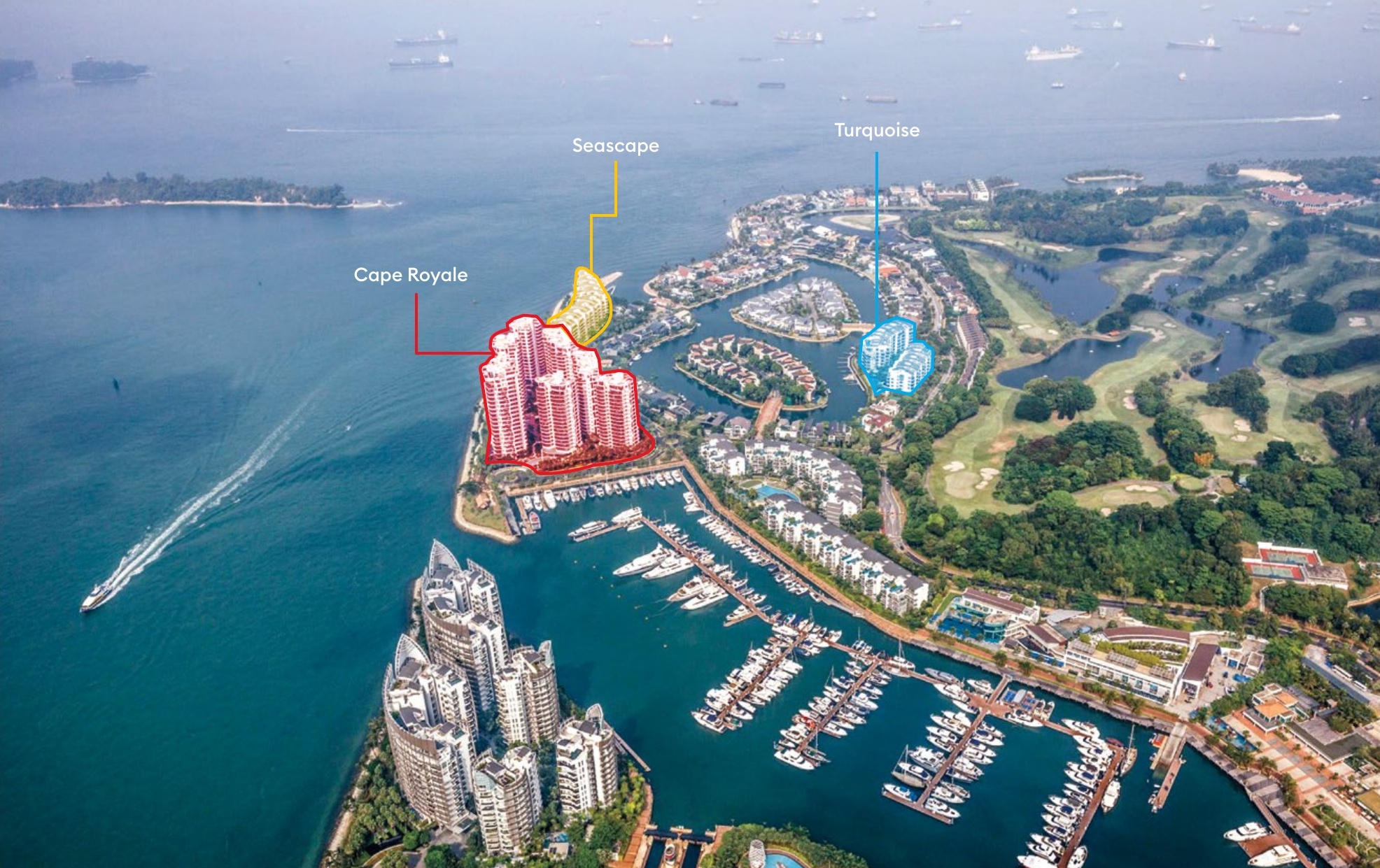
Ho Bee Land's eight developments in Sentosa Cove include Cape Royale, Seascape and Turquoise.
Back in 2013, Ho Bee deferred sales of Cape Royale and remaining unsold units at two other projects after prices tumbled more than 30% from their peak in 2010. Properties in the area had sold above S$2,300 per square foot but the slump came after the government introduced a series of measures from 2010 to curb runaway property values. Rather than settle for depressed prices, Ho Bee turned Cape Royale into a rental property, which generated income that more than offset the cost of holding the development in the past decade, according to Nicholas.
Yet the father and son duo say they are in no hurry to sell the condos now since most are leased out, with occupancy at Cape Royale above 90%. Nearly 30% of the buyers of Cape Royale are existing tenants who opted to purchase the properties they live in, while other buyers are waiting for the leases to expire, adds Nicholas.
While prices at Sentosa Cove aren’t back up to the 2010 peak—at least not yet—residences in this neighborhood currently sell at an average price of almost S$1,900 a square foot, up from less than S$1,500 at the height of the pandemic in 2020, according to data compiled by the Urban Redevelopment Authority. Some Cape Royale units are fetching above S$2,200, according to Ho Bee, just below previous peak prices.
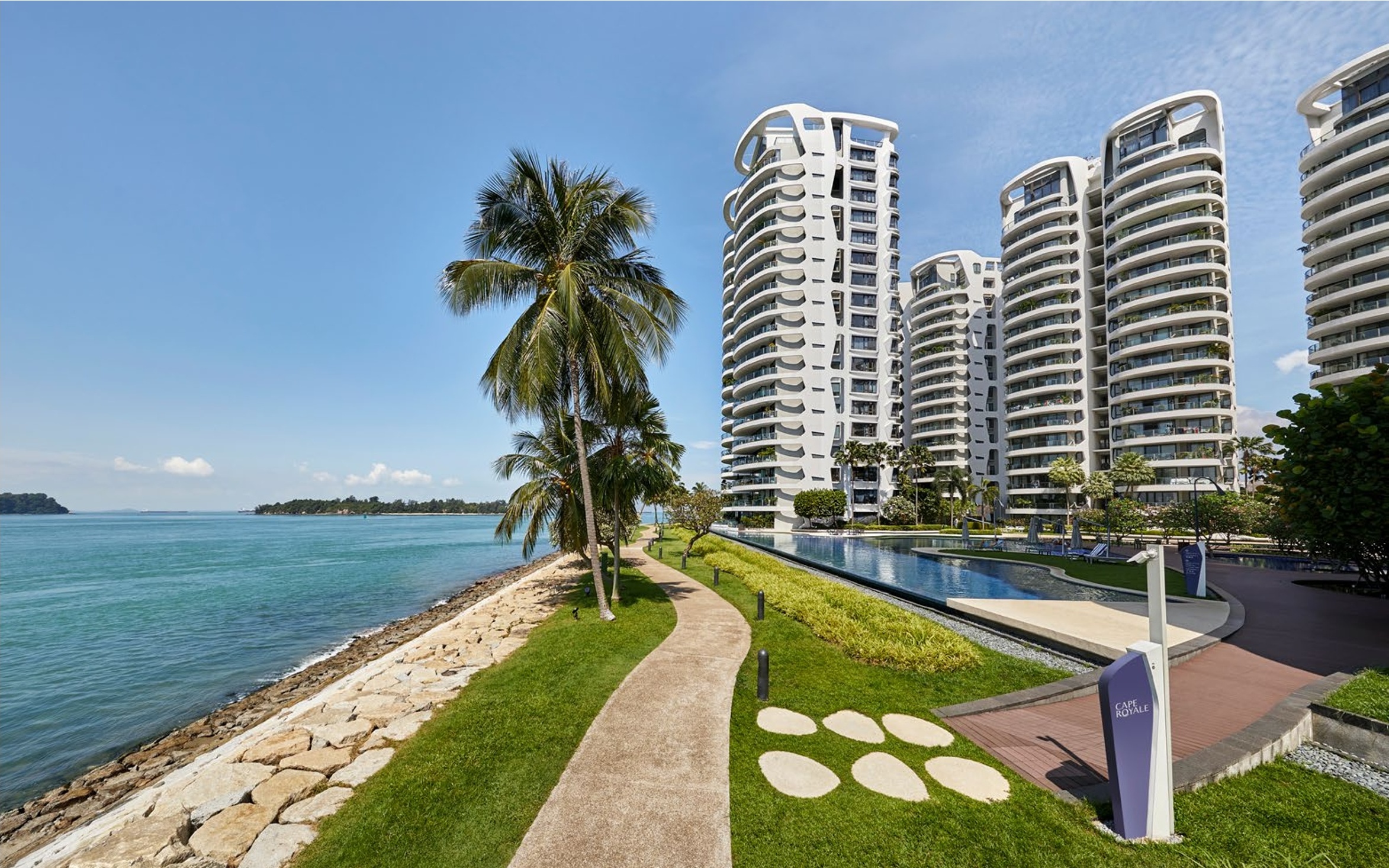
The 302-unit Cape Royale is Ho Bee's biggest project in Sentosa Cove.
“WE THOUGHT IT’S A UNIQUE PROPERTY.”
It’s worth paying attention to what the Chuas do in Sentosa Cove. Their Ho Bee—the Chinese characters for harmony and beauty—transformed itself into a major player in the luxury residential market in Singapore after the government reclaimed the land on the southernmost tip of Sentosa island in the early 1990s for high-end development. While others were wary about investing there, the elder Chua took a calculated bet and pioneered projects in Sentosa Cove nearly two decades ago.
Ho Bee built a total of eight projects, accounting for more than half of all the homes in the neighborhood, which now has 2,150 residences in both villas and condos. “Our investments in the waterfront housing in Sentosa Cove have yielded us exceptionally good returns,” said Chua in his chairman’s message in the 2006 Ho Bee annual report. In part because of the success of the Sentosa gambit, Ho Bee’s market capitalization on the Singapore exchange that year passed S$1 billion, a fourfold increase from when the company went public in 1999.
Sentosa Cove retains its appeal today, with buyers looking for more spacious apartments and wide open spaces, adding work-from-home offices to the list of must-haves, says Song Seng Wun, Singapore-based chief economist at CIMB Private Banking. “Singapore is not going to be the cheapest place to do business from,” he adds. “But people are attracted to work and live here because Singapore remains relevant as a global business hub.” Last month, Prime Minister Lee Hsien Loong said Singapore aims to attract top caliber international executives to the Lion City, asserting the city-state cannot afford to be left behind in the competition for talent.

An artist's rendering of the Elementum in Singapore's Biopolis business park, which is slated for completion next year.
SNAPPING BACK
Average prices of waterfront luxury homes in Sentosa Cove are rebounding amid a recent surge in demand.
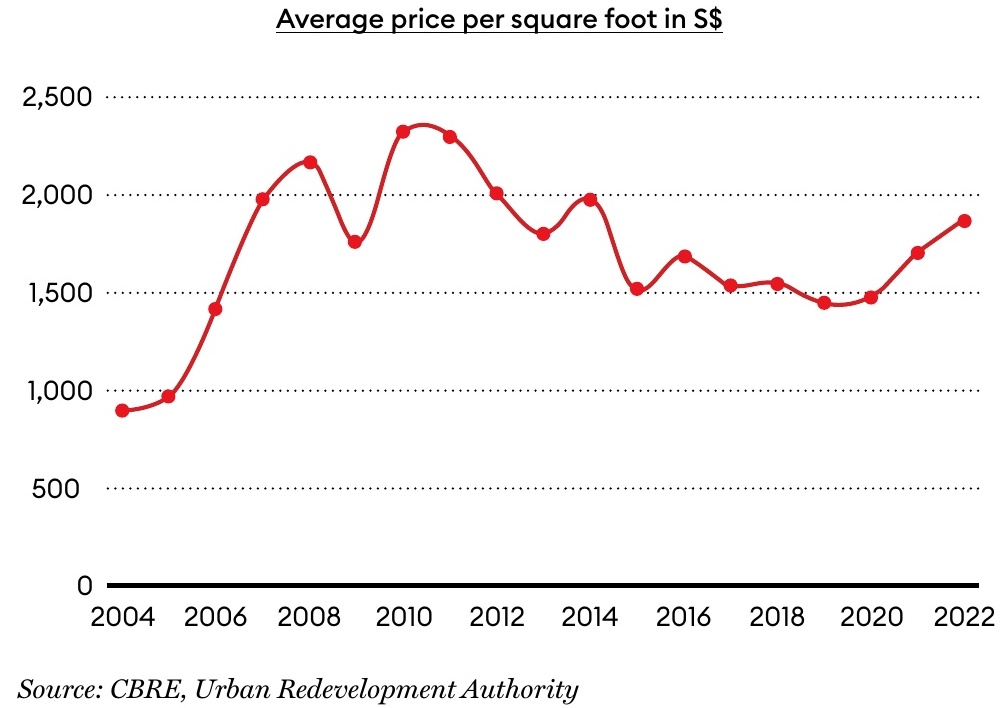
T he Sentosa strategy is one example of steps the elder Chua has taken in the past decade to strengthen Ho Bee from a respected but locally focused property outfit into one with a strong cash-flow generating commercial portfolio and a growing presence in overseas markets. While rising mortgage rates could dent demand for luxury properties, Nicholas says he is optimistic that the sales momentum at Sentosa Cove would be sustained because potential buyers are “well-heeled” and less sensitive to higher rates. “We actually feel more confident over the prospects of Sentosa Cove,” he says. “Singapore has weathered the pandemic very well. With a stable political climate, we continue to attract many global citizens.”
His optimism extends to China despite slumping housing sales there amid a deepening debt crisis among major developers in the country. As of December 2021, China accounted for about 7% of Ho Bee’s total real estate portfolio valued at S$6.6 billion. The China projects—developed in partnership with billionaire Zhong Sheng Jian’s Yanlord Land Group—are substantially sold, which means a slump in the mainland shouldn’t have a significant impact on Ho Bee, Nicholas says. Similarly, he downplays softening housing demand in Australia, which accounts for 3% of the group’s portfolio. “We expect demand to improve eventually,” he says.
For now, Ho Bee profits are being bolstered by its twin engines of growth: the resumption of Sentosa Cove sales and rising rental income from the group’s expanding office assets in London and Singapore. Net profit jumped 42% to S$150 million in the first half compared to the previous year, after more than doubling to S$331 million during 2021, the company said in a regulatory filing last month. Revenue increased 13% to S$178 million in the six months to June, reflecting maiden rental income from The Scalpel, a prime office tower in London it recently acquired, and sales of Sentosa Cove apartments.
“WE DECIDED NOT TO PURELY DEPEND ON RESIDENTIAL DEVELOPMENT PROFITS SINCE THE INCOME WAS VERY LUMPY.”
Despite inflationary pressures and geopolitical headwinds from the war in Ukraine, Ho Bee’s recurring income from its commercial properties is expected to cushion the blow from any new slump. “During the 2010 housing downturn, we decided not to purely depend on residential development profits since the income was very lumpy,” the company executive chairman recalls. “We thought we should build up a sustainable recurring income. That’s why we went into office properties.” Despite forecasts that work-from-home trends would permanently dent the commercial market, the company’s Singapore vacancy rate remains "very low," as in the case in London, he says.
The company in March acquired The Scalpel—a 36-story skyscraper in London’s financial district—for £718 million ($850 million). The acquisition, completed in just four months after the company viewed the property in November, appears well timed. London office rents will increase about 3% a year in the next five years due to a limited supply of prime office space in the city, according to a research note published by property consultant JLL in July.
With commercial properties in London and Singapore now accounting for 77% of the group’s assets, Ho Bee’s rental income has grown more than twenty-fold in the past decade to S$224 million in 2021. In Singapore, the company is developing its second office complex, the Elementum, in Biopolis—a life sciences hub in the western Singapore district of Buona Vista—slated to be completed in 2023 and situated next to its existing The Metropolis office block that’s home to multinationals such as Shell and General Electric. “With limited new office supplies in Singapore and still positive economic growth, office rents should continue to grow in 2023 and beyond,” says Tricia Song, Singapore-based head of research in Southeast Asia for CBRE.
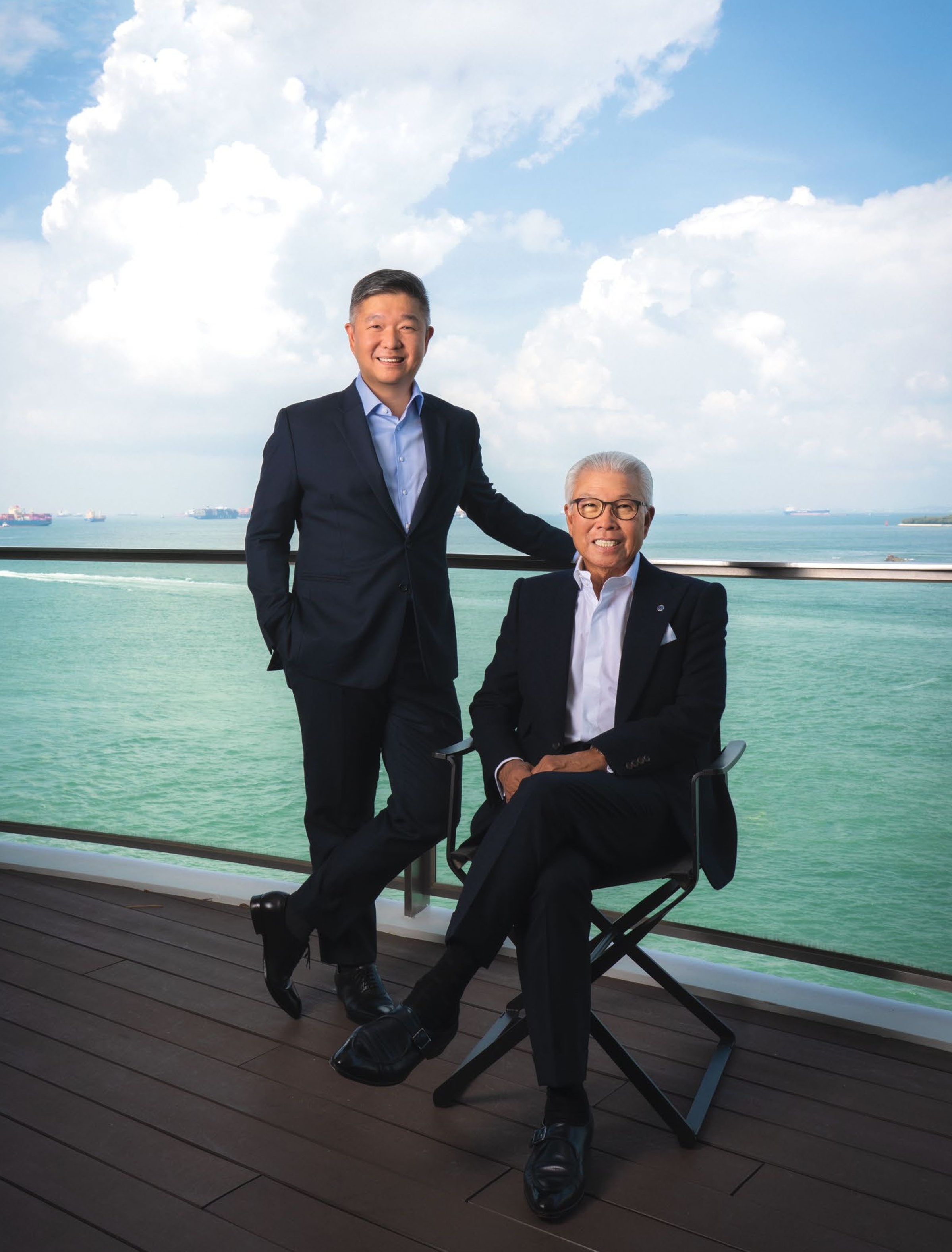
Ho Bee Land CEO Nicholas Chua (standing) with his father, Chua Thian Poh.
SHIFTING GROWTH
Ho Bee Land has built up rental income over the past decade to cushion a lumpy revenue stream from residential projects.
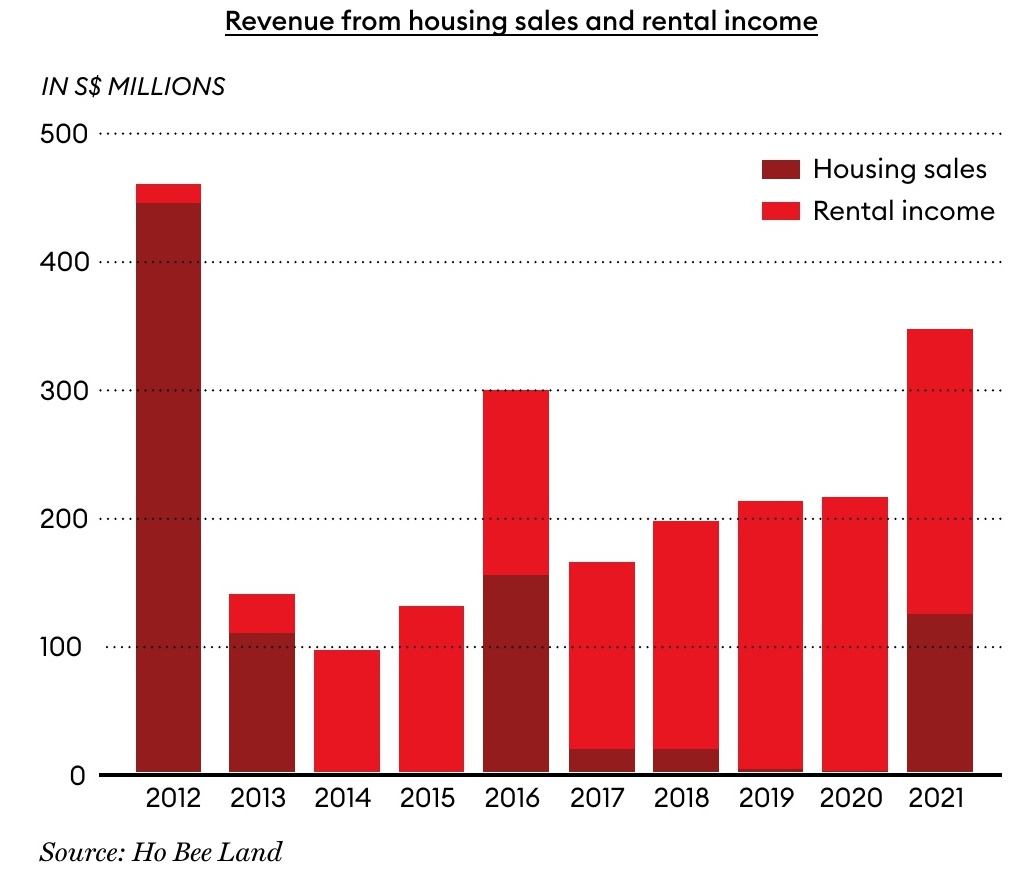
While Chua, 74, still reports to the office every day, he has been gradually handing the reins to his eldest son, who was appointed CEO in January. “Nicholas has been groomed to take over,” Chua says with a smile. “He has been with the company for 20 years already. He'd gone through a few cycles of ups and downs in the [global] property market.”
Chua quit vocational school at 16 and, with S$15,000 borrowed from his mother, started a business making hooks and spikes for logging companies. Later he went to Indonesia to trade commodities, which eventually gave him the capital to start a Singapore real estate business in 1987. Chua owns the majority of listed Ho Bee, and this stake plus other private assets, moved him up six spots to No. 28 on Singapore’s 50 Richest list with a net worth of $1.5 billion.
The younger Chua, 46, has had a smoother ride. After earning a degree in finance and marketing from the University of Oregon, he worked at DBS Group, before joining Ho Bee in 2002 and became deputy CEO in 2018. Nicholas spearheaded the expansion overseas, securing projects in Australia and China, while deepening the U.K. investments, which account for nearly 40% of the group’s total assets. As he mulls Ho Bee’s future, Nicholas notes the value of his father's advice. “He's able to see a little bit further,” Nicholas says. “He has a vision to move forward and see things where other people can't.”
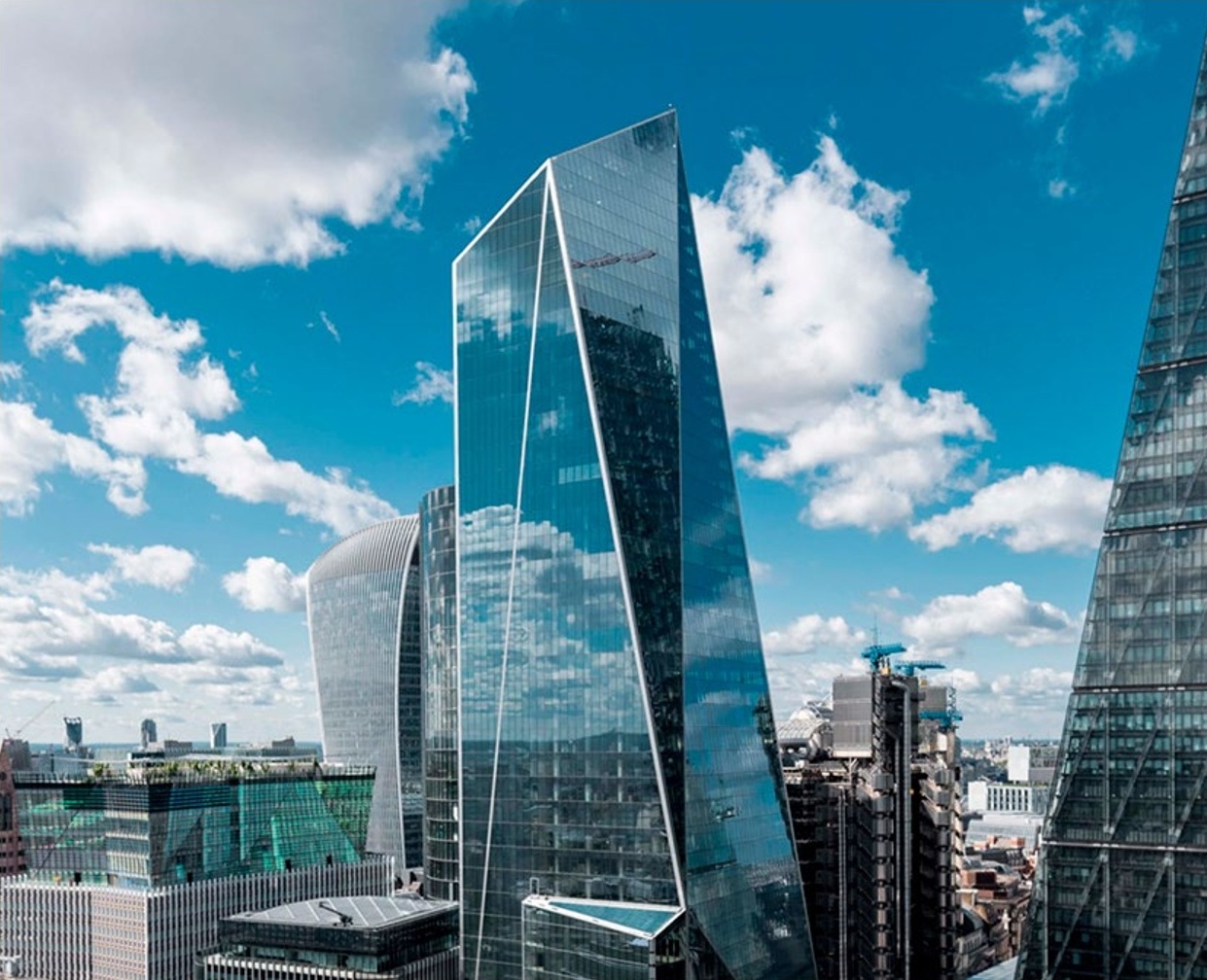
The 36-story The Scalpel in London's financial district.
DARREN SOH/BLOOMBERG; COURTESY OF HO BEE LAND; ELEMENTUM: COURTESY OF HO BEE LAND; COURTESY OF HO BEE LAND

SINGAPORE'S 50 RICHEST
SAFE HARBOR
While Singapore continued to draw wealthy foreigners, global headwinds took a toll on the combined fortunes of the nation’s richest this year.
BY NAAZNEEN KARMALI AND JANE HO
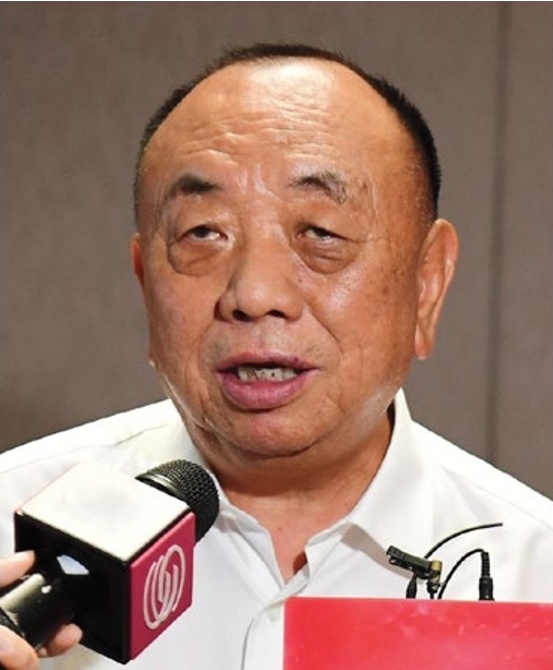
No. 1 Li Xiting
S ingapore’s reputation as a safe haven, burnished during the pandemic, has made it a magnet for the wealthy. The continuing influx of rich foreigners boosted the city-state’s property sector, driving up prices and rentals. The easing of border restrictions from April led to an uptick in international visitors, sending hotel rates soaring. Despite these positive trends, rising inflation and the global tech rout knocked down the combined wealth of Singapore’s 50 richest by more than a fifth to $164 billion from a year ago.
The pecking order of the top five reflects post-pandemic realities. The wealth of Li Xiting, founder and chairman of Shenzhen Mindray Bio-Medical Electronics, shrank by nearly a third to $15.6 billion though he held on to his position as No. 1. Shares of his medical device maker dropped on slower sales growth. The property recovery and new information on their real estate holdings propelled brothers Robert and Philip Ng to second place with $15.2 billion. The fortune of 95-year-old paints tycoon Goh Cheng Liang, who controls Japan’s Nippon Paint Holdings and is the oldest person on the list, was down 30% to $13 billion though he remains at No. 3.
The tech sell-off more than halved the net worth of Facebook (since renamed Meta Platforms) cofounder Eduardo Saverin to $9.6 billion and he slipped two places to No. 4. New York-listed gaming firm Sea, last year’s red-hot stock, plunged on increasing losses in its e-commerce arm, eroding the wealth of its three cofounders Forrest Li, Gang Ye and David Chen by more than 70% each—the biggest drop in percentage terms.
These steep declines far outweighed the net worth rise recorded by more than half the list members. Notable in this group is Min-Liang Tan, founder of Razer, who benefited from taking his gaming devices firm private. The hospitality sector recovery brought hotelier Michael Kum of M&L Hospitality back in the ranks after a year’s gap.
There are two newcomers this year, both with international roots. The richest new entrant is Indonesia-born Leo Koguan, cofounder and chairman of IT provider SHI International, who revealed last year that he was the third-largest individual shareholder in Tesla. Now an American citizen residing in Singapore, Koguan appears at No. 7 with $7.6 billion. The second newcomer is France-born Laurent Junique, founder of Singapore-based call center and business process outsourcing firm TDCX, which listed last October on the New York Stock Exchange.
Three from last year dropped off, including Changpeng Zhao, the peripatetic founder of crypto exchange Binance, who was included among Singapore’s richest last year but has since moved to Dubai. Another high-profile absentee is Grab Holdings’ cofounder Anthony Tan; shares of the superapp tumbled amid continuing losses. The minimum net worth to make the list dropped to $705 million from $735 million last year.
Additional reporting by Jonathan Burgos, Gloria Haraito, Anuradha Raghunathan, Jessica Tan and Yue Wang.
METHODOLOGY
The list was compiled using shareholding and financial information obtained from the families and individuals, stock exchanges, analysts and other sources. Unlike our billionaire rankings, this list includes family fortunes, including those shared among extended families such as that of Kwek Leng Beng and his cousins. Net worths are based on stock prices and exchange rates as of the close of markets on Aug. 19, 2022. Private companies were valued based on similar companies that are publicly traded. The list can also include foreign citizens with business, residential or other ties to the country, or citizens who don’t reside in the country but have significant business or other ties to the country. The editors reserve the right to amend any information or remove any listees in light of new information.
SINGAPORE'S 50 RICHEST
1. LI XITING
$15.6 BILLION ▼
SHENZHEN MINDRAY BIO-MEDICAL ELECTRONICS
AGE: 71
2. ROBERT & PHILIP NG
$15.2 BILLION ▲
FAR EAST ORGANIZATION
AGES: 70, 63
3. GOH CHENG LIANG
$13 BILLION ▼
NIPPON PAINT HOLDINGS
AGE: 95
4. EDUARDO SAVERIN
$9.6 BILLION ▼
FACEBOOK
AGE: 40
5. KWEK LENG BENG
$9.3 BILLION ▲
CITY DEVELOPMENTS
AGE: 81
6. ZHANG YONG & SHU PING
$7.7 BILLION ▼
HAIDILAO INTERNATIONAL HOLDING
AGES: 52, 52
7. LEO KOGUAN
$7.6 BILLION ★
SHI INTERNATIONAL, TESLA
AGE: 67
8. KHOO FAMILY
$6.9 BILLION ▲
GOODWOOD GROUP OF HOTELS
9. WEE CHO YAW
$6.8 BILLION ⬌
UNITED OVERSEAS BANK
AGE: 93
10. KWEE BROTHERS
$5.8 BILLION ▲
PONTIAC LAND
11. FORREST LI
$4.2 BILLION ▼
SEA
AGE: 44
12. KUOK KHOON HONG
$3.9 BILLION ▲
WILMAR INTERNATIONAL
AGE: 72
13. GANG YE
$2.8 BILLION ▼
SEA
AGE: 42
14. RAJ KUMAR & KISHIN RK
$2.7 BILLION ▲
RB CAPITAL/ROYAL HOLDINGS
AGES: 68, 39
15. RICHARD CHANDLER
$2.6 BILLION ▲
CLERMONT GROUP
AGE: 63
16. PETER LIM
$2.55 BILLION ▼
THOMSON MEDICAL GROUP
AGE: 69
17. SAM GOI
$2.5 BILLION ▲
TEE YIH JIA FOOD MANUFACTURING
AGE: 75
18. ARVIND TIKU
$2.45 BILLION ▲
AT HOLDINGS
AGE: 52
19. CHOO CHONG NGEN
$2.4 BILLION ⬌
WORLDWIDE HOTELS
AGE: 69
20. ROBERT FRIEDLAND
$2.3 BILLION ▲
IVANHOE MINES
AGE: 72
21. LEE FAMILY
$2.2 BILLION ▲
OCBC BANK
22. OEI HONG LEONG
$2 BILLION ▲
AGE: 74
23. HO FAMILY
$1.8 BILLION ▲
TAI TAK ESTATES
24. ONG BENG SENG & CHRISTINA ONG
$1.75 BILLION ▲
HOTEL PROPERTIES
AGES: 77, 74
25. ASOK KUMAR HIRANANDANI
$1.65 BILLION ▲
ROYAL GROUP HOLDINGS
AGE: 67
26. TAY FAMILY
$1.6 BILLION ▲
MEMOCORP
27. LIEN FAMILY
$1.55 BILLION ▲
UNITED OVERSEAS BANK
28. CHUA THIAN POH
$1.5 BILLION ▲
HO BEE LAND
AGE: 74
29. ZHONG SHENG JIAN
$1.45 BILLION ▼
YANLORD LAND
AGE: 64
30. CHEW GEK KHIM
$1.43 BILLION ▼
STRAITS TRADING
AGE: 60
31. RON SIM
$1.42 BILLION ▲
V3 GROUP
AGE: 63
32. BINNY BANSAL
$1.4 BILLION ▲
FLIPKART
AGE: 39
33. TANG WEE KIT
$1.3 BILLION ▼
TANG HOLDINGS
AGE: 67
34. LIM HOCK CHEE
$1.2 BILLION ⬌
SHENG SIONG GROUP
AGE: 60
35. KOH WEE MENG
$1.15 BILLION ▲
FRAGRANCE GROUP
AGE: 59
36. JOHN LIM
$1.14 BILLION ▲
ESR GROUP
AGE: 66
37. GORDON & CELINE TANG
$1.1 BILLION ▲
SINGHAIYI GROUP
38. PETER FU CHONG CHENG
$1.07 BILLION ▲
KUO INTERNATIONAL
AGE: 69
39. YAO HSIAO TUNG
$1.05 BILLION ▲
HI-P INTERNATIONAL
AGE: 82
40. WONG BROTHERS
$1.04 BILLION ▼
CHARLES & KEITH
41. MICHAEL KUM
$1.02 BILLION ↩
M&L HOSPITALITY
AGE: 77
42. MUHAMMED AZIZ KHAN
$1 BILLION ▲
SUMMIT GROUP
AGE: 67
43. MIN-LIANG TAN
$995 MILLION ▲
RAZER
AGE: 44
44. LOO CHOON YONG
$990 MILLION ▲
RAFFLES MEDICAL GROUP
AGE: 73
45. LIM CHAP HUAT
$955 MILLION ▼
SOILBUILD GROUP
AGE: 68
46. SAURABH MITTAL
$900 MILLION ▲
MISSION HOLDINGS
AGE: 48
47. LAURENT JUNIQUE
$825 MILLION ★
TDCX
AGE: 56
48. DAVID CHEN
$745 MILLION ▼
SEA
AGE: 41
49. CHENG WAI KEUNG
$720 MILLION ▼
WING TAI HOLDINGS
AGE: 71
50. SHI XU
$705 MILLION ▼
NANOFILM TECHNOLOGIES INTERNATIONAL
AGE: 58
FOR MORE INFO, GO TO FORBES.COM/SINGAPORE
CHANGE IN WEALTH KEY:
▲ UP
▼ DOWN
⬌ UNCHANGED
★ NEW TO THE LIST
↩ RETURNEE
CHINA NEWS SERVICE/GETTY IMAGES
SINGAPORE'S 50 RICHEST
Rough Seas
FORREST LI, GANG YE & DAVID CHEN
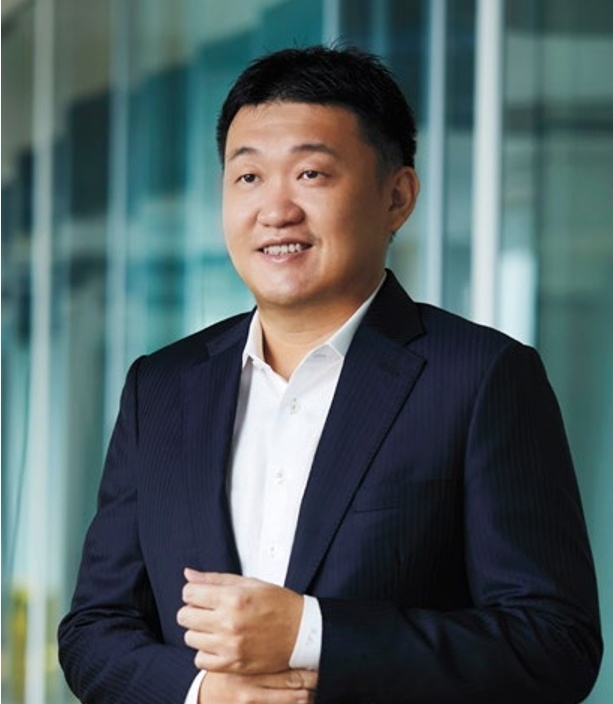
Forrest Li
The three cofounders of gaming and e-commerce firm Sea, Forrest Li, Gang Ye and David Chen, saw their wealth plummet by a collective $21.6 billion in the past year. Shares in their U.S.-listed company tumbled 77% amid a shakeout in high-tech stocks and as global headwinds scoured the online retail industry. Li, chairman and CEO, and Ye, chief operating officer, saw a steep drop in their fortunes to $4.2 billion and $2.8 billion, respectively. Chen, chief product officer at Sea’s shopping platform Shopee, is no longer a billionaire with his net worth now at $745 million.
Following a period of pandemic-fueled growth, a return to daily life coupled with supply chain constraints and inflationary pressures weighed on Sea’s earnings. The Singapore-headquartered company reported a bigger-than-expected net loss in the second quarter, more than doubling to $931 million from a year earlier. Though revenue was up 29% to $2.9 billion, it was lower than expected and the company said it would not provide 2022 revenue guidance for its e-commerce business. “We are in an environment of increased macro uncertainty, with rising inflation, rising interest rates, local currency depreciations against the U.S. dollar, and ongoing reopening trends,” Li said at Sea’s recent earnings briefing. The 13-year-old company has yet to turn a profit.
To rein in costs, Sea downsized its global plans for Shopee, which competes regionally with Alibaba’s Lazada and super-app Grab. Since March, Shopee has exited France, Spain and India—just months after pilot launches in those markets. Elsewhere, Shopee saw staff cuts across the globe including Mexico, Argentina, Chile and parts of Southeast Asia.
In fintech, the company has made some headway via its digital payments and services unit. In September 2021, SeaMoney rolled out its digital bank in Indonesia. It also clinched digital bank licenses in Malaysia and Singapore, where it is expected to launch in the second half of 2022. —Jessica Tan
SEAN LEE FOR FORBES ASIA
SINGAPORE'S 50 RICHEST
Long View
ONG BENG SENG
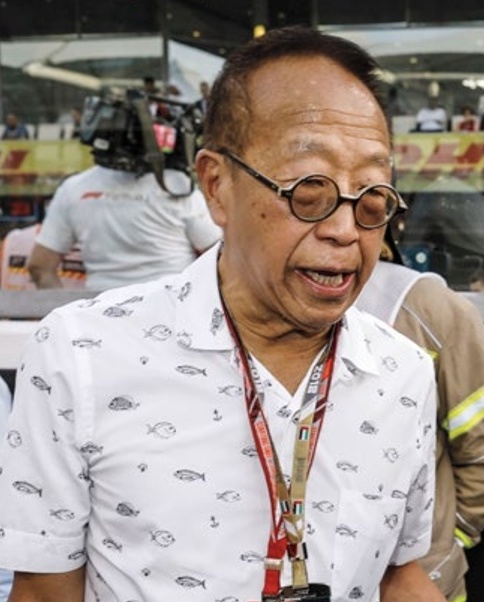
Unfazed by two years of pandemic-induced losses, Ong Beng Seng, managing director of Singapore-listed Hotel Properties, which owns such landmarks as the Four Seasons hotel in Singapore, has been busy ramping up.
In May, Hotel Properties and state-owned Temasek won a seven-month bidding race against Keppel to acquire a string of commercial properties (including shopping malls in Singapore and Australia) from media giant Singapore Press Holdings for about S$3.9 billion ($2.8 billion).
Earlier in January, the company opened voco Orchard Singapore, the refurbished and rebranded former Hilton Singapore. With the easing of travel restrictions, hotel occupancies and room rates in the city-state are surging as tourists return. It is now gearing up for the Singapore Grand Prix—a Formula 1 race organized by Ong’s privately held Singapore GP—set to take place in September after a two-year hiatus.
Hotel Properties is expanding outside its home turf too. Last year, the company bought Kanuhura Maldives—81 villas on Lhaviyani Atoll, about 150km north of the country’s capital Male—for an undisclosed sum, which will open next year. In 2023, the company also plans to open a 150-room hotel in Dubrovnik, Croatia, as it makes inroads into Europe’s fast-growing tourism market.
These moves are paying off. The company returned to the black with a net profit of S$1.9 million in the first half of 2022. Ong and his wife Christina are ranked at No. 24, with a combined net worth of $1.75 billion, up 2% since last year. Ong, who cofounded Hotel Properties more than four decades ago, oversees strategic planning and business development, while Christina runs Como Hotels and Resorts, a luxury chain she founded. —Jonathan Burgos
LHOCH ZWEI/NEWSCOM

SINGAPORE'S 50 RICHEST
Razer-Sharp
MIN-LIANG TAN
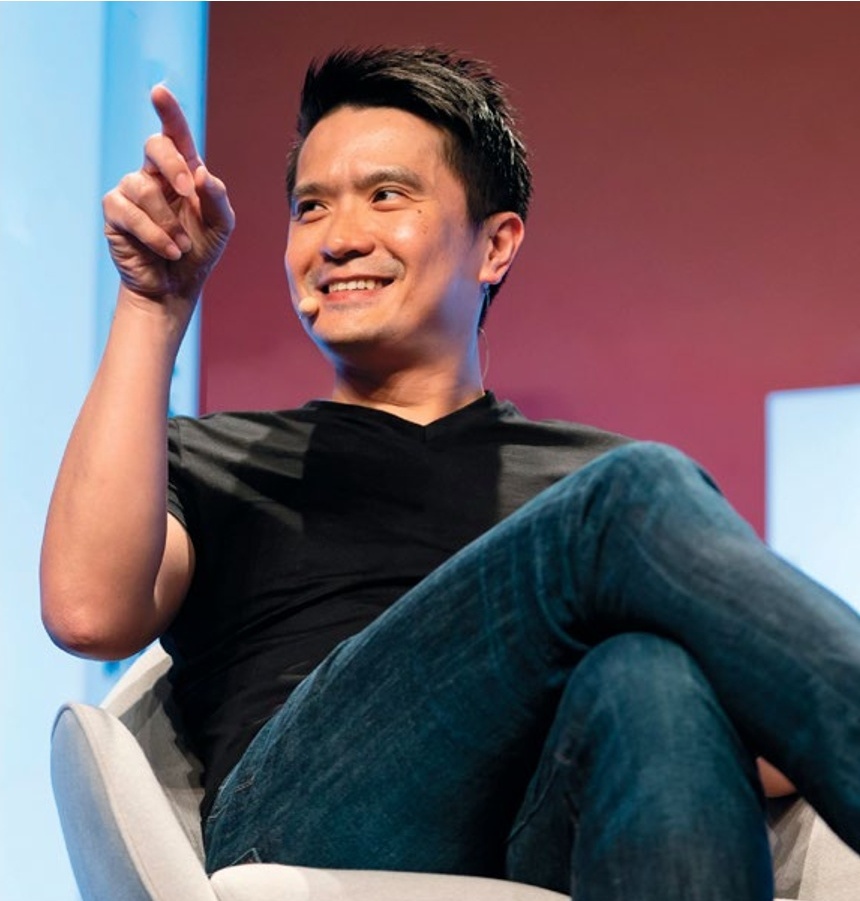
Five years after the highly anticipated IPO of global gaming devices firm Razer, chairman and CEO Min-Liang Tan led a group to take the company private, valuing it at $3.2 billion. The delisting in May saw Tan offer HK$2.82 (36 cents) a share for Razer, versus the 2017 IPO price of HK$3.88, following the stock’s recent lackluster performance on the Hong Kong exchange. Tan’s net worth rose to $995 million and he moved up six spots to No. 43.
Razer has said it’s planning to further-expand its software and fintech business, which now accounts for 10% of its $1.6 billion annual revenue. The company is also exploring decentralized finance, or DeFi, and blockchain opportunities. Known for its gaming laptops and accessories, Razer has been busy building out what it calls a gaming ecosystem targeted at millennials and Gen Zs.
It has hit a few speed bumps. In 2019, Razer axed its short-lived push into making gaming mobile phones. It also discontinued its business-to-consumer Razer Pay e-wallet app not long after failing to win a digital bank license in Singapore in late 2020.
In 2021, Razer reported a net profit of $46 million, an eightfold increase from the previous year. While the U.S. contributes the most to its topline, the company also has a sizable presence in China and Asia-Pacific, and aims to deepen its foothold in Southeast Asia as well as tap new markets such as Latin America and the Middle East. Tan cofounded the U.S.- and Singapore-headquartered company in 2005 with Robert Krakoff, president emeritus, who passed away in April at age 81. —J.T.
BLOOMBERG
SINGAPORE'S 50 RICHEST
On Call
LAURENT JUNIQUE
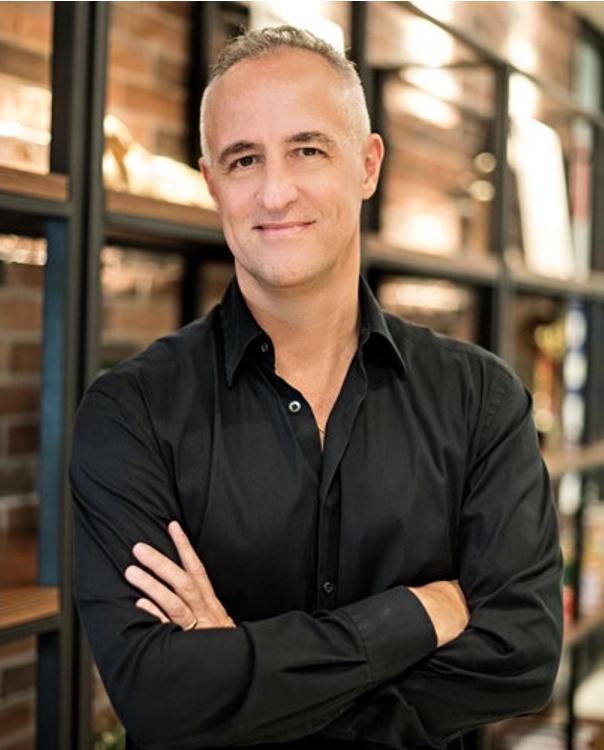
Newcomer to the list Laurent Junique is the ultimate globetrotter. He grew up moving to a new country every couple years because his parents were in the oil industry. Now, the French citizen has a call center company based in Singapore that went public on the New York Stock Exchange in late 2021. Junique, 56, owns the lion’s share of the company, called TDCX, which had a tough first 10 months as a public entity: Despite revenue growth, shares fell 65% since the IPO. That decline took his net worth from $3 billion early last October to $825 million.
Junique, who has described himself as “an entrepreneur at heart,” reportedly had his first business idea at age 13—melting old glass bottles and recycling them into wine glasses. (That idea didn’t take root.) After spending two years following university working for consumer products giant Unilever, Junique headed to Singapore with a plan to start his own business. In 1995, he launched Teledirect to handle calls, emails and faxes for a variety of clients. The company rebranded as TDCX in 2019 after expanding into services that include moderating content, marketing and e-commerce support; CX is industry jargon for “customer experience.” The company earned $77 million in profit on revenue of $410 million in 2021; in 2020, 62% of revenue was from two customers: Facebook (since renamed Meta Platforms) and Airbnb.
In a May conference call with analysts, TDCX lowered its expectations for 2022, saying revenue would likely grow around 19% rather than the previous forecast of roughly 25%—due to lower revenue growth from its top clients. Still, TDCX is expanding its footprint, adding new operations in Indonesia and Vietnam to the 11 countries where it already operates.
—Kerry A. Dolan
COURTESY OF TCDX
SINGAPORE'S 50 RICHEST
Wealth Creation
Taking Shelter
Rising living costs are on top of Singaporeans’ minds, as the government warns higher inflation and interest rates are likely to persist. Food prices are expected to double to 8.2% in the second half of this year from 4.1% in June, according to Nomura Holdings, while interest rates have been on an upward trend, with three rate hikes since January. An increase in private spending is likely to help buoy the economy in 2022—GDP is targeted between 3% and 4%—but growth is seen dropping back to 3% by 2023 and 2.9% by 2024.
Asia’s Lion City recovered from an anemic 2020 to grow nearly 8% last year. But the nation, which marked its 57th birthday in August, faces stiff global headwinds, aggravated by Russia’s war in Ukraine and supply chain bottlenecks. There’s a modest 10% chance Singapore will enter a recession over the next 12 months, according to a Bloomberg survey. With core inflation running at 14-year highs, expenses as a percentage of income rose to 64% in May from 59% a year earlier, estimates DBS Bank.
The government has pledged to help struggling households and businesses cope with higher prices. It has also signaled a possible tax increase for the wealthy to narrow the income gap, which would help refill its coffers. Meanwhile, the central bank boosted the Singapore dollar to check imported inflation.
In his annual address last month, Prime Minister Lee Hsien Loong called for a “deeper response” to economic challenges by upgrading skills and raising productivity to help push up wages in the city-state. Another key initiative is the Singapore Green Plan 2030 that encompasses sustainability targets to tackle climate change, offering a new engine for growth. —Rainer Michael Preiss
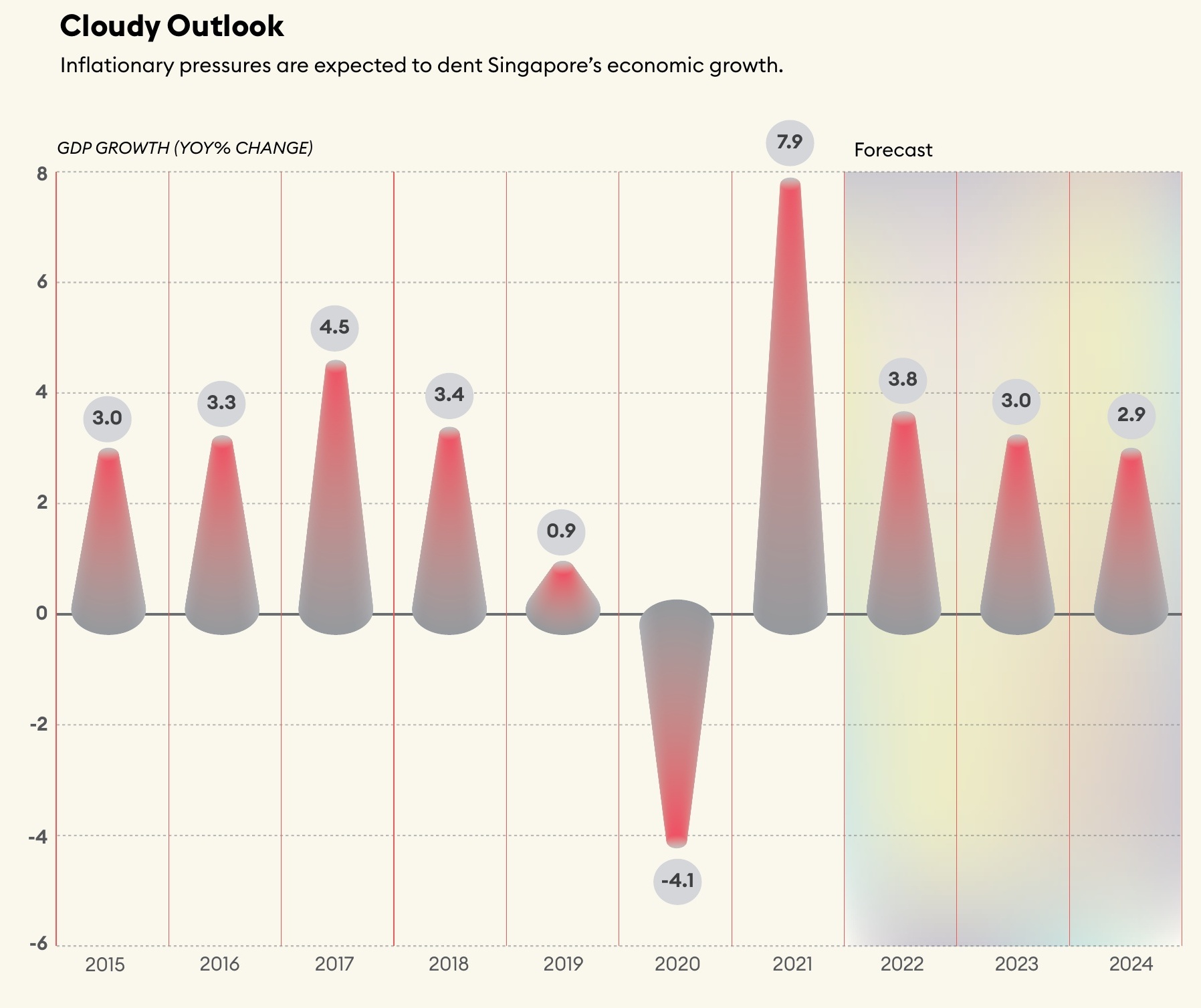
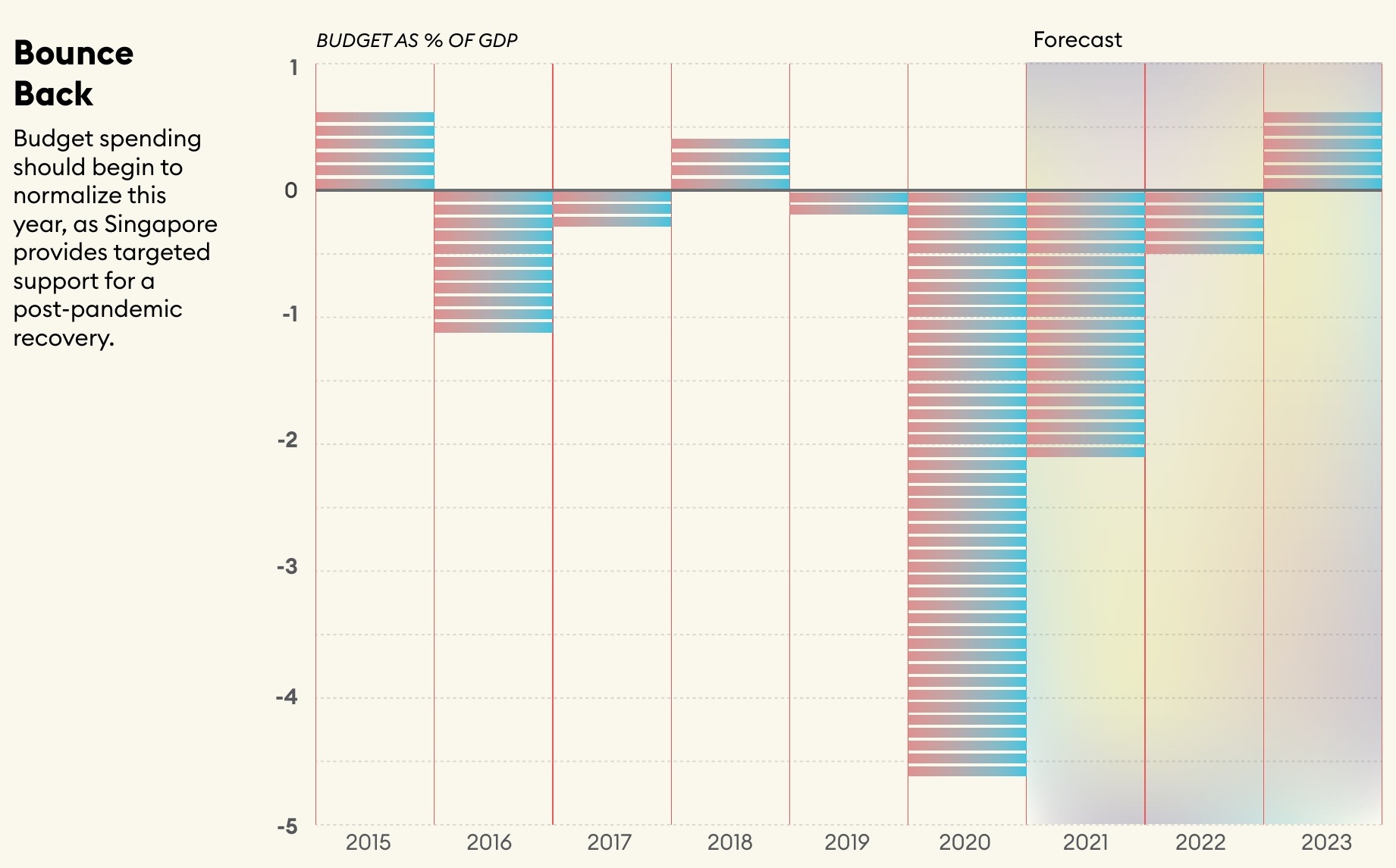
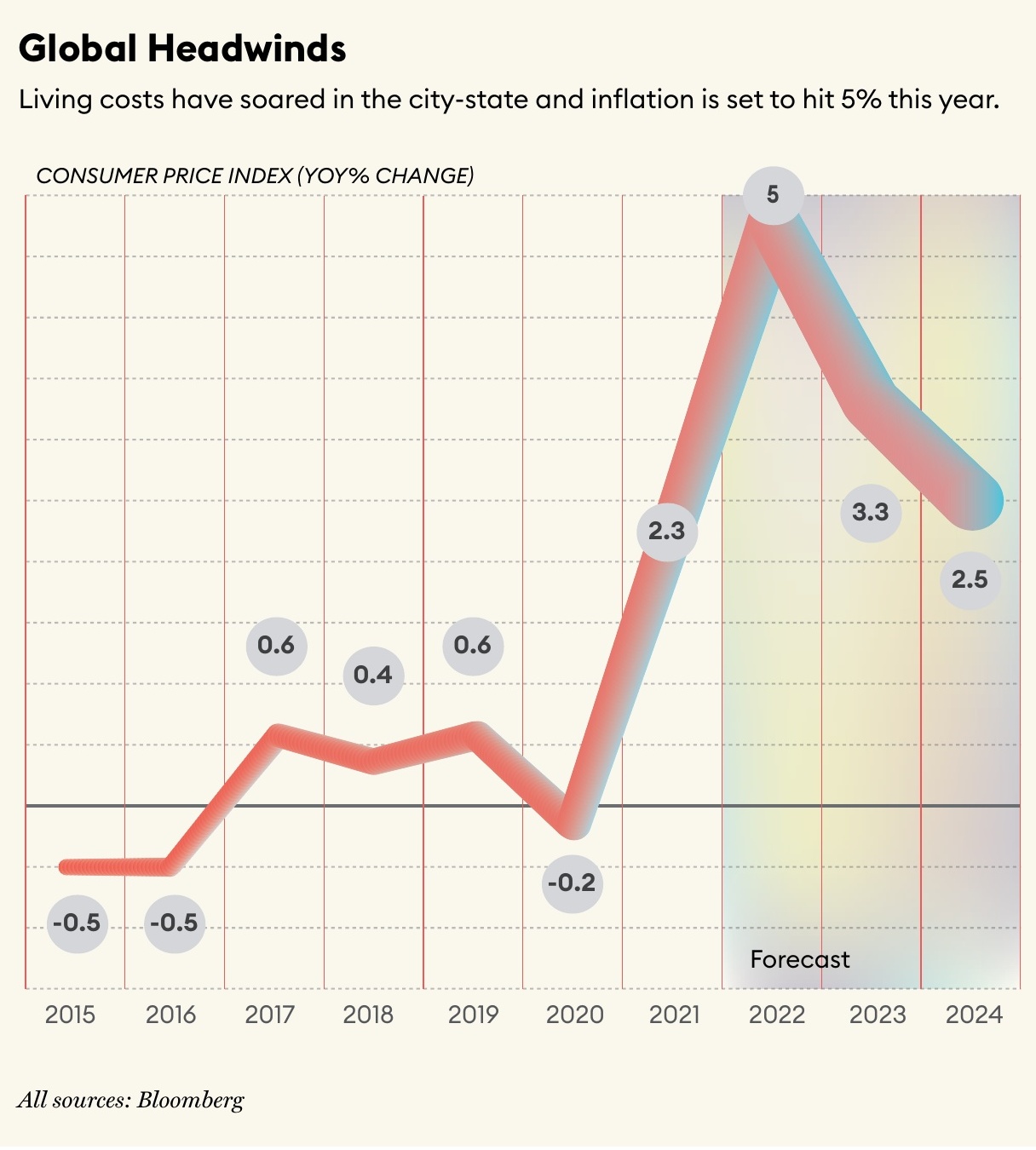
THE PROFILE
MIDAS TOUCH
VETERAN VENTURE CAPITALIST JENNY LEE MADE HER MARK BACKING SOME OF CHINA’S TOP TECH STARTUPS. NOW SOUTHEAST ASIA MAY OFFER HER SIMILAR EARLY-STAGE OPPORTUNITIES IN THE REGION’S FAST-GROWING DIGITAL ECONOMY.
BY JONATHAN BURGOS
PHOTOGRAPH BY JULIANA TAN FOR FORBES ASIA
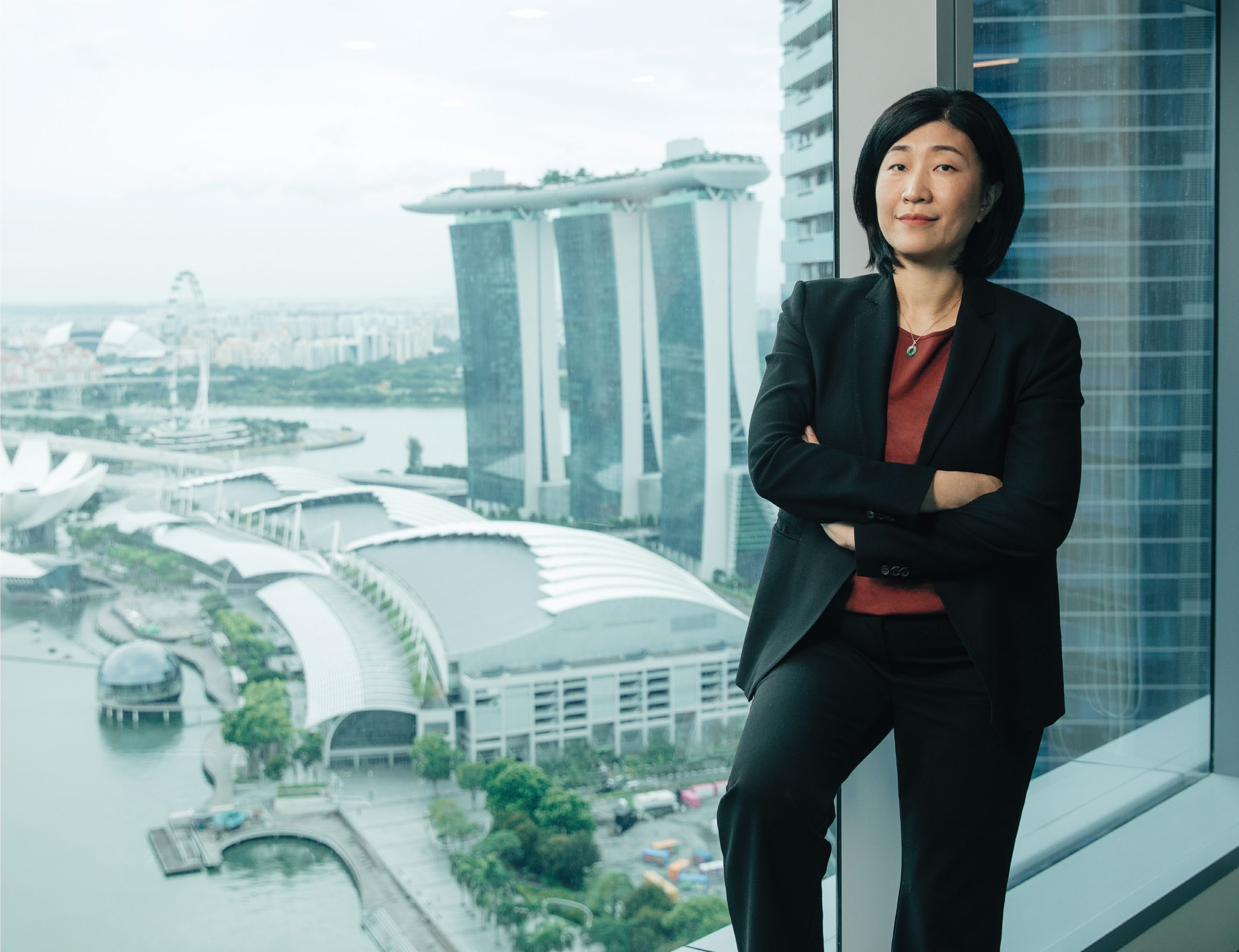
A s much of the world went into a standstill at the height of the pandemic in 2020, veteran venture capitalist Jenny Lee, 50, hunkered down in her hometown in Singapore to raise money for four new funds being launched by her firm GGV Capital. For four months, Lee barely slept as she made over 250 zoom calls that raised $2.5 billion—a process that usually takes six months—and all done remotely from investors around the world.
The funds raised by Lee and her team was the highest ever in GGV’s 22-year history, increasing the firm’s assets under management by 27% to an all-time high of $9.2 billion. Lee, who runs all of GGV’s U.S. dollar fundraising, takes pride in the results. “It’s all worth it,” Lee says in an interview in June at the GGV Capital office in Singapore. “If I can raise $10 million per call, I’ll do it every day.”
Investor confidence in GGV arises in no small part due to Lee, who has been named by Forbes as one of the world’s top 100 venture capitalists for 11 years in a row, from the first year she was included in the Midas List in 2012. “She has cemented her reputation as one of the most respected VC investors in the country—and the world,” it was noted on this year’s list. She was one of 12 women to be selected, and was only one of four 11 years ago. For her success, especially in a male-dominated field, she has also been included in Forbes’ list of the World’s Most Powerful Women three times and Forbes Asia’s Power Businesswomen list in 2019.
She is surrounded by top-tier VCs at GGV, of which she is one of six managing partners that run the company, including global managing partner Singaporean Jixun Foo, known for an early bet on regional superapp Grab. Another high-profile managing partner looking at investments in Asia is Hans Tung, a Taiwanese American who has been on the Midas List ten times. The others on the team bring expertise in areas such as U.S. investments, sector knowledge and hands-on entrepreneurial experience. The firm claims its funds have delivered an average annual gross IRR of over 25% since the company’s founding in 2000.
The 354 companies in GGV’s portfolio are balanced almost equally between those in Asia-Pacific and the Americas (GGV claims its investments include more than 85 unicorns). China is home to the highest number of Asian companies in the portfolio, with 77 investee companies listed on its site—only the U.S. has more investments, at around 130.
“IF I CAN RAISE $10 MILLION PER CALL, I’LL DO IT EVERY DAY.”

W hile Lee got her start as a venture capitalist at Morgan Stanley and Jafco Asia, it was in China where Lee cemented her reputation soon after she joined Menlo Park, California-based GGV to launch its office there in 2005. At the time it was GGV’s second overseas presence (the firm opened a Singapore office in 2000 and closed it 13 years later). It was an early sign of the firm’s confidence in Lee’s potential to pioneer a crucial market.
From a base in Shanghai, she and Foo spearheaded or were involved in a string of investments—usually at early low valuations—into what became some of China’s most important tech firms, such as TikTok owner ByteDance, electric vehicle maker Xpeng Motors and hand-phone maker Xiaomi. One of Lee’s flagship investments was in 2013 into Kingsoft WPS, a Chinese software maker, which so far has generated a whopping 55x return for GGV as of the latest calculation early this year. The ability of Lee and the team to be adept in identifying emerging technologies helped them pick future unicorns. “We’ve stayed very close to the forefront of technology to be able to understand what [the next big thing] could be,” she says.
Lee arrived in China just as it was transitioning from PC-based tech (internet cafes were all the rage) to a mobile-based tech ecosystem. To unearth investments, Lee and her China team used to tear apart smartphones, identifying the makers of critical internal components and then invest in them. One of these was China-based AAC Technologies, a key supplier of audio sensors for Apple’s iPhones. “As a result, we were able to invest in [companies] with cutting-edge technologies very early,” Lee says.
Lee also had to rise to the challenge of operating in one of the world’s toughest—and most promising—markets for venture capital. Although she had studied Mandarin while growing up in Singapore, she admits she struggled with the language upon arrival. What’s more, she represented a firm with no history in the country, and she had no network of contacts of her own. In a 2020 interview posted on the GGV site, she said: “We had to learn—learn to read business plans in Chinese [and] learn to understand the technical jargon.” The entrepreneurs she met helped too. “They were the ones who taught me to speak, how to use the right phrases in Chinese, and, of course, I helped them with their English.” Thus she found a way forward: “You go in fighting, you go in scared, knowing that you are starting at ground zero, at the base.”
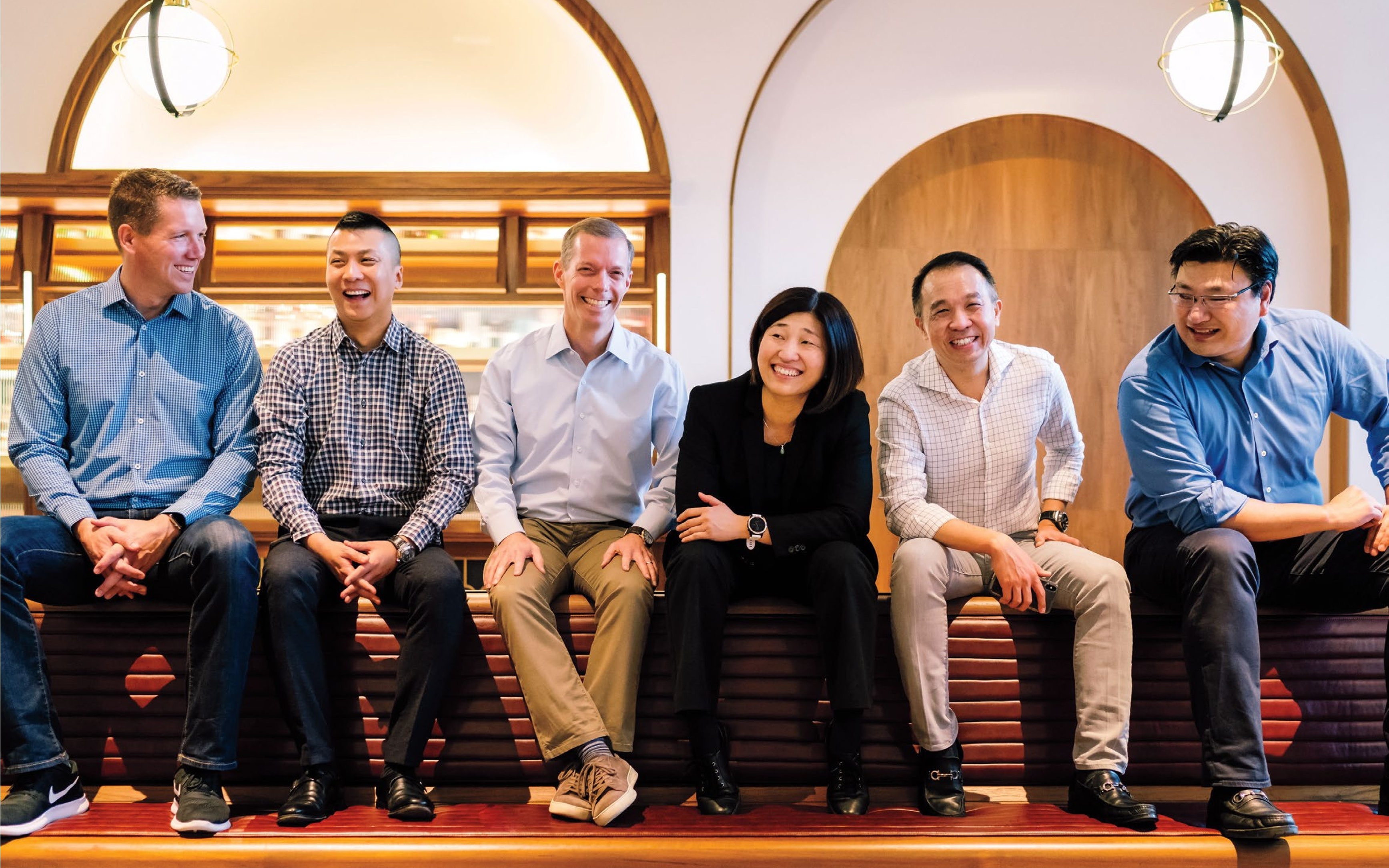
The six managing partners of GGV (from left to right) Jeff Richards, Eric Xu, Glenn Solomon, Jenny Lee, Jixun Foo and Hans Tung.
Another hurdle was China’s business culture. Back then, the economy was still cash-based, and credit cards and e-payments had yet to become commonplace. Lee had to carry cash in suitcases to pay staff, who “took that leap of faith to join GGV,” she said. “No one knew GGV.” In the same 2020 interview, she glimpsed the rigors of entrepreneurship in those early days: “In a way, I understand what startups have to go through.”
One early bet in 2005 was Chinese firm HiSoft (now Pactera), an IT outsourcing services firm in a sector dominated by Indian firms such as Infosys. To grow the company, she hired industry veteran and fellow Singaporean Tiak Koon Loh as CEO the following year. Loh—who previously managed Hewlett Packard’s IT outsourcing business in China—steered HiSoft through its Nasdaq listing in 2010, paving the way for GGV to exit with three times return on their investment. “Jenny felt that HiSoft could be a global business,” says Loh, who remains CEO. Pactera is now owned by the government firm China Electronics Corp. and is the mainland’s biggest IT outsourcing firm with annual revenues over $1 billion.
“YOU GO IN FIGHTING, YOU GO IN SCARED, KNOWING THAT YOU ARE STARTING AT GROUND ZERO.”
Finding HiSoft is an example of Lee’s adherence to deep due diligence. At the time, China’s government was supporting the IT sector with dozens of high-tech parks scattered around the country. Lee systematically visited them one by one, chatting up the directors to ask them to cherry-pick the top firms in their park, and then meeting with each of those companies. At a park in Dalian, she endured a boozy seafood dinner with rounds of powerful baiju liquor. At another, she joined in a golf game that led to signing a term sheet on the green. “It does take extra effort,” she has said. It paid off as HiSoft was among the companies she met.
Though her Mandarin and network needed a boost, Lee did bring to China a strong business and technical background. After growing up in Singapore, Lee went to the U.S. to earn a bachelor’s and master’s degree at Cornell, studying electrical engineering and graduating in 1995. The same year she got work as an aircraft engineer at Singapore’s ST Aerospace where she modified F-16 fighter jets. “Every day, I was out in the sun, hanging out with the technicians and the fighter jet pilots. It’s kind of fun actually,” she said in a GGV blog.
As a rising star in the state-owned defense contractor, the company sent her four years later to attend Northwestern University’s Kellogg School of Management where she earned an M.B.A. in 2001. But Lee had long nursed a desire to become a venture capitalist, so that same year, Lee quit her job to pursue her hidden passion.
It was a calculated risk as the global economy was going deeper into recession at the time—and it came with a hefty price. She paid ST Aerospace a penalty fee of $300,000 for not completing the company’s 11-year scholarship bond, which paid for her bachelor’s and master’s degree as well as M.B.A. Lee has no regrets. “It was actually the best move,” she says.
ADDING AUM
GGV Capital has grown its assets under management more than 50 times since its founding in 2000, under the original name of Granite Global Ventures, later shortened to GGV.
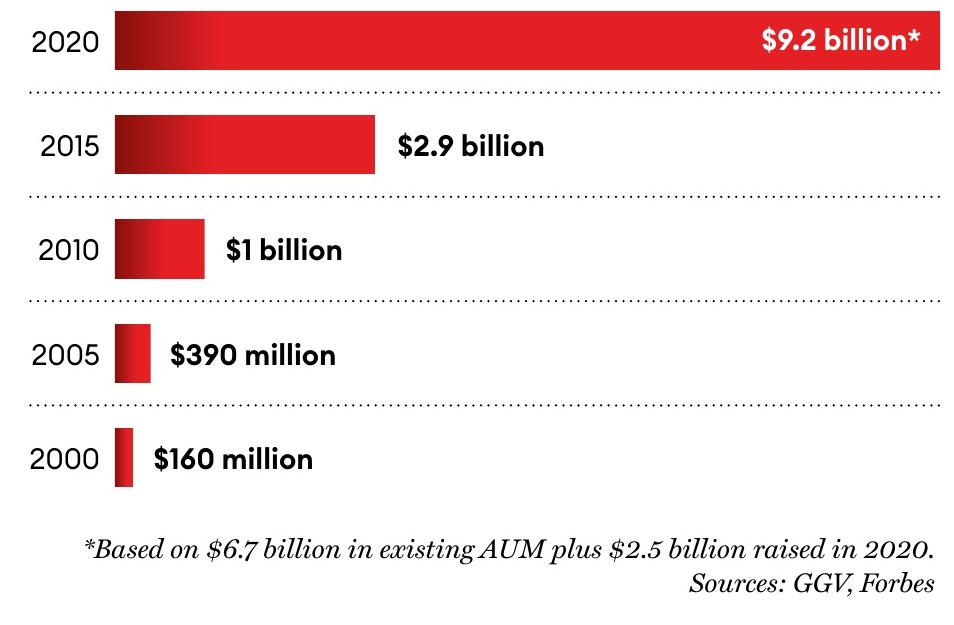
In 2019, Lee and Foo—who had been investing in Southeast Asia since 2005—decided to reopen GGV’s Singapore office, attracted to the region’s fast-growing digital economy that spawned many of today’s unicorns. The reopening was unfortunately timed mere months before the pandemic hit. One of the biggest priorities in the following year was her historic capital-raise, which GGV had not done in any major way since 2018, when Lee raised $1.88 billion.
The new office in Singapore signals the growing profile of Southeast Asia in the global VC industry, as China loses its luster amid a slowdown and tensions with Washington. Adding the Singapore office is an ideal perch for GGV to scope out promising startups and technologies across the region. The city-state also has its own impressive tech scene, with 12 unicorns and more than 9,300 startups, the highest of any Southeast Asian country, noted KPMG and HSBC in a July study. “Singapore stands at the forefront of Southeast Asia’s new economy,” it said. And just next door is Indonesia with its $1 trillion-plus economy and unicorns such as GoTo and Traveloka.
GGV has already deployed half of the $2.5 billion of its new capital from 2020. Among the Southeast Asian companies getting funded are Singapore’s fintech firm Thunes, alternative meats startups Next Gen Foods and Growthwell as well as edtech companies Ruangguru from Indonesia and Azota from Vietnam.
Lee added another feather to her cap when Temasek appointed her to its board in January as its youngest-ever member. With her role at the state-linked investment firm, she is fulfilling a vow made to her ex-boss at ST Aerospace, who told her when she resigned in 2001 that she “should come back when the country needs you.” Lee believes she can now add value to Temasek as it seeks to boost investments in innovative and emerging technologies across Asia and the world. “It’s an honor to come back to Singapore and contribute in ways that I can,” she says.
DIALLED IN
One of Lee’s more successful discoveries was cellphone maker Xiaomi before it had sold its first handphone. In 2010, GGV held an event in Shanghai to celebrate a decade since its founding. Alibaba’s Jack Ma attended as did Xiaomi founder and CEO Lei Jun. Lei and Lee already knew each other, but at the time he was an angel investor after he built two successful companies, one sold to Amazon and the other listed on the Hong Kong stock exchange. The two met at the event and Lei revealed to Lee his idea for a startup cellphone company, for which he had a primitive prototype. The pair wound up deep in conversation until midnight, after most of the guests had left. Lee came away from that meeting convinced Lei was worth backing, and recommended that GGV invest in the startup.
Lee became an angel investor first while GGV later bought a stake. “You could understand that he’s going to make a phone for the Chinese population that is going to have a better user experience,” she said in a Forbes interview in 2015. The bet paid off, and Xiaomi now ranks as one of the world’s top handphone makers and Lei’s net worth hovers around $10 billion. “Venture is sometimes about looking at the guy in his eyes and seeing his passion and his wanting to win,” she has said about that fateful meeting with Lei. As the controlling shareholder and chairman of Kingsoft, he also brought Lee her best startup investment in Kingsoft WPS.
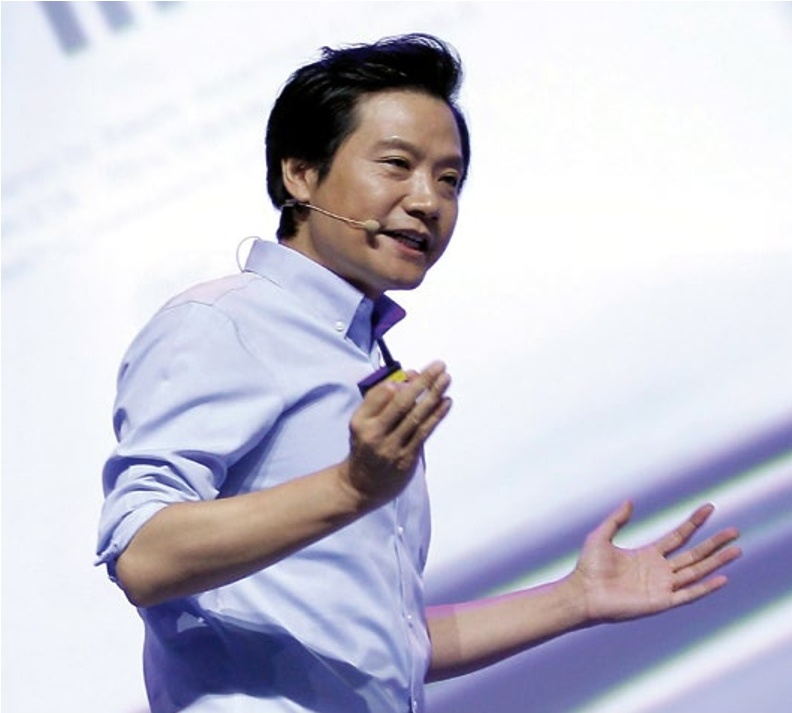
Xiaomi founder and CEO Lei Jun
COURTESY OF GGV CAPITAL; VCG VIA GETTY IMAGES
• TECHNOLOGY •
Reality Check
The maker of Photoshop and Premiere Pro gave the world AI-powered tools to create convincing fakes. Now CEO SHANTANU NARAYEN wants to clean up the mess.
By Aayushi Pratap
Photograph by Tim Tadder for Forbes

I magine a deepfake video of U.S. House Speaker Nancy Pelosi, in which her speech is intentionally slurred and the words she uses are changed to deliver a message that’s offensive to large numbers of voters. Now imagine that the technology used to create the video is so sophisticated that it appears completely real, rendering the manipulation undetectable, unlike clumsy deepfakes of Pelosi that circulated—and were quickly debunked—in 2020 and 2021. What would be the impact of such a video on closely contested House races in a midterm election?
That’s the dilemma Adobe, maker of the world’s most popular tools for photo and video editing, faces as it undergoes a top-to-bottom review and redesign of its product mix using artificial intelligence and deep learning techniques. That includes upgrades to the company’s signature Photoshop software and Premiere Pro video-editing tool. But it’s also true that to “photoshop” something is now a verb with negative connotations—a reality with which Adobe CEO Shantanu Narayen is all too familiar.
“You can argue that the most important thing on the internet now is authentication of content,” Narayen says. “When we create the world’s content, [we have to] help with the authenticity of that content, or the provenance of that content.”
So, three years ago, Adobe launched something called the Content Authenticity Initiative, starting with a handful of media and technology industry partners. It’s an enterprise that has grown to encompass more than 700 companies, with global events to publicize the push for “provenance,” as the 59-year-old Narayen calls it—in which designers and consumers of content can, if they choose to, create and track a digital trail that shows who is responsible for a given video or image and any changes they made to it.
Deepfakes are only one of Narayen’s headaches. Adobe posted $15.8 billion in 2021 sales (fiscal year ending December 3), but the San Jose-based company’s guidance missed Wall Street estimates in the last two quarters. Blame the usual suspects: rising interest rates, supply-chain snarls and business embargoes in Russia and Belarus. Since its peak of $688 a share in November, Adobe shares have plummeted 45% to a recent $375, versus a 25% drop in the Nasdaq. “The company is still growing, but they’re seeing significant deceleration,” says Cornelio Ash, analyst at William O’Neil & Co. Inc.
For years, Adobe has leaned on a suite of venerable flagship products, which it lumps together as its Digital Media group, to generate the bulk of its revenue. Products like Photoshop (first released in 1990), Illustrator (1987), Premiere Pro (2003) and Acrobat (1993) generated 73% of its revenue in 2021. But, despite a successful transition to the cloud, these businesses are slowing. The group’s annual recurring revenue has historically averaged around 20% growth, but in Adobe’s most recent quarter slowed to 15.5%, Ash says.
Then there is Digital Experience, launched in 2012. These are services Adobe provides to companies by analyzing their customer’s “digital footprints”—meaning tracking people’s behavior online—say, how much time they spend on a specific Web page and which products they view.
“If . . . you’ve been in engaging or interacting with a customer, and you still don’t act as if they know the customer, there is nothing more frustrating than that experience,” says Narayen. That is what the company wants to change with its Digital Experience business. While this is Adobe’s fastest growing segment, generating $4 billion in sales in 2021 up 24% year over year, it faces intense competition from the likes of Salesforce and Google.
“VERY SOON, BECAUSE AI CAN BE MORE POWERFUL THAN HUMAN EDITING, YOU’RE NOT GOING TO BE ABLE TO DISTINGUISH FACT FROM FICTION, REALITY FROM ARTIFICIAL REALITY.”
Adobe also faces growing competition from smaller rivals such as Australian graphic design platform Canva and U.S-based Docusign. “Adobe was a little late to respond to the market space that Canva pursued . . . a market space that was actually not professional designers,” says Chris Ross, an analyst at Gartner.
Much cheaper (starting at just $120 a year) and easier to use than Adobe’s offerings, Canva has quickly evolved into a real threat. After all, who wants to pay $600 a year for a Creative Suite subscription—and spend hours learning Illustrator—just to design a menu or a wedding invitation? In September, Canva, which is less than decade old, was valued at $40 billion. Melanie Perkins, its 35-year-old CEO, is currently worth an estimated $6.5 billion.
Adobe is responding. In December it launched Creative Cloud Express, a new application—even cheaper than Canva—aimed at novice users from students to social media influencers. More broadly, the company’s attitude is anything but complacent. Adobe has mounted a drive to reinvent all its products using artificial intelligence and deep learning techniques—an initiative known internally as “AI First”—which can make time-consuming edits in Photoshop possible within minutes rather than hours. “AI provides features like sky replacement, which is in one click of a button, you’re changing blue to gray,” says Dana Rao, Adobe’s general counsel and chief trust officer. “Then you can go in and make minute adjustments, but it’s a much faster task.”
In 2016, the company launched Adobe Sensei, a suite of features which, among other things, allows users to get rid of unwanted objects from video footage, smooth out skin tone, alter facial expression and change voice pitch with great ease.
Of course, the very same tools can make fiction look like fact. Rao recalls sitting with the company’s chief product officer, Scott Belsky, three years ago: “We were looking at all the innovations we had on AI editing, and we both had the same thought at the same time: Very soon, because AI can be more powerful than human editing, you’re not going to be able to distinguish fact from fiction, reality from artificial reality.
The content authenticity push is one response to that problem. Another is an extensive internal process, over which Rao presides, to subject new Adobe features and products to rigorous ethics reviews—a process that sometimes prevents the work of Adobe engineering teams from being released to the public. For example, says Rao: “On the imaging side, when we think about putting AI into our technology, we have to think about, was it trained across a diverse set of images, datasets, so that the output is respectful to all the kinds of people who use it.”
Abhishek Gupta, founder of the Montreal AI Ethics Institute, believes that attaching “truth labels” to content won’t make much of a difference. The partisan audience for altered content often wants desperately to believe it’s genuine—despite all indications to the contrary. “Fake content is tailored toward people having fast interactions with very little time spent on judging whether something is authentic or not,” Gupta says.
Ultimately, says Adobe’s Narayen, consumers themselves have an obligation to seek the truth—to use available tools to verify that the images and video they view, share, post and retweet are real. “They also have that responsibility, no different from any other responsibility that a consumer has—to make sure that they’re being protected.”








FEATURES
Bring It On
Jee Dong-seob AIMS TO HAVE SEOUL-BASED SK ON LEAD THE GLOBAL EV BATTERY MARKET BY 2030, BESTING SOME POWERFUL RIVALS FROM AROUND THE GLOBE.
BY CATHERINE WANG
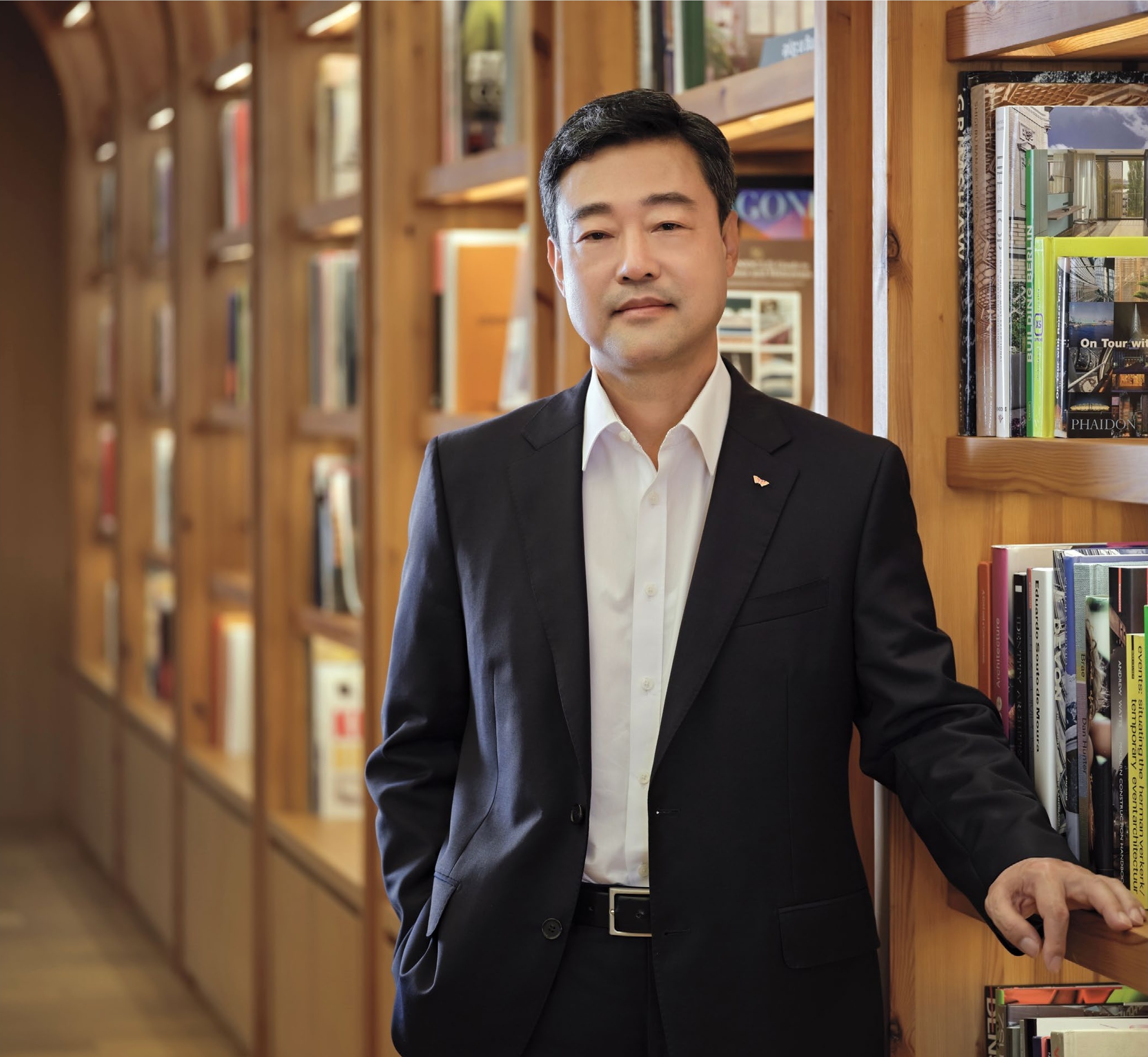
SK On co-CEO Jee Dong-seob has a simple but bold goal for his company: to become the world’s largest electric vehicle battery maker by output by 2030.
“We will definitely be on par with the number one, or be the world’s leading battery maker,” Jee says, 59, in an exclusive interview from Seoul. It’s his first-ever interview since taking charge. “We believe that we will be able to smoothly, without any major challenges, achieve our goal.”
SK On is currently the fifth-largest supplier of EV batteries in the world at a capacity of 13.2 gigawatt hours (or gwh, the standard measure for EV battery output), according to an August report by Seoul-based SNE Research. The company’s annual battery sales hit $2.3 billion in 2021, up from $1.2 billion a year earlier and $530 million in 2019, when the company ranked as the ninth-largest battery maker. “What really stands out is that we are the world’s fastest-growing battery maker,” says Jee.
It’s a strong track record for a company that didn’t exist three years ago. SK On was spun off as its own company last October from SK Innovation, a holding company for both traditional and alternative energy businesses under SK group, one of Korea’s largest chaebols. There’s still a long way to go. “Of course, our competitors are also working very hard,” Jee says.
Currently the world’s largest EV battery maker is China’s Contemporary Amperex Technology (CATL), which holds about 35% of the total global market. Headed by billionaire Robin Zeng, whose net worth exceeds $45 billion, CATL supplies batteries to BMW, Tesla and other major automakers. The Chinese battery giant is followed by SK’s crosstown rival LG with about 14%, China’s BYD at 12% and Japan’s Panasonic with 10%. SK On has about a 6.5% share, according to SNE data. Last year, SK On overtook its other big rival Samsung, which was formerly in the fifth spot but has been steadily losing its foothold.
The competitive landscape for these top producers may transform within the decade. SK On estimates that by 2030, the global EV market will reach 2.5 terawatt hours, worth at least $263 billion, or 31.3 million EVs, if each vehicle is equipped with a standard 80 kilowatt-hour battery. To meet its targets, SK On plans a major international expansion that hinges on “nurturing and managing” a global network of partnerships and factories, particularly in Europe, the world’s second-largest EV market. In March, U.S. automaker Ford and SK On formed a joint venture for an EV battery factory in Turkey. From 2025, the new facility will have an annual production capacity of between 30gwh and 45gwh a year. That’s only the beginning, says Jee.

SK On’s solid-state battery cell, set to be released in 2025.
T he Korean battery maker now has seven factories across Europe, China and the U.S. Its first plants outside Korea opened in 2020 in China, situated in Changzhou and Huizhou. SK On has two more plants slated to start operating in 2024, including one in Iváncsa, Hungary, and another in Yancheng, China. Some $3.5 billion has been earmarked for two more plants in China due to open by 2025.
Investing abroad may be money well spent. Overseas factories located close to major EV markets help battery makers cut the costs of conveying their products to EV assembly lines, says Sam Abuelsamid, principal analyst for e-mobility with Guidehouse Insights in the U.S. “Batteries are large, heavy and potentially dangerous to transport,” he says. “Localizing production to where the vehicles are going to be produced and sold can dramatically reduce logistics costs.” Most major Western automakers are investing directly into cell production, he added, including Ford, Stellantis and Volkswagen. SK On supplies all three.
SK On is scoping out the American market, where it already has a factory in the aptly named city of Commerce in Georgia. The U.S. is now the world’s third-largest EV market, accounting for 4.5% of global sales, behind Europe at 16% and China at 14%, according to the International Energy Agency (IEA).
In July, SK On officially started BlueOval SK, a joint venture with Ford Motor, which is the companion megaproject to Ford’s BlueOval City that will produce EVs. The partners plan to invest a total of $8.9 billion for mass-producing batteries at three new plants in Kentucky and Tennessee.Operations will start in 2025 at a total production capacity of four times SK On’s existing facilities in Georgia. A Ford website dubs the BlueOval project as “the largest ever manufacturing investment at one time by any automotive manufacturer in the U.S.”
In a recent statement, Ford CEO David Hahm said: “With the strong partnership between these two companies, we will secure unparalleled competitiveness in the global EV market.” SK On’s ties to Ford go back to 2018, when SK Innovation was tapped to produce nickel-rich batteries for the Ford Lightning electric pickup truck.
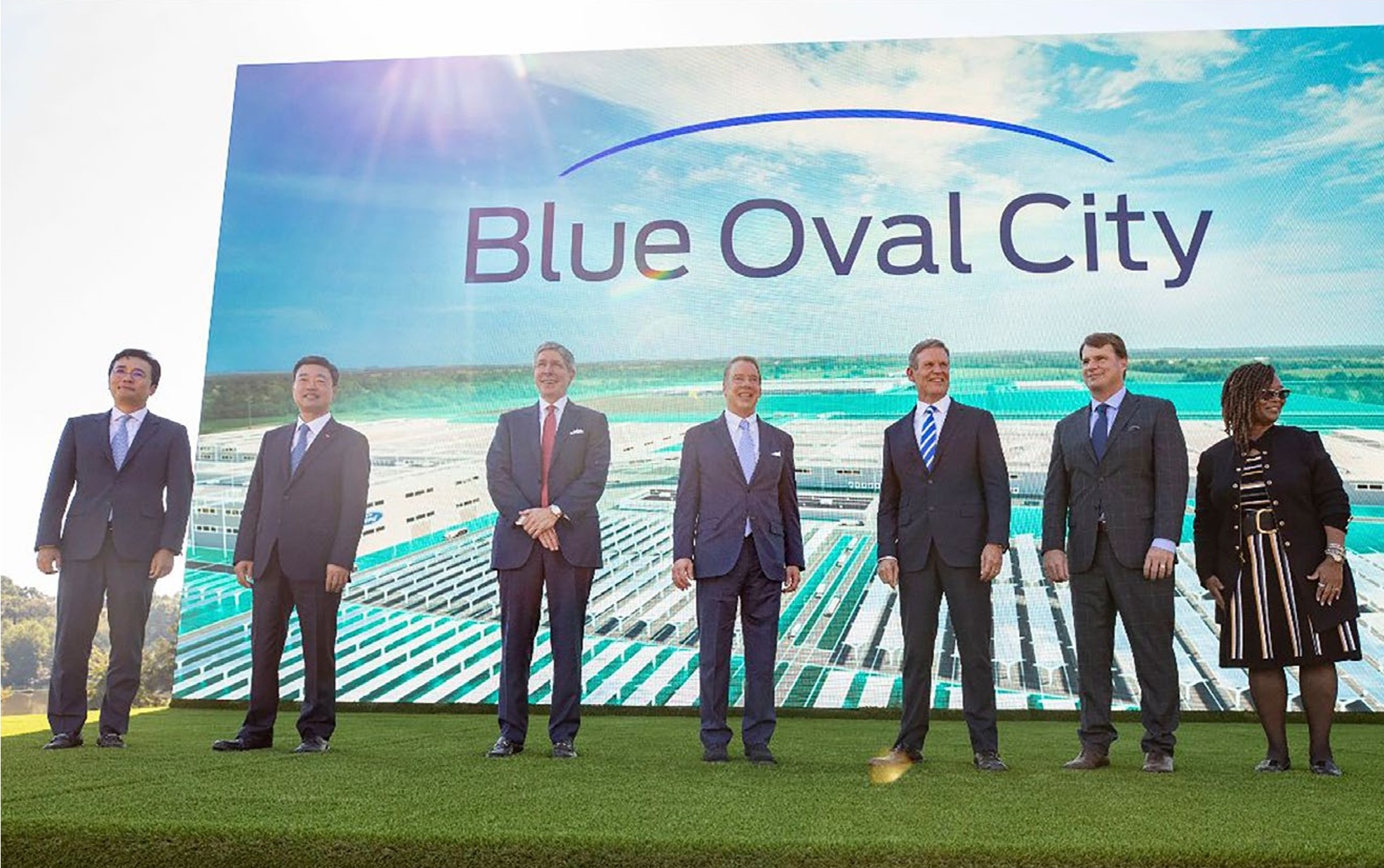
A year ago, Ford announced plans for two new mega-projects, BlueOval City and BlueOval SK, the latter a joint venture with SK. BlueOval City is spelled as Blue Oval City in the photo.
Y et SK On, like its peers, faces a volatile global market for rare earth metals—primarily cobalt, lithium, and nickel—that are the key components for batteries. The rapid increase in EV sales during the pandemic has strained the resilience of battery supply chains, according to a May report from the IEA, as demand for EVs threatened to outstrip the supply of raw materials.
Rare earth prices surged due largely to Russia’s invasion and ongoing conflict in Ukraine. Russia supplies 20% of global high-purity nickel, while Ukraine supplies 30% of the world’s lithium. By May, lithium prices were more than seven times higher than at the start of 2021, leading the IEA to forecast that batteries could be 15% more expensive in 2022. Nonetheless, oil prices have gone up as well, thus mitigating the comparative shock of higher EV prices. Governments around the world are subsidizing the cost of electric vehicle purchases for the environmental benefits, thus driving EV battery demand.
The CEO says SK On has racked up an enviable order backlog, a crucial indicator to support growth. The group’s confirmed EV battery backlog stands at 1,600gwh, equivalent to the installed capacity of approximately 20 million EVs, or approximately $176 billion in value per SK On’s estimates. But others have sizable backlogs as well, such as LG Energy Solution, which has an order backlog worth $231 billion, an LG spokesperson said in a March earnings call.

SK On is currently the fifth-largest supplier of EV batteries in the world.
Jee says what will propel SK On to the top spot is the company’s proprietary technology, the fruit of the SK group’s decade of battery research. SK On has said it will spend at least $1 billion over the next two years on research and development, with a particular focus on the company’s uniquely nickel-rich EV batteries. Their composition gives them a higher charging density than lithium-based batteries, making them more efficient and improving their range. “SK On was able to grow rapidly and secure an order backlog because the market recognized [our] battery technological capabilities and quality,” Jee says. In 2012, SK had a world-first in making EV batteries that were over 60% nickel.
Nickel has another advantage as there are none of the supply constraints currently hitting lithium and cobalt production. Nickel production was spurred well before the rise of EVs by its use in stainless steel, whose makers are still the largest buyers of nickel worldwide. SK On since January has been mass-producing a unique type of EV battery composed of 90% nickel, and those batteries power Ford’s new F-150 Lightning pickup truck—the electric version of its most popular vehicle, which was launched this year.
Jee is particularly proud of the fire safety of the company’s EV batteries, for which he says it has an unrivaled safety record. Of about 350 million battery cells manufactured, SK On says none have caught fire. The CEO credits this safety record to a unique separator technology, dubbed “z-folding,” that zigzags through the battery’s charging terminals to minimize fire risks. “I can tell you that you will never see a fire break out in our batteries,” Jee says.
Still, fires are extremely rare. The battery safety group EVFireSafe, which is backed by the Australian government, verified only 246 EV battery-related fires globally since 2010 in over 16 million EVs in active use.
SK On’s current portfolio includes nickel-rich batteries, lithium-ion batteries and LFP cells, a battery type that relies on a compound of lithium, iron and the chemical phosphorus. The batteries typically installed in cheaper vehicles have an energy density of around 60%, which means they require frequent charging. To overcome the challenge of battery endurance, the company is developing batteries that are solid rather than liquid-based, and batteries that are more compact than traditional EV batteries. Prismatic batteries offer stability for longer trips, while pouch batteries are more portable and can be used in smaller EVs.
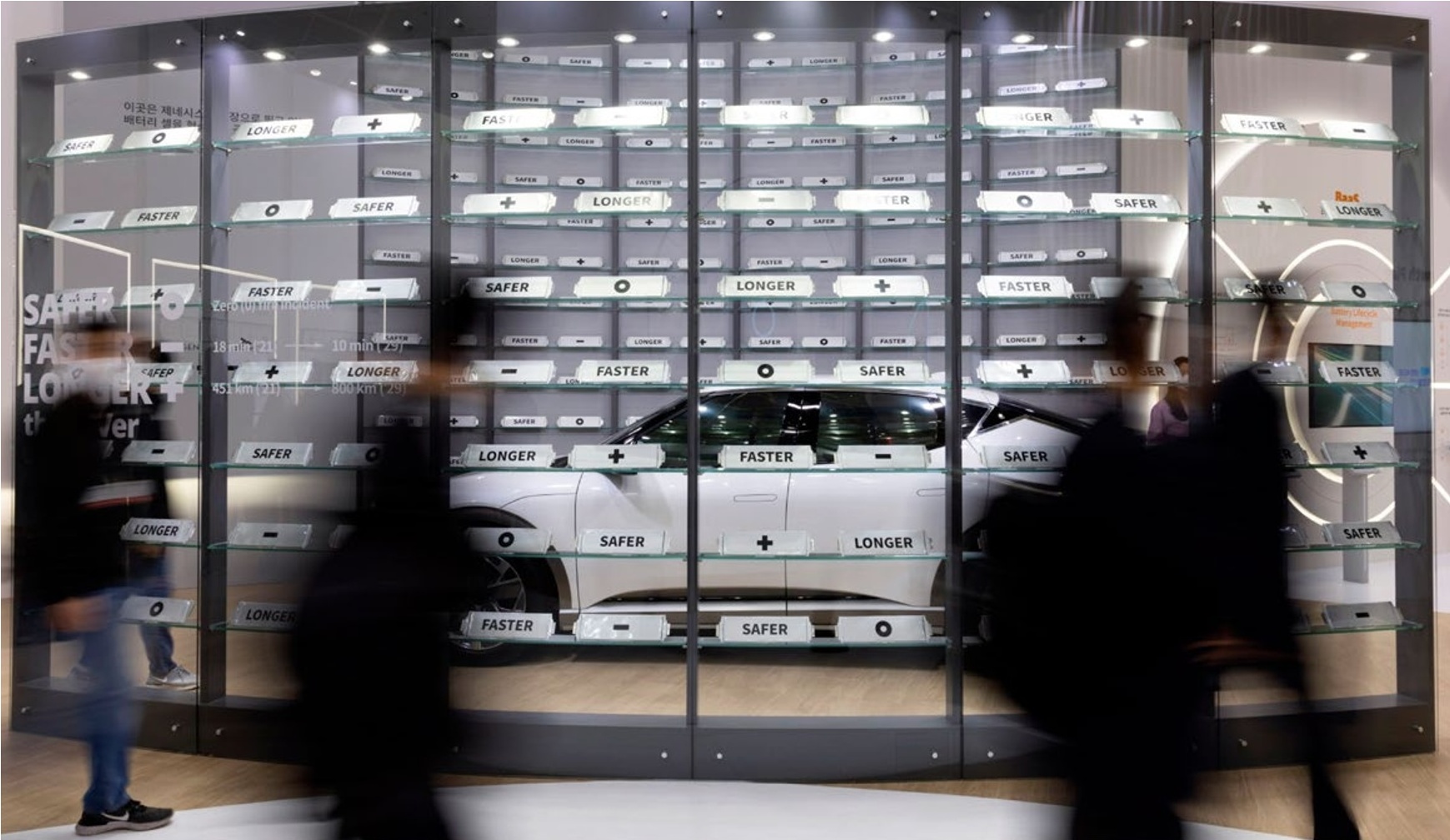
SK On battery cells for EVs on display in March.
O ver the past year, the pace of SK On’s growth helped expand the entire SK conglomerate. In May, Korea’s Fair Trade Commission said investment in “sustainable energy companies” helped SK become the second-largest corporate group in South Korea by asset size after Samsung, overtaking Hyundai Motors—the first change in rank among the country’s top five business empires in 12 years. SK On’s rise also underscores SK’s pivot into green energy—a radical transformation for an empire generating over half its business from oil and petrochemicals. The company is also important to billionaire Chey Tae-won. He chairs SK, which his family started and still controls. That significance is flagged by the fact that Chey’s younger brother, Chey Jae-won, is the co-ceo of SK On. The younger Chey was unavailable to comment.
Jee’s career has long been with SK. Born in Icheon, he received a bachelor’s degree in physics in 1987 and a master’s degree in economics in 1990 from Seoul National University. Upon graduation, he began working in the business planning department of Yukong, formerly known as Korea Petroleum, the country’s first oil refinery. Through a series of mergers, Yukong became part of the SK group. Jee progressed in management through SK’s divisions for telecoms, oil and energy, and battery making.
To fuel growth, SK On is looking to list by 2025. In March, local media reported that SK was in talks with private equity firms, including Carlyle Group and BlackRock, to raise $3.1 billion in pre-IPO funding. Two months later, SK On announced it had secured $2 billion in bank loans to expand business in Europe, which it said would improve its IPO prospects. A listing would be the latest among SK On’s peers, as LG Energy Solution held Korea’s largest public offering in January, raising $10.7 billion. SK Group’s battery-separator unit SK IE Technology fetched $2 billion for its listing in May.
Jee says SK On is already planning ahead, developing batteries for specific vehicles types. “There will be commercial vehicles—pickup trucks, for instance—that will be running on EV batteries for entry-model or the more low-cost EVs,” Jee says. The market will also evolve as the charging infrastructure becomes more widespread and accessible. Jee wants to position SK On to be able to grab emerging opportunities. It’s still “early stages for the EV market,” he says.
COURTESY OF SK ON; SEONGJOON CHO/BLOOMBERG; JON CHERRY/BLOOMBERG; EONGJOON CHO/BLOOMBERG

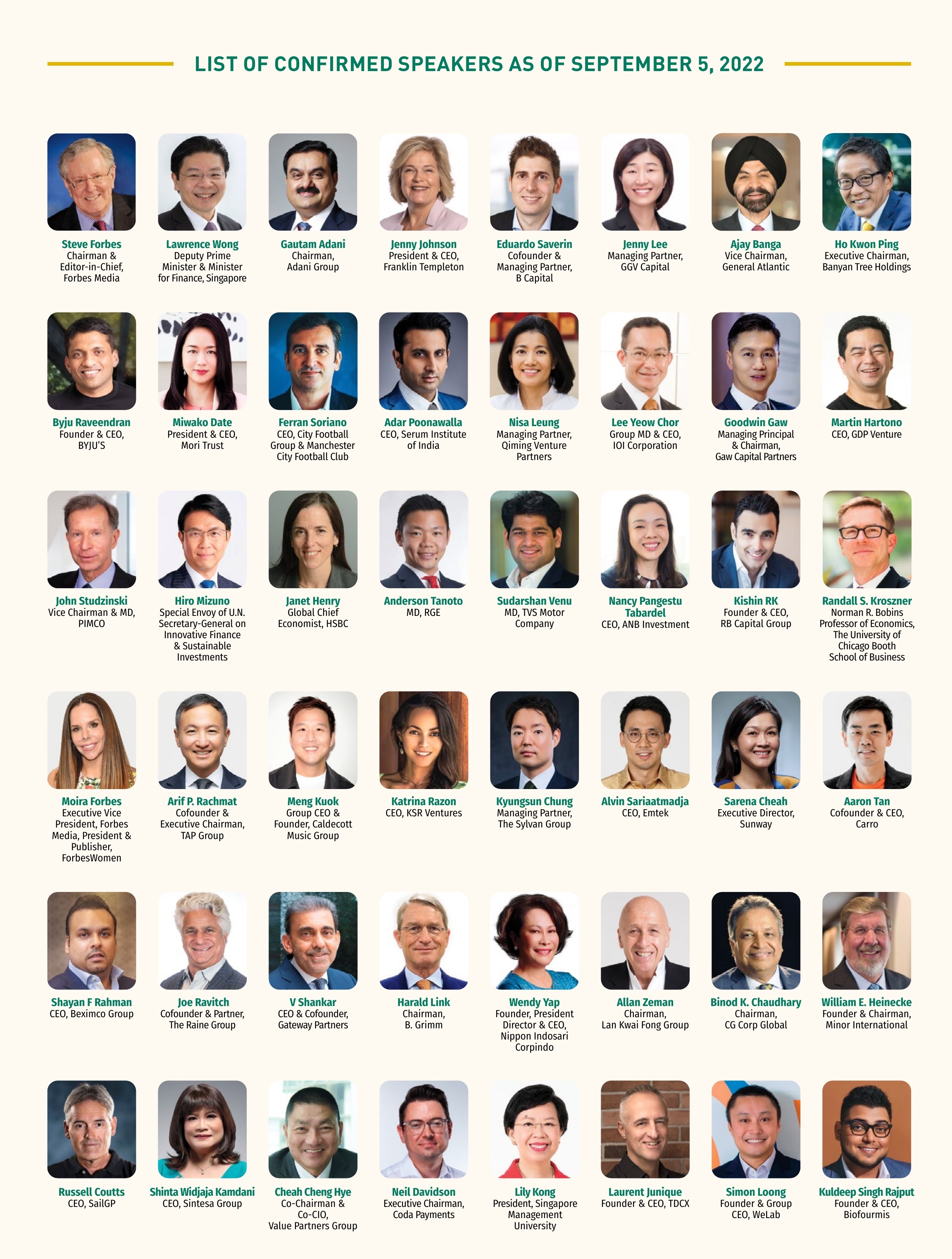
FEATURES
BETTING BIG
CHINA’S PROPERTY MARKET TURMOIL HASN’T DETERRED HONGKONG LAND’S CEO ROBERT WONG FROM TAKING AN $8.4 BILLION BET ON AN ICONIC SHANGHAI PROJECT—HE SAYS NOW IS THE TIME TO SEIZE OPPORTUNITIES.
By ZINNIA LEE
Photograph by KEN WU for Forbes Asia
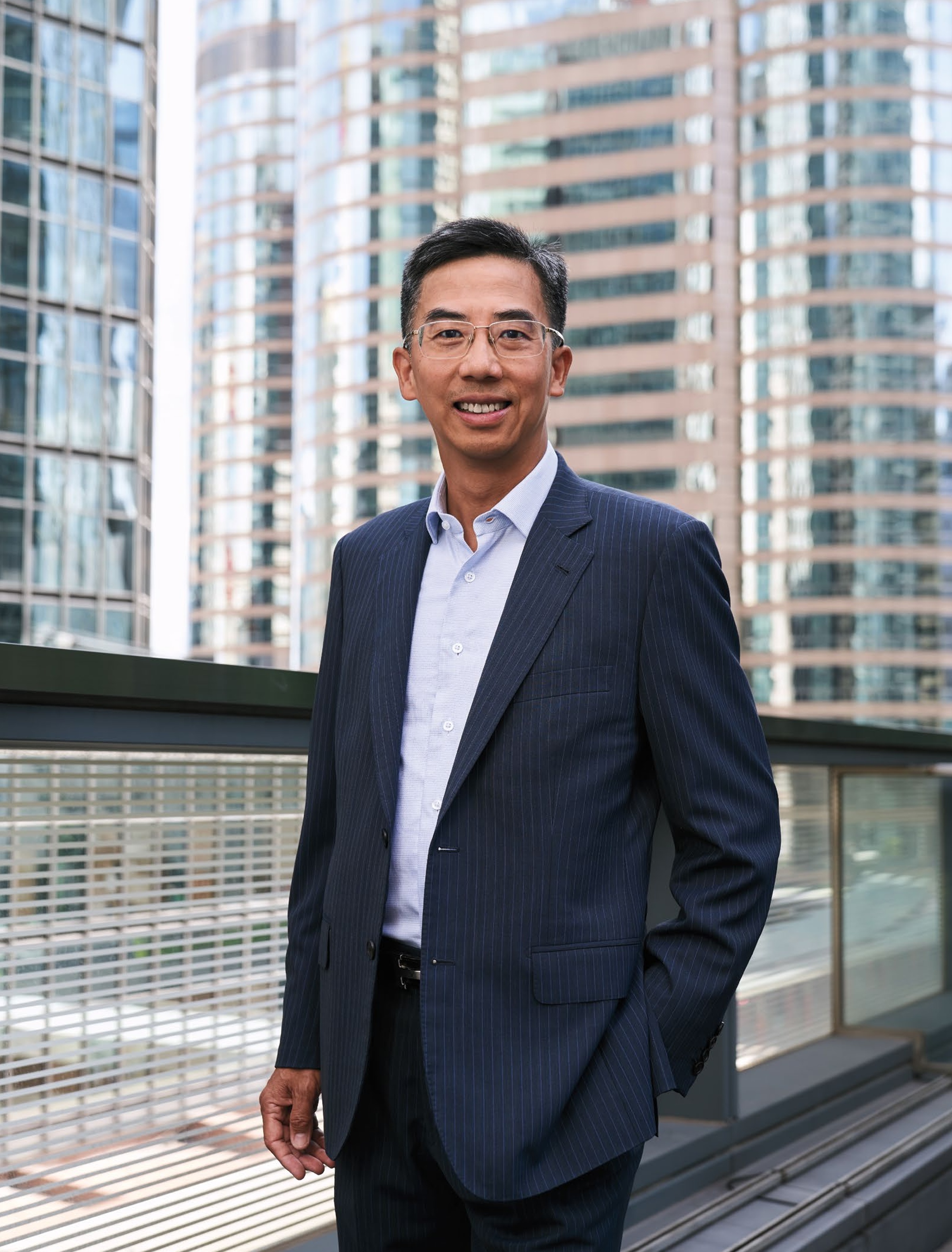
A t a time when few dare to invest in China’s beleaguered property market, Hongkong Land CEO Robert Wong is doubling down. Over the past two years, the developer has made its largest-ever investment commitment in its 133-year history to transform the riverfront south of Shanghai’s city center into a new financial hub, while also adding residential projects in select Chinese cities.
In February 2020, when Covid-19 gripped China and was spreading globally, the company acquired a 231,300-square-meter site in Shanghai for $4.4 billion, which it is now developing at a total cost of $8.4 billion as part of a joint venture. The following year, even as several leading Chinese developers started showing financial strain, Hongkong Land bought eight new residential sites to build mostly mid- to high-end homes, boosting its mainland portfolio to 35 projects across seven cities as of December 2021.
“One should not be put off by short-term fluctuations,” Wong, 61, says in an exclusive interview at the company’s Hong Kong headquarters in late June. “When opportunities come, we should be brave and grab them.” While many property counterparts have shelved investment plans following Beijing’s crackdown on excessive borrowing that has spiraled into a debt crisis, Wong has almost doubled Hongkong Land’s investments across Asia to an average of $3.3 billion over the past two years from the pre-pandemic level of $1.8 billion, including strengthening the company’s core portfolio in Hong Kong and expanding its Southeast Asian footprint.
The crown jewel of Asian conglomerate Jardine Matheson, Hongkong Land has overcome many challenges through its long history. From surviving the Japanese occupation of Hong Kong during WWII to the 1997 Asian financial crisis and beyond, the company has helped shape the city’s famous skyline and turned Central into one of the world’s most prestigious business districts.
The Singapore-listed company has often found silver linings in dark economic times. Its Exchange Square, which houses the Hong Kong Stock Exchange as well as global banks and law firms, opened during Hong Kong’s stock market collapse in the 1980s. After the 1997 financial crisis, Hongkong Land took advantage of depressed prices to snap up sites in Southeast Asia, allowing it to become a major regional developer. However, with mainland China’s prolonged property market slump and a wave of defaults by leading local developers including China Evergrande Group and Sunac China Holdings, coupled with rising vacancies in Hong Kong amid tough Covid-19 restrictions, Hongkong Land once again faces turbulence.
HONGKONG LAND HAS OVERCOME MANY CHALLENGES THROUGH ITS 133-YEAR HISTORY.
Wong—who joined the company in 1985 after graduating from Hong Kong Polytechnic University as a surveyor and rose through the ranks to become the CEO six years ago—has earned a reputation for seizing opportunities and staying the course amid a crisis. At the turn of the millennium, between the Asian financial crisis and the 2003 SARS outbreak, he started rebuilding from scratch Hongkong Land’s residential property business, which it had divested in the 1980s.
His first project, a redevelopment of an aging Hong Kong apartment complex called Lai Sing Court, had a bumpy start. After Wong spent more than two-and-a-half years persuading at least 90% of homeowners to agree to a collective sale and overcame objections from authorities to relax its height restriction, SARS crashed Hong Kong’s property market. Charles Ng, one of Lai Sing Court’s homeowners, recalls Wong still honored his commitments—even though he could have tried to renegotiate—and pressed ahead with the redevelopment despite an economic slump at the time making the project uneconomical. Hongkong Land eventually earned a profit of about $300 million from the complex, which was renamed Serenade.
Wong is once again confident that Hongkong Land’s investments in mainland China and measures to enhance the appeal of its Hong Kong portfolio amid the current market uncertainty will reap dividends. The company’s earnings and stock performance reflect his optimism. In the first half of 2022, revenue edged up 0.9% from a year earlier to $894 million despite a 69% drop in contracted sales on the mainland to $419 million, and it swung to a net profit of $292 million from a $865 million net loss in the year-ago period, Hongkong Land said in its latest earnings report.
Underlying profit, its measure of income from ongoing businesses, rose 8% to $425 million, but the company expects it to drop “significantly” for the full year following pandemic-related construction delays. The developer’s stock has risen around 15% in the past 12 months as of Aug. 25, compared with declines of roughly 26% and 30% in rivals Henderson Land and New World Development, respectively, and an over 21% drop in the benchmark Hang Seng Index.
Wong believes the Shanghai joint venture—in which the company holds a 43% stake, and which includes a mainland-based investor and a government-held special purpose vehicle—possesses the attributes to be a success. The project will deliver a gross floor area of 1.1 million square meters, equivalent to about 110 Manhattan city blocks, along the West Bund riverside. It will offer 650,000 square meters of grade A offices, 230,000 square meters of luxury retail space, 1,700 high-end residences and serviced apartments, two five-star hotels, an exhibition and conference center, and a 1.4-kilometer waterfront with green spaces, according to company presentations and Wong.
“If we had not acquired that site, it would likely have been split into parcels and sold to different people. The opportunity would have been lost forever, no matter how much could have been paid in the future,” Wong says. “Looking back now, it was absolutely the right decision.” Hongkong Land’s bet is showing early signs of paying off with some companies and retail brands incorporating the project into their spending plans for the next three to five years, Wong adds. S&P Global Ratings analyst Oscar Chung expects the project to start contributing to Hongkong Land’s cash flow in 2022 and 2023, with the commencement of pre-sales of the residential portion. “While the pandemic remains an uncertainty for the near term, we think the West Bund project is well situated in Shanghai,” says Chung.
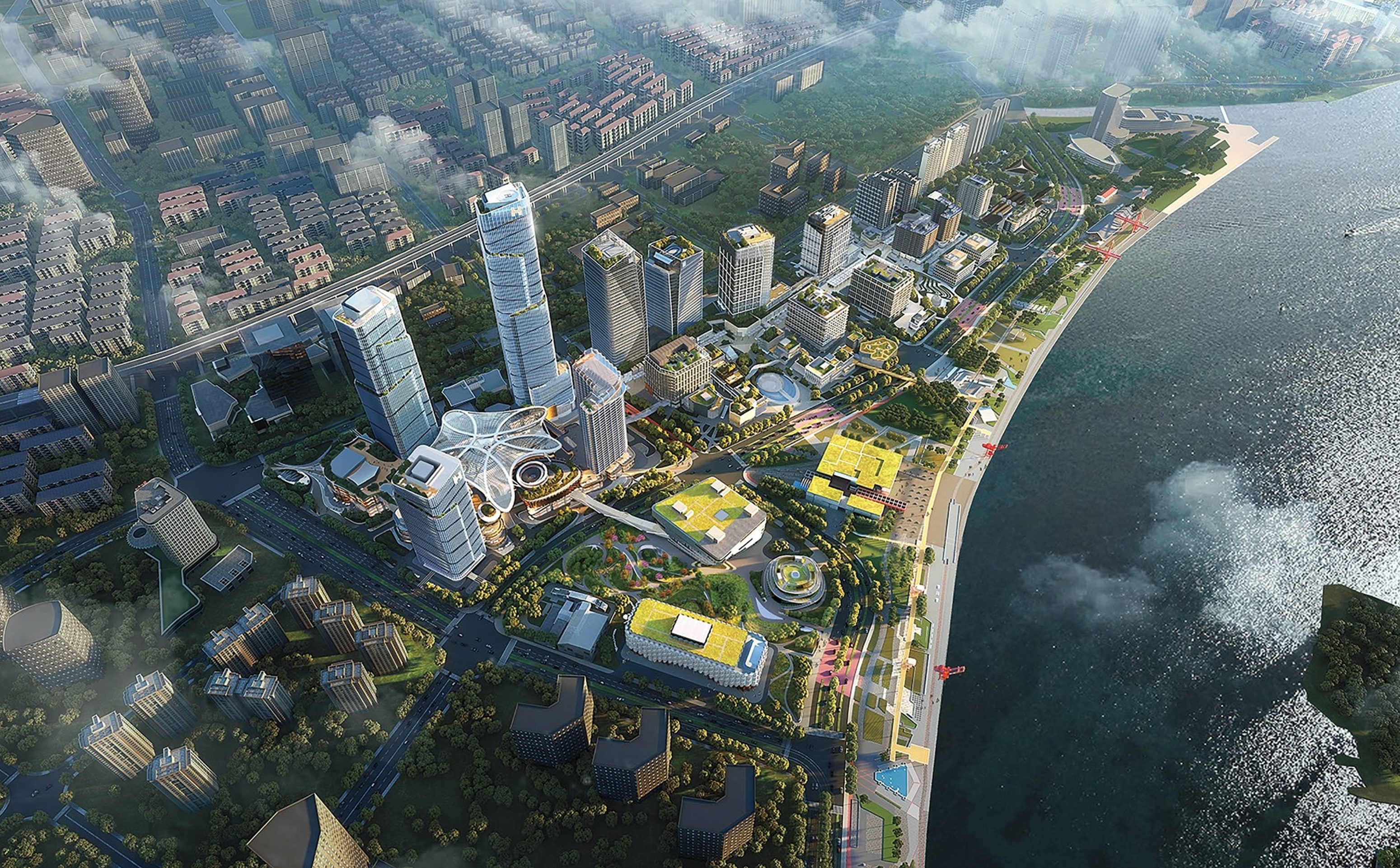
Shanghai West Bund financial hub (artist’s rendering). The project will deliver a gross floor area of 1.1 million square meters.
Shanghai’s economy shrank almost 14% in the second quarter and retail sales slumped 21% year on year, government data show, as China’s zero-tolerance approach to Covid-19 forced the commercial hub into a lockdown from late March to end-May. China’s top policymaking body in late July reaffirmed its commitment to stanching future outbreaks through mass testing and movement restrictions, despite the country recording its weakest economic growth in over two years.
Meanwhile, the mainland’s property crisis has deepened with frustrated homebuyers of at least 328 stalled housing projects across 100 cities threatening to withhold mortgage payments, according to data on software development platform GitHub as of Aug. 25. Most projects belong to debt-saddled Chinese developers, including billionaire Hui Ka Yan’s Evergrande and Sun Hongbin’s Sunac, that have struggled to complete pre-sold apartments amid lockdowns and liquidity woes. S&P has forecast that in a worst-case scenario, Chinese banks could face $350 billion in mortgage losses.
Wong says his strategy of focusing only on seven Chinese cities—including Chongqing, Shanghai and Nanjing—and building quality homes, has kept Hongkong Land out of trouble. “The market dynamics are changing in China. In the past, you only needed to have the courage to take action because after that, rapid urbanization would have saved you anyway,” he says. “As urbanization slows, you need to do it right as people nowadays are looking for a flight to quality.”
While the Shanghai project has increased the developer’s debt in recent years, leverage remains relatively low. Hongkong Land’s net debt stood at $6.1 billion as of June 30, up from $5.1 billion at the end of 2021 and $4.6 billion at the end of 2020 as it increased borrowings to buy land, and cash declined due to lower residential pre-sales and share buybacks. Though net gearing climbed to 18% from 15% at the end of last year, it was a fraction of the 177% for Evergrande estimated by JPMorgan. Both Moody’s and S&P have maintained Hongkong Land’s credit ratings of A3 and A, respectively.
Asia Footprint
HONGKONG LAND OWNS MORE THAN 850,000 SQUARE METERS OF COMMERCIAL PROPERTIES AND HAS ABOUT 11 MILLION SQUARE METERS OF DEVELOPABLE AREA AS OF 2021.
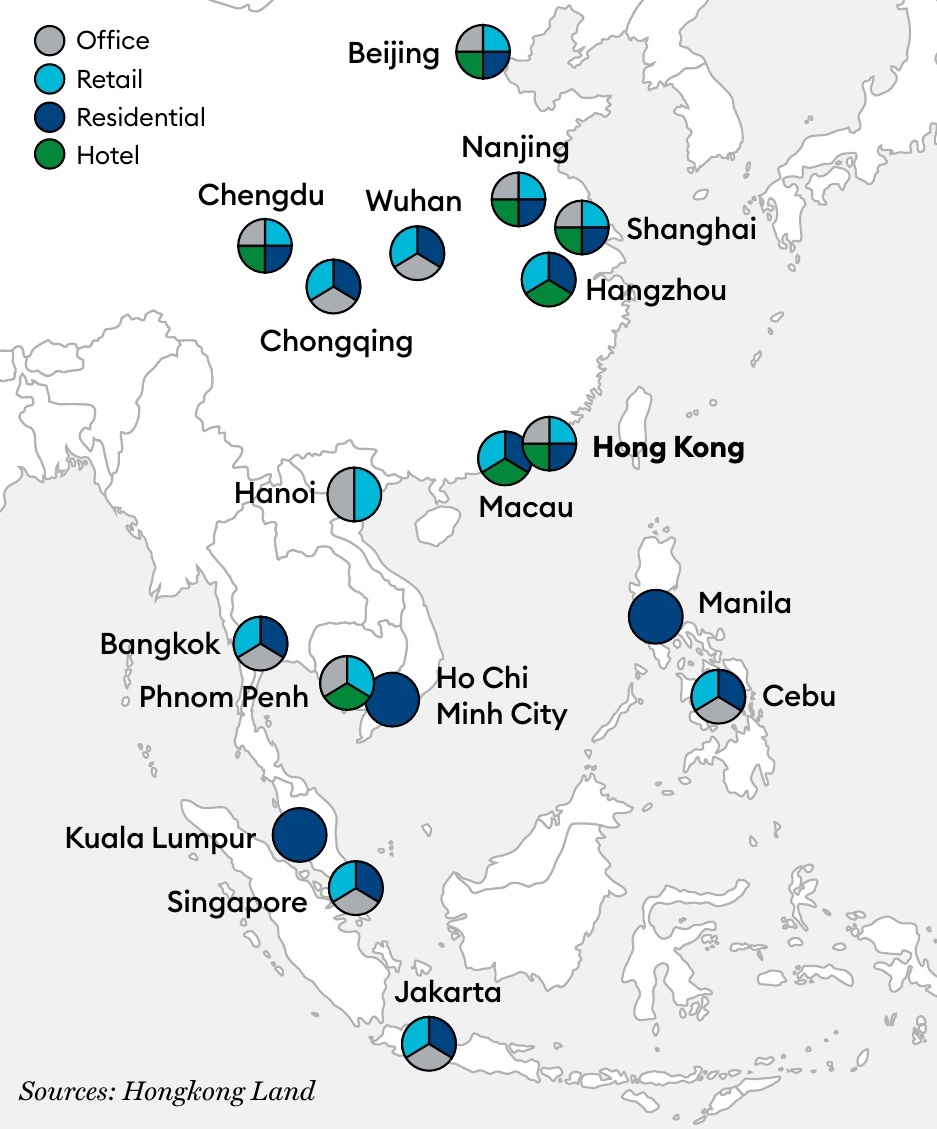
H ongkong Land is also bolstering its foothold in Southeast Asia, particularly in Singapore where it codeveloped the Marina Bay Financial Center and One Raffles Quay. In 2021, it acquired three new residential plots in the city-state, which will be developed jointly with billionaire Kwek Leng Beng’s City Developments. The projects are among Hongkong Land’s 18 developments in the pipeline in Southeast Asia, including a high-end condo codeveloped with Jardines’ Indonesian unit Astra International.
In Hong Kong, which accounted for 67% of its property assets and contributed 49% of its underlying profit in 2021, the developer has minimized vacancies at a time when the number of empty offices is soaring. The city’s overall office vacancy rate is forecast to climb to 13.5% by end-2022 from 10.9% and 11.2% in the first and second quarters of the year, respectively, as new supply comes on the market and leasing demand dwindles, real estate services firm Colliers said in a July report. The new developments include two prime offices built by billionaire Li Ka-shing’s CK Asset and Lee Shau Kee’s Henderson Land, which are set to be launched a few blocks away from Hongkong Land’s commercial cluster in Central next year.
Hongkong Land has refreshed its decades-old Central portfolio by launching a flexible working space and transforming basements into modern food courts and pop-up stores. The portfolio saw its vacancy rate on a committed basis edge up to 5.1% at the end of June from 4.9% six months earlier, according to its latest earnings report. That’s lower than the overall average of 7.9% in Central and reflects the portfolio’s resilience, according to S&P analyst Ricky Tsang.
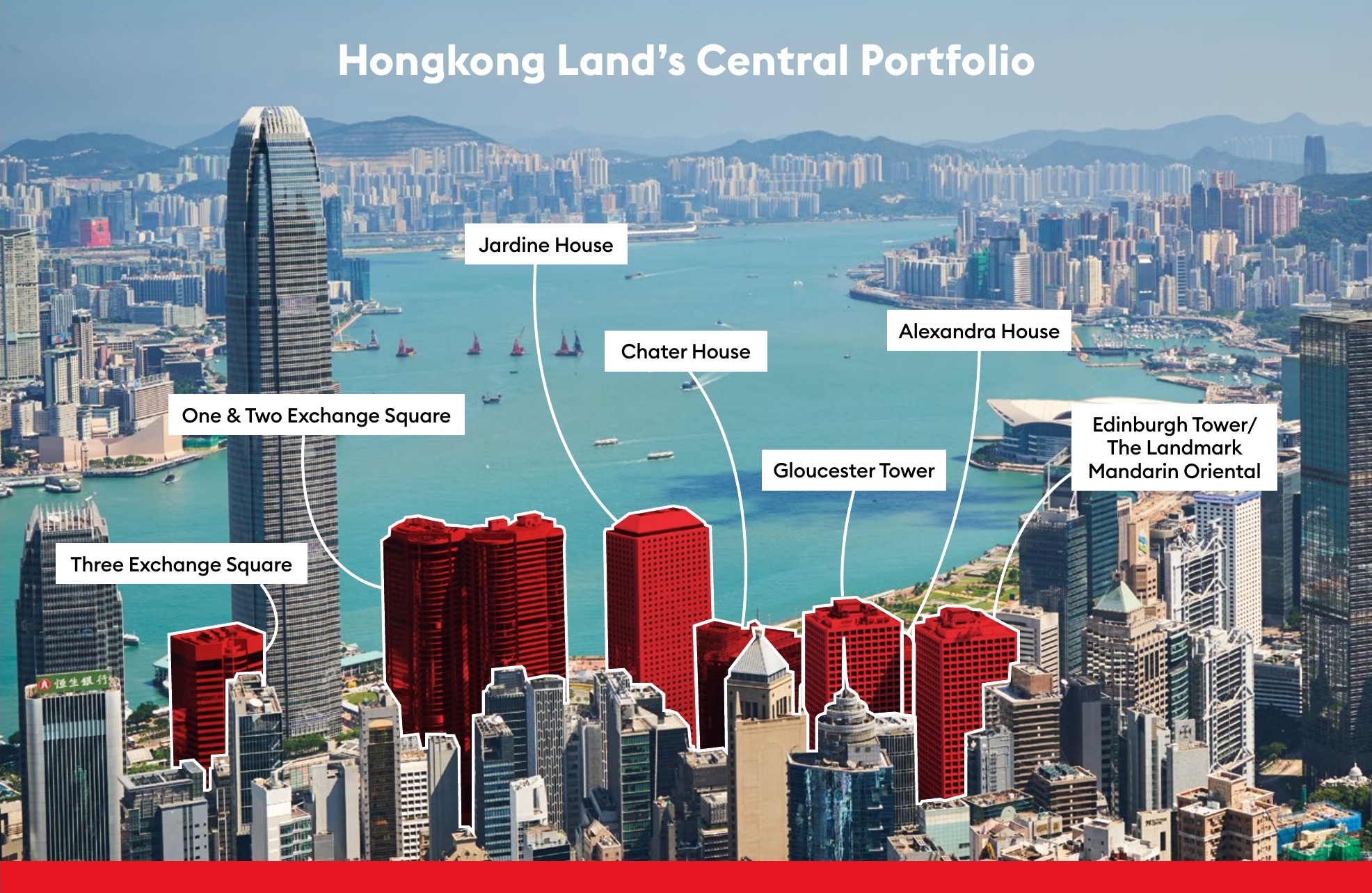
Wong credits the company’s relatively low vacancies to its ability to retain its biggest tenants and a flight to quality amid declining office rents. The top 30 tenants occupying almost half of Hongkong Land’s office portfolio in Central had a weighted average lease expiry of 5.6 years as of June. Its major office tenants include JPMorgan, KPMG, Mayer Brown, PwC and the Stock Exchange of Hong Kong. On the retail side, Hongkong Land has Giorgio Armani, Hermes, LVMH and others as tenants.
While Hong Kong’s lingering travel restrictions and recent crackdown on political dissent risk diminishing its global financial hub status, and the mainland’s property woes deepen despite Beijing’s resuscitative efforts, Wong remains upbeat on the company’s two most important markets. He believes the Chinese government’s efforts to deleverage mainland developers will help restore the long-term health of the sector and create new opportunities.
“While we need to be prudent during difficult times, we should not be overly conservative,” Wong says. “We should still seek out and explore opportunities. With crisis comes opportunity.”
—With assistance by Robert Olsen
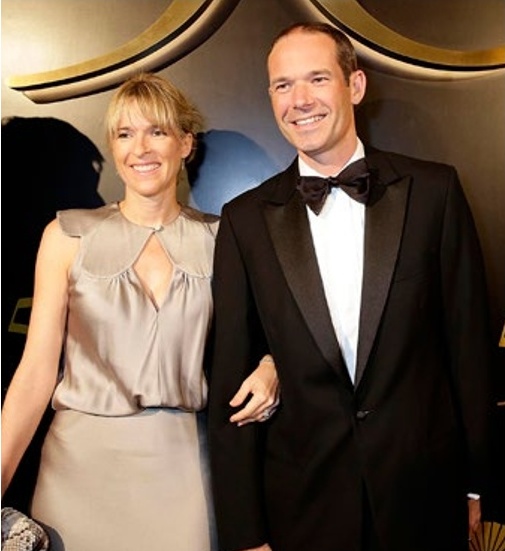
Martha and Ben Keswick
Iconic Empire
Founded in 1832 by British merchants William Jardine and James Matheson as a tea and opium trading house, Jardine Matheson group’s history is intertwined with Hong Kong’s. From its role in triggering the First Opium War (1839-42) that led to the city’s surrender to imperial Britain to becoming today’s diversified conglomerate, Jardines has helped shape Hong Kong’s destiny.
However, in a move that raised eyebrows in London and Beijing, Jardines moved its listing from Hong Kong to Singapore in 1994, three years before the former British colony returned to Chinese sovereignty, while remaining headquartered in Hong Kong. With businesses ranging from property development to hospitality, car dealerships, heavy engineering, financial services and logistics, Jardines generates more than $109 billion in revenue and employs over 400,000 people.
Last year, it delisted its second-largest business unit, Jardine Strategic, in a $5.5 billion buyout. The restructuring untangled Jardines’ complex cross-shareholding structure that was set up in the 1980s to defend it against hostile takeovers following an attempt by Li Ka-shing, Hong Kong’s richest man, to acquire Hongkong Land.
For most of its 190-year existence, Jardines has been helmed by the Keswick family. It is currently headed by Ben Keswick, 49, who took the reins as executive chairman from his uncle, Henry, in 2019.
COURTESY OF HONGKONG LAND; FRASER HALL/GETTY IMAGES, COURTESY OF HONGKONG LAND

THE INVESTIGATION
DOUBLE VISION
In 2020, Adam Neumann’s family office became a lead investor in real estate tech company Alfred. Less than two years later, the ex-WeWork CEO announced a new venture, Flow, with $350 million in funding. Its similarities to Alfred’s business raise questions about Neumann’s motives—and concerns about possible conflicts of interest.
BY IAIN MARTIN, ALEX KONRAD AND CYRUS FARIVAR
Illustration by STEPHANIE JONES for Forbes
Photograph by JAMEL TOPPIN for Forbes
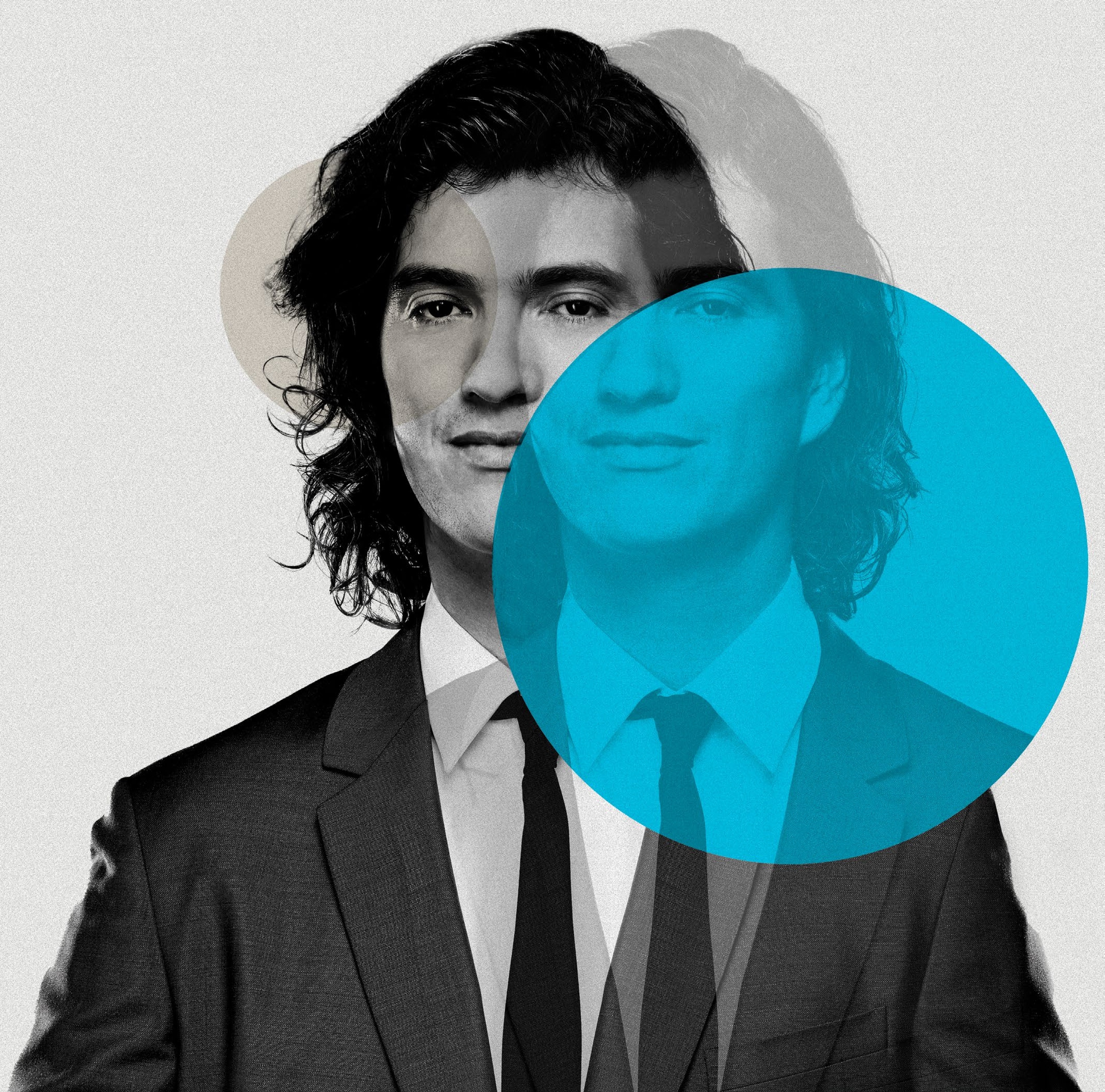
W hen staff at real estate startup Alfred arrived at work last month, they were surprised to discover that their largest investor, former WeWork CEO Adam Neumann, appeared to have started a rival company—and raised $350 million to compete against them.
Flow, Neumann’s splashy but mysterious new real estate venture, was aiming to build “the future of living,” influential venture capitalist Marc Andreessen wrote in a blog post announcing the investment. Alfred’s motto—“welcome to the future of living”—sounded uncomfortably similar.
Neumann—who still owns about 10% of WeWork, the coworking company he cofounded in 2010—helped New York-based Alfred with a $20 million capital injection at the start of the pandemic, and then invested again in 2022. Through his family office 166 2nd Financial Services, Neumann representatives held two board seats at Alfred from October 2020 until May 2022.
But interviews with eight sources who have knowledge of Alfred and Neumann’s operations show this isn’t a typical investor relationship. Neumann distanced himself from Alfred after he no longer would have a way to gain full control of his portfolio company, and then launched a startup that appears to compete with its product.
An investor potentially launching a competitor after growing concerned about a portfolio company’s direction, or becoming convinced they could better address a similar opportunity themselves, isn’t unheard of in Silicon Valley. But as lines blurred between Neumann’s business interests, the former WeWork cofounder appears to have laid the groundwork for an Alfred challenger before he began to extricate himself from his portfolio company. Forbes estimates Neumann still owns more than 10% of Alfred.
“I worry he’s been given an unfair advantage,” said one ex-Alfred employee. “Will he be a grownup here? If he scorch-earths [Alfred], that would be really awful.”
Founded by Harvard Business School classmates, and former McKinsey consultants Marcela Sapone and Jessica Beck, Alfred originally offered an app-based concierge for the millennial set, which allowed residents to book home services like laundry and grocery pickup. It then expanded to work with landlords at upscale properties to offer those services as an amenity.
During an experiment at several buildings Neumann owned in Connecticut where Alfred and condo manager Greystar were involved, the real opportunity became clear: Using software to manage properties would be far more lucrative than the services Alfred was offering. Property filings show that Neumann was able to turn a profit on the sale of the buildings as well.
Alfred began to reorient toward this new direction, and in March 2022 it raised $125 million to buy a property management firm. But for Alfred to raise the funds, Neumann gave up terms from his initial investment that would have given him the ability to eventually become a majority owner. After he conceded the possibility to control Alfred in the future, Neumann began to step away from his portfolio company, with his two board members resigning just a few months after the deal closed.
According to two sources, these board members said they resigned because they might soon work on a project with the potential to compete with Alfred. Forbes has granted anonymity to some sources mentioned in this story because they were not authorized to publicly discuss Alfred or Neumann’s business dealings.
A spokesperson for Neumann and his family office 166 2nd Financial Services, David Goldin, denied that Flow will compete with Alfred and disputed that account, saying the two board members resigned merely due to the risk of the public appearance of a conflict of interest. He declined to comment further on any personnel issues.
“If he scorch-earths [Alfred], that would be really awful.”
—FORMER ALFRED EMPLOYEE
Before Neumann began distancing himself from Alfred, he started getting involved with one of its competitors. In 2021, the founder of a small startup that provided similar services to Alfred’s, called Carson Living, consulted with Alfred management on Neumann’s behalf, according to a source at the company. Then, Neumann quietly acquired Carson, which appears to have ties to his new venture, business filings show. Carson’s founder now works on Flow’s products, according to one of its former investors. The Carson acquisition has not previously been reported.
Neumann’s various acquired multi-tenant real estate properties are now part of Flow, Goldin said. Flow’s product and business model have not yet been announced, but it appears the startup is aiming to offer concierge-like benefits to renters and also provide management services for Neumann’s properties and third-party landlords, according to The New York Times. Given that Alfred now runs software for tenants and landlords, and owns a property management firm, the two startups’ ambitions seem uncannily similar.
In response to a detailed list of questions, Alfred provided only a brief statement from vice president of communications and marketing Britta Mulderrig, describing the company’s mission and function, and noting it currently manages 20,000 units and has over 300,000 U.S. residents using its technology. Flow investor Andreessen Horowitz and Alfred investors including NEA, Spark Capital and SV Angel declined to comment for this story.
“We’ve been supporters of Marcela, Jess, and the Alfred team since investing two years ago,” Neumann spokesperson Goldin said in a statement. “We are excited to watch Alfred continue to grow and look forward to future opportunities to partner with the company.”
The circumstances under which Neumann launched Flow raise questions about the perception of a conflict of interest, just as Alfred’s former board members expected.
If Flow were going to “explicitly build an Alfred-like software as part of their overall business, then Alfred should not be happy and Alfred’s other investors should not be happy,” said Sean Foote, a venture capitalist who is also a lecturer at UC Berkeley’s Haas School of Business. He continued: “It’s optically not good.”
N amed for the fictional butler of Bruce Wayne, Alfred was launched out of Boston in 2014. Founders Sapone and Beck raised $60 million in five years to build a virtual concierge service through which busy urbanites could outsource household tasks.
In 2020, the cofounders and early investors, including VC firms Spark Capital and NEA and property developers Divco West and Invesco, welcomed a new lead investor to Alfred’s cap table: Neumann. That October, the investor’s family office poured $20 million into Alfred as the lead in its $42 million Series C round.
Alfred’s ambition—which now included providing virtual concierge services as an amenity in luxury buildings—resonated with the former WeWork CEO, who had been ousted from his company after a failed IPO process in 2019. “Adam has been impressed by what these two visionary founders have accomplished over the last six years as they work to transform apartment living,” a Neumann spokesperson told CNN Business at the time.
Neumann took two board seats at Alfred as part of his investment, though he delegated them to DJ Mauch and Ilan Stern, managers of his family office, two sources said. Arik Benzino, WeWork’s former president, was appointed to the same role at Alfred.
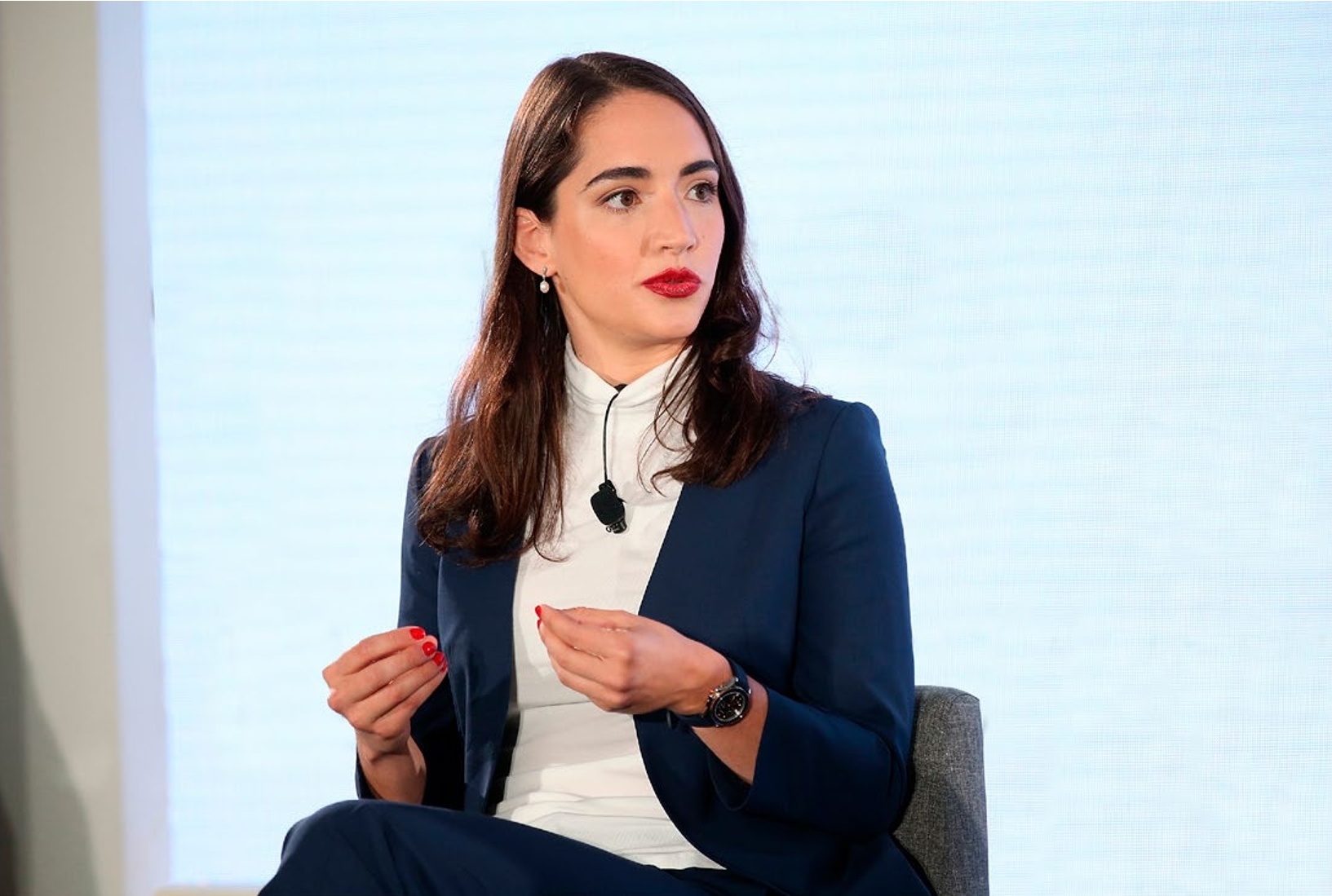
Alfred CEO and cofounder Marcela Sapone now faces one of her largest investors, Adam Neumann, competing with her real estate technology startup.
“It’s optically not good.”
—SEAN FOOTE, VC INVESTOR AND LECTURER AT UC BERKELEY’S HAAS SCHOOL OF BUSINESS
As Neumann and his allies shared their operations insights from building the co-working giant, the Alfred team helped Neumann and condo operator Greystar in an experiment to jazz up a trio of apartment blocks owned by Neumann, and co-investors, in Norwalk, Connecticut.
Goldin and Neumann’s co-owner Invictus Real Estate Partners diminished Alfred’s role in this project, claiming Greystar managed the three Norwalk apartment buildings, with Alfred facilitating minor concierge services, like home cleaning and dog walking. Invictus spoke to Forbes at the request of Goldin.
But current and past Alfred staff disputed this characterization. As did Greystar CEO Bob Faith, who told Forbes that the lines between his company and Alfred were blurred as part of the experiment and that they co-managed the properties together. Greystar and Faith are Alfred shareholders and previously announced a strategic partnership with it in 2019.
“We erased the lines between Alfred, the property management, and in essence, ownership, because [Adam] said, ‘Let’s break the box and build it back, and see what we can learn,’” Faith said.
The real estate investment itself proved lucrative for Neumann’s family office, 166 2nd Financial Services. According to property filings, Neumann and his co-investors sold the three Norwalk, Connecticut, properties for $293 million—$67 million more than they paid for them, just 16 months after acquiring them in January 2021. Goldin disputed that Neumann profited from any such transaction.
But the experiment revealed to everyone involved that the services side of Alfred’s business alone wasn’t lucrative. Instead, it became apparent that the real money was in Greystar’s side, using software to manage properties, such as approving a resident’s maintenance request or a building refurbishment. To do that directly, Alfred—or a rival—would need to work directly with landlords and become an end-to-end property management solution, not just a bolt-on technology.
W ith the lessons from the Connecticut project in mind, Alfred began to seek new investors in December 2021, in part to bankroll the purchase of a Charlotte, North Carolina-based property manager called RKW Residential. Already managing 30,000 homes in the southeastern U.S., RKW could kickstart Alfred’s shift into a more promising line of business. But at a price tag of $35 million, Alfred would need to raise new funding to pull it off.
It had a problem: When Neumann originally invested in Alfred back in 2020, Alfred’s founders agreed to unusually favorable conditions for the WeWork cofounder. Warrants inserted into the deal provided that, should Alfred reach certain performance milestones, Neumann would have the option to receive more shares at a discount, enough for a 51% stake, according to two sources. Now, though, those provisions made Alfred an unpalatable investment for new backers, three sources said.
When Alfred went to raise money again, the company asked Neumann’s office to relinquish them, a situation that complicated the fundraising process, according to the sources.
But ultimately, Neumann and 166 2nd gave up the warrants, and Alfred raised $125 million from Rialto Capital, existing investors and others, and acquired RKW in a deal announced in March. Now Alfred was not just a startup providing technology for renters and landlords. It was a property manager, too. In the aftermath of the acquisition, the company went through at least one round of layoffs. Alfred declined to comment on the layoffs.
Then in May, Neumann’s representatives Mauch and Stern resigned from Alfred’s board due to concerns about conflicts of interest.
While Neumann’s team was stepping back from Alfred, his associates began registering various business entities to operate in Florida, many of which use the terms “Flow,” Neumann’s company name, or “FOL”—ostensibly an abbreviation for “future of living.”
In a series of filings registered in Florida on the same day in July 2022, a number of corporate entities with “Flow” or “FOL” in their name listed Marie Stella Templo, the former general counsel for WeWork, as a point of contact. They provided the same address in Bay Harbor Islands, just north of Miami Beach.
“We erased the lines between Alfred, the property management, and in essence, ownership.”
—BOB FAITH, CEO, GREYSTAR
One of these companies is called Flow Carson, a name that appears related to Carson Living, the Alfred competitor that Neumann acquired in 2021. Carson investor Jerry Kestenbaum confirmed the acquisition but did not respond to questions about exactly when it occurred; however, his LinkedIn page lists the end date for his role as “Investor/Board member” of Carson as July 2021. Flow Carson’s filing to operate in Florida lists a corresponding Delaware entity registered in August 2021.
Another of these companies is called FOL Management LLC. Before it was registered to do business in Florida in July 2022, it was first registered in Delaware in September 2021—months before Neumann gave up his rights to obtain ownership of Alfred as part of the $125 million funding round.
Job listings for FOL Management that have since been taken down described FOL Management as “keen to reinvent the residential real estate ecosystem” and “redefine the economic experience of renters” by “leveraging new technology”—a goal the listings called “an ambitious vision for the future of living.”
In the blog post announcing Flow, Marc Andreessen described Flow and Neumann’s efforts in similar terms, calling it a “direct strike” on current residential real estate challenges that would “rethink the entire value chain” for renters.
Goldin declined to explain how Flow and the various FOL companies all fit together. Flow does not appear connected with Flowcarbon, another recent Neumann project, which promises to reinvent carbon credit trading with a cryptocurrency called Goddess Nature Tokens.
Over at Alfred, Benzino—its president, and Neumann’s former lieutenant—recently signed a separation agreement and has quietly left the company, two sources say. (Benzino did not respond to a comment request.) But as of publication, Neumann remained a major investor in the business, and that may not change anytime soon. Since his family office team stepped off the board, he would no longer hold a fiduciary responsibility to Alfred, said Eric Koester, an adjunct professor of business at Georgetown University. Goldin declined to comment on Neumann’s plans for his equity stake.
Alfred may have already started seeing the effects of Neumann’s influence. One of the Norwalk, Connecticut, apartments where Alfred participated in the experiment with Greystar had been featured on Alfred’s site as an example of how it works with landlords. But when a Forbes reporter stopped by to speak to residents, one told them that the app the building offered for use was Carson, the Neumann-owned competitor. The Norwalk apartments have since disappeared from Alfred’s site.
Additional reporting by David Jeans and Alex Levine.
PHILLIP FARAONE/GETTY IMAGES




• INNOVATION •
Into the Light
Hospitals have long used ultraviolet light to zap viruses, but the devices were too expensive for businesses and schools. Spurred by the pandemic, an unlikely trio started R-ZERO to develop a lower-cost alternative.
By Amy Feldman
Photograph by Ethan Pines for Forbes
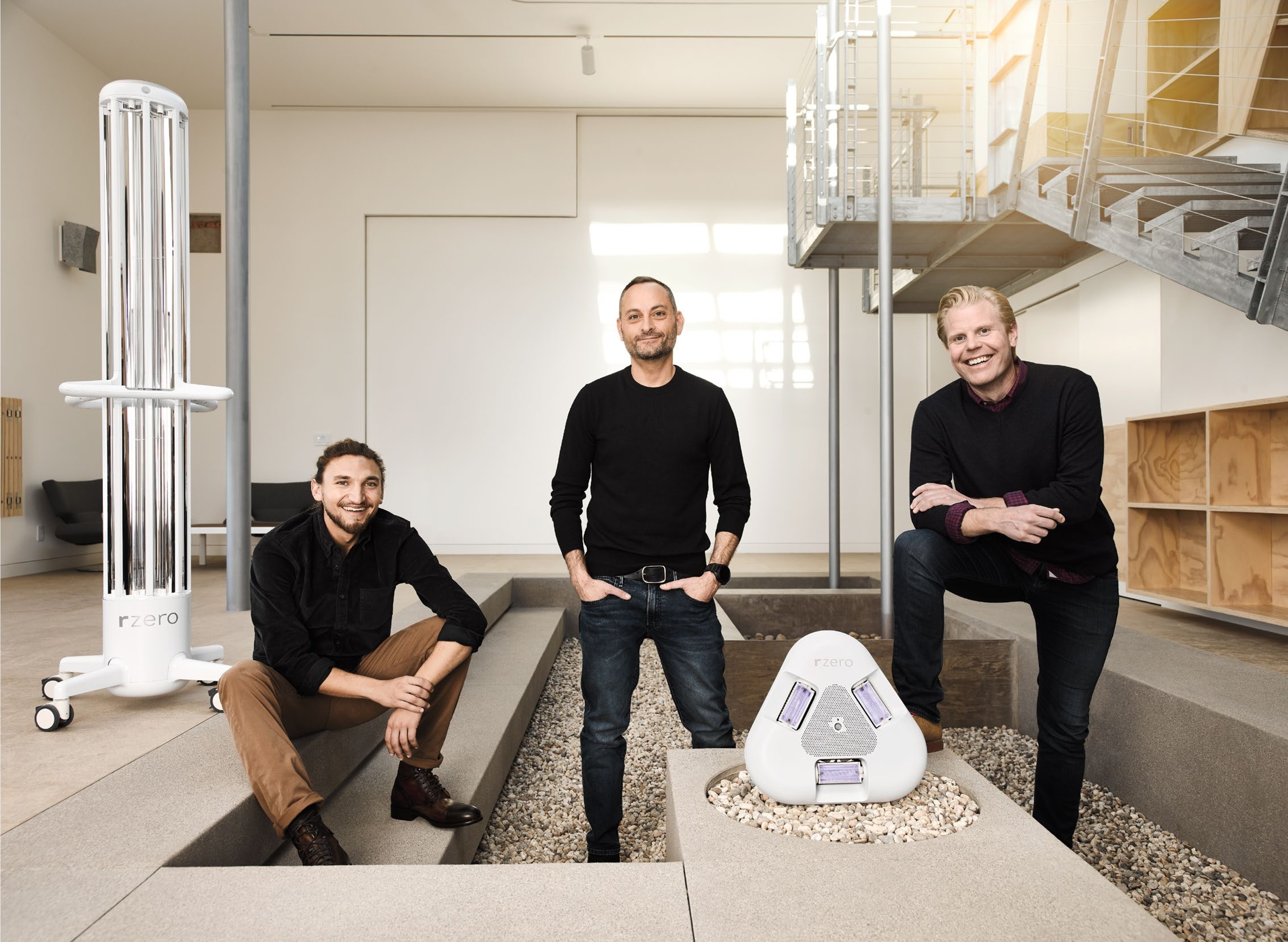
R-Zero founders (from left) Grant Morgan, Ben Boyer and Eli Harris with their UV-based disinfection devices.
G rant Morgan was baffled. It was March 2020, Covid-19 was raging across the nation and one of the simplest ways to kill a virus—blasting it with ultraviolet light—was not being used in schools and nursing homes because hospital grade disinfection devices cost over $100,000. But the co-founder and CEO of R-Zero couldn’t understand why: “That’s a lightbulb on wheels with a timer. There’s no way it costs $100,000 to make,” says Morgan, who’d previously worked at Abbott and mobile phone repair startup iCracked. “It’s an artifact of our screwed-up healthcare system.”
By April he and his cofounders—venture capitalist Ben Boyer and Eli Harris, who’d worked at drone company DJI and cofounded battery startup Eco-Flow—were struggling to build their own lower-cost disinfecting ultraviolet lights. Within months, R-Zero had lined up its first customers, leasing them a mobile device for $17/month that could zap a room clean within minutes. Today, the Salt Lake City-based startup sells ultraviolet-based hardware that disinfects, software and sensors that gauge how crowded a room is and a dashboard that provides analytics on how the devices are used.
Last year, revenue reached $13 million; it’s expected to triple this year. With $170 million in equity funding from investors that include Silicon Valley’s DBL Partners and the Mayo Clinic, R-Zero is now valued at $505 million. That fast growth helped it gain a spot on this year’s Forbes Next Billion-Dollar Startups list, one of 25 companies we think most likely to reach a $1 billion valuation.
With concern over the pandemic fading, Morgan now sees a far bigger opportunity beyond Covid. The same ultraviolet light disinfection technology that inactivates the coronavirus can also help lower the risk of transmission of other diseases, including influenza and norovirus—even monkeypox. Ultraviolet devices, which rely on a short wavelength of light known as UVC, work without toxic chemicals or massive energy use. Since they disinfect indoor environments and not the human body, they are not considered medical devices—meaning the company doesn’t need to spend time and money dealing with the U.S. Food & Drug Administration.
“I think we can come out of Covid and build a safer, healthier, new normal,” says Morgan. “I think this is going to be baked into every physical space. It will be as ubiquitous as general lighting.”
Morgan, 33, grew up in Folsom, California, the city made famous by Johnny Cash’s “Folsom Prison Blues.” His father was an accountant; his mother ran a small business that sold printing forms and then became a school administrator. In high school, Morgan played drums in a jazz band (“We went to Europe and opened for Carlos Santana”), but opted to study mechanical engineering at California Polytechnic State University.
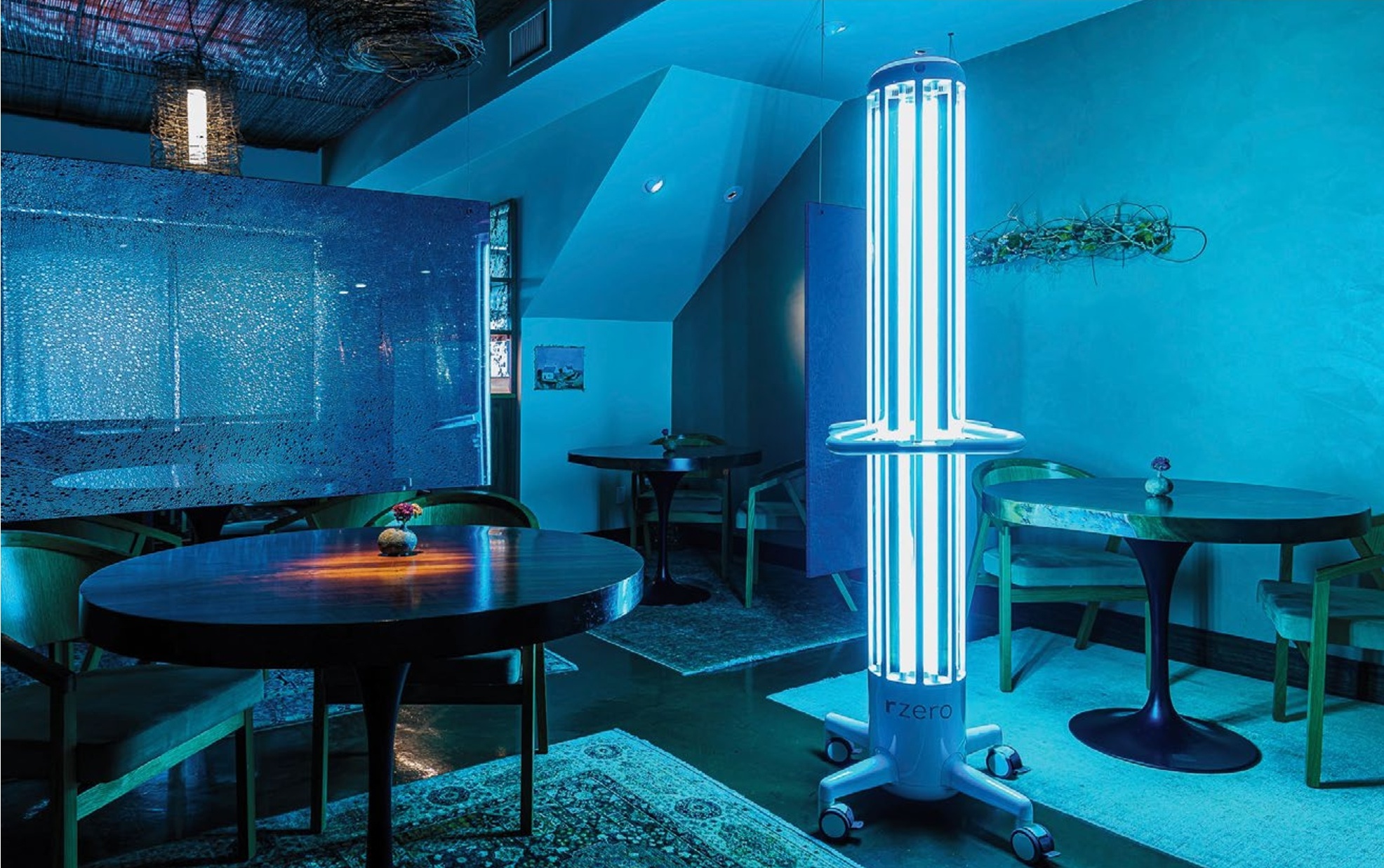
Arc, the UV-based disinfection device from R-Zero.
After a stint at Abbott and at a small medical device maker, he landed at iCracked in 2015 when his buddy AJ Forsythe, who’d started the company in his Cal Poly dorm, called. “You look at people starting companies and you think there’s a formula. The dirty secret is no one knows what they are doing,” he says. “That was a really empowering thing for me early on in my career.” It also reinforced his preference for startups over big companies. When Allstate acquired iCracked in February 2019, he stayed just six months before going to another startup. “I don’t have an off switch,” Morgan says. “It’s a blessing and a curse. I am, maybe, maladjusted. The status quo makes me uncomfortable.”
It was venture capitalist, Boyer, 46, cofounder of Tenaya Capital, who had the original germ of an idea to use ultraviolet light to fight Covid. Boyer would bring the connections and strategy, Morgan the leadership. Their thirdcofounder, Harris, had experience making hardware and knew how to sell.
Harris, who is 29 and a Forbes Under 30 alumni, had an unconventional upbringing on a shared property in Santa Barbara. His parents had spent many years overseas—his mother on ashrams in India, his father in Kenya—and he studied Mandarin in college at Amherst. For a decade, he lived in China, working at drone company DJI in Shenzhen and then cofounding battery startup EcoFlow in 2016. He and Morgan had connected over a potential partnership for iCracked technicians to repair DJI drones that never panned out.
For scientific credibility, they connected with Richard Wade, a toxicology expert (and father of an iCracked employee) who came on as the company’s chief scientist. At 76, Wade, who has a Ph.D. in environmental health sciences from the University of Michigan, had worked in public health for decades, and, among other roles, had been the VP of environmental health at cruise lines Princess and Norwegian. He had, notably, written the protocol for decontamination of the Diamond Princess ship after its Covid-19 outbreak. “My bias was UV because it demonstrated efficacy,” Wade says.
After briefly considering on-demand disinfection, they quickly shifted their idea to building—and selling—the ultraviolet devices themselves at a price that would work for restaurants, hotels and schools. “I called Ben back and said, ‘You’re going to think I’m crazy, but we’re building lights.’ He’s like, ‘You are crazy, but I’m in,’” Morgan says.
It wasn’t easy. The supply chain crunch meant that ultraviolet lightbulbs were tough to get. Morgan, who knew that manufacturers typically produce a few extra for every big order they get, went to LightSources, one of the biggest ultraviolet bulb makers, and asked to buy anything they could spare. “We got the overrun bulbs, just five bulbs,” he says. Then they scoured the internet for more, eventually getting enough bulbs to work out a design.
“YOU LOOK AT PEOPLE STARTING COMPANIES AND YOU THINK THERE’S A FORMULA. THE DIRTY SECRET IS NO ONE KNOWS WHAT THEY ARE DOING.”
By July, they’d built a prototype named Hope (as in “hope this works”) that was two meters tall, held together with duct tape and wire. They dragged it to Atelier Crenn, a Michelin-starred French restaurant in San Francisco and gained a first beta customer. Then they loaded it into a minivan, driving around California—to a luxury dude ranch, to schools, to anyone who might be a customer—to show it off. Helped by its relatively low price and the panic of many business owners over how to reopen safely, they started lining up customers.
“The traditional chemical disinfection industry is highly inefficient,” says Ira Ehrenpreis, managing partner at DBL Partners, an early investor in Tesla who led R-Zero’s $15 million funding round in August of 2020. “It’s ineffective, it’s unsustainable, it’s dangerous and it’s labor intensive.”
With the new funds, R-Zero placed a large order for ultraviolet lightbulbs, and focused on improving their design. They wanted a product that would not only disinfect safely, but also wouldn’t look out of place in a restaurant or school. They hired Bould Design, a San Mateo, California-based shop that had designed Nest’s thermostats and Roku’s streaming players, to come up with a streamlined look. “It had to look safe,” says William Dougherty, chief information security officer at digital healthcare firm Omada Health, which signed a deal with R-Zero when he reconfigured the company’s space last year.
Today, in addition to Omada Health, customers include large school districts, like those in Clark County, Nevada, Fort Bend, Texas, and South San Francisco; sports teams like the San Francisco 49ers and Detroit Red Wings; senior care facilities including Trilogy Health Services, which operates 132 locations across the Midwest; and companies like electric vehicle startup Rivian and household products manufacturer Simple Green.
R-Zero switched from a pricing model of leasing its devices at ultra-low cost to a more sustainable model of selling them and charging a subscription of between $50 and $250 a month to cover things like software and replacement bulbs. The company now offers three devices. Its original, mobile Arc device is the most expensive at $28,000 and can only be used to disinfect an empty room due to the harmful impact of the wavelength of its UVC light (254 nanometers) on people. R-Zero’s two newer devices are cheaper and designed to operate continuously in the background. Both came to market in November of 2021.
Beam ($5,000) is an LED-based, upper room disinfection device that uses 265-nanometer ultraviolet light to create a disinfection zone located above people in a room. Vive ($3,000), meanwhile, uses a wavelength known as far-UVC at 222-nanometers to inactivate harmful microorganisms in the air and on surfaces, even while people are present. While the Beam works in large open spaces, like classrooms and office lobbies, the Vive can be installed in smaller spaces, such as conference rooms and bathrooms.
“What we have come to realize is that there is not one-size, fits-all for infection protection,” Boyer says. “What Arc competes with is some form of chemical intervention. For Beam and Vive, it’s HVAC upgrades.”
In July 2021, R-Zero acquired a tiny outfit called Co-WorkR that uses sensors to gauge how many people are in a room. That information, in turn, allows it to determine a room’s risk—a packed room is less safe—and to automatically turn the disinfection devices on or off. The data also allows R-Zero to give its customers advice on whether meeting rooms are over capacity and how to space meetings out to lower infection risk.
Before the pandemic, people accepted as normal that illnesses like influenza and the common cold spread through offices and schools, Morgan says. Yet the technology that could reduce the risk of Covid-19 could also cut the transmission of these longstanding illnesses, a boon to both health and productivity. “The vision long term is to sell a reduction in sick days,” Morgan says. “We’re capitalists, but I want my gravestone to say, ‘Grant helped eradicate the flu.’”
R-ZERO
FEATURES
ART OF THE TURNAROUND
Japanese education tycoon Soichiro Fukutake used his fortune to transform the industrially ravaged Seto Islands into a global art destination—giving a boost to the region’s economy along the way.
BY JAMES SIMMS
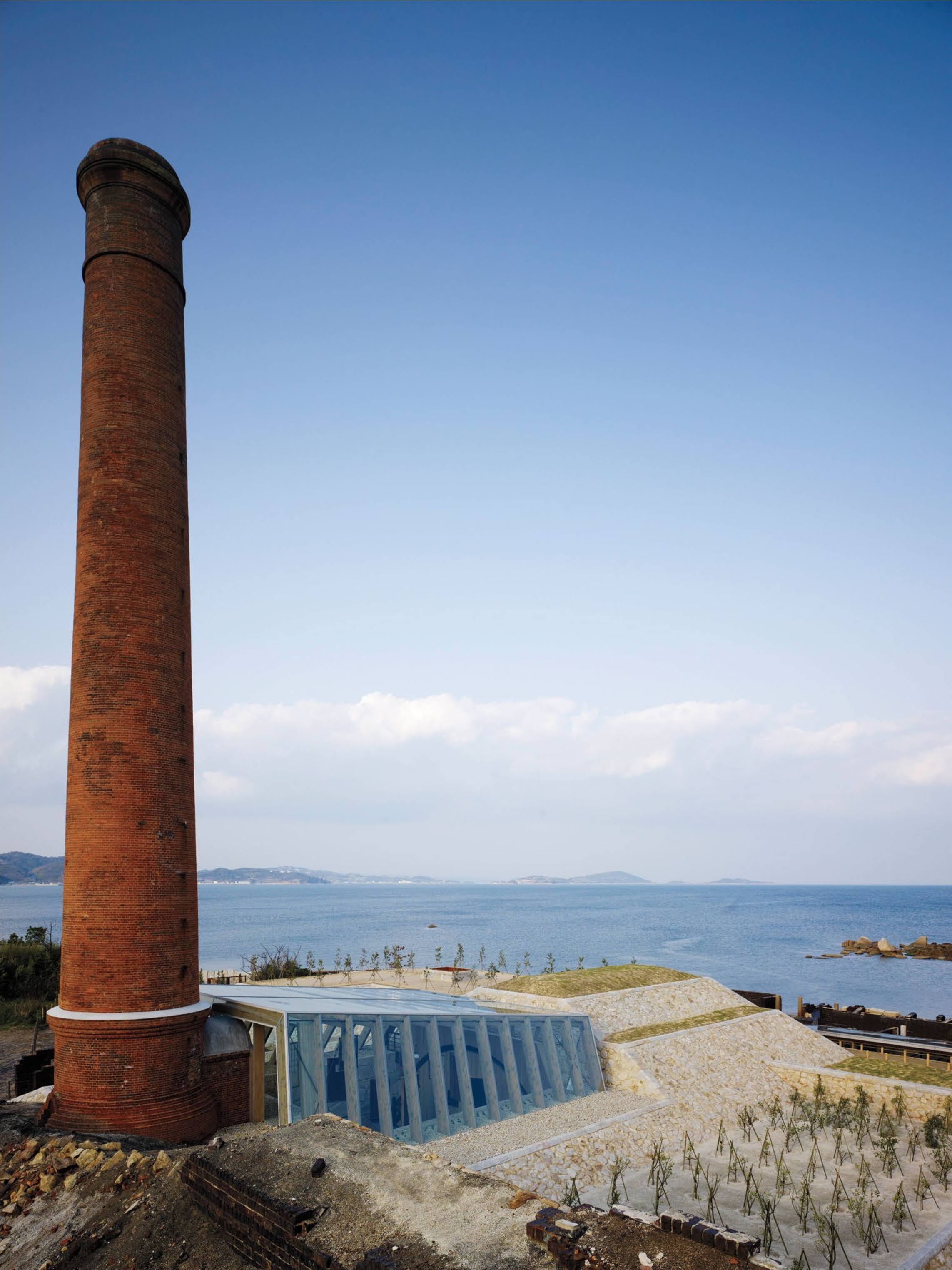
Opened in 2008, the Inujima Seirensho Art Museum is built on the ruins of a century-old copper refinery.
O nce buried under nearly a million tons of illegally dumped toxic waste from scrapped cars, Japan’s Teshima Island exemplified the excesses of the country’s meteoric, but unbridled, industrial growth. Yet today, tens of thousands of people flock to it every year for world-class art, architecture and dramatic vistas, created through the vision—and investments—of Soichiro Fukutake. Over the past three decades, the former chairman of Tokyo-based education firm Benesse Holdings and his family spent $250 million of their fortune to transform Teshima and roughly a dozen neighboring islands in the Seto Inland Sea into a global art destination. In doing so, they have revitalized a region that served as an economic and cultural crossroads for a millennium.
Visitor numbers, which have grown steadily since the first of the area’s some three dozen museums and galleries were built in 1992, typically surge during the Setouchi Triennale, an international contemporary arts festival held every three years. Nearly 1.2 million came during the 2019 Triennale, with overseas visitors, primarily from Taiwan, Hong Kong and mainland China, adding an estimated ¥18 billion ($132 million) to the economy of Kagawa Prefecture, where most of the islands are located, according to a 2020 report from festival organizers and the Bank of Japan.

Chichu Art Museum on Naoshima Island.
So far there have been far fewer visitors at this year’s event, which runs until November. Numbers are down by 40%, largely due to pandemic border restrictions that make it difficult for overseas tourists to visit Japan, though Fukutake is optimistic that inbound tourism will pick up once lifted.
“I’m not in it for the economics,” stresses the 76-year-old, who had an estimated net worth of $1.1 billion on this year’s Forbes World’s Billionaries list. He inherited the family’s Tokyo-based publishing company, which started in Okayama Prefecture, after the sudden death of his father, Tetsuhiko, in 1986. His dad had a dream to build an international children’s campground on Naoshima Island, one of the many smaller islands including Teshima that lie off the Kagawa and Okayama coasts.
It was during visits to oversee the project there that Fukutake “saw the damage inflicted from the excesses of modernization and urbanization on Naoshima and Inujima [Island], both left barren from copper smelting, and Teshima,” he says in May on a video call from New Zealand where he has lived since 2009. “I became enraged and decided to use art to fight against what society had done.”
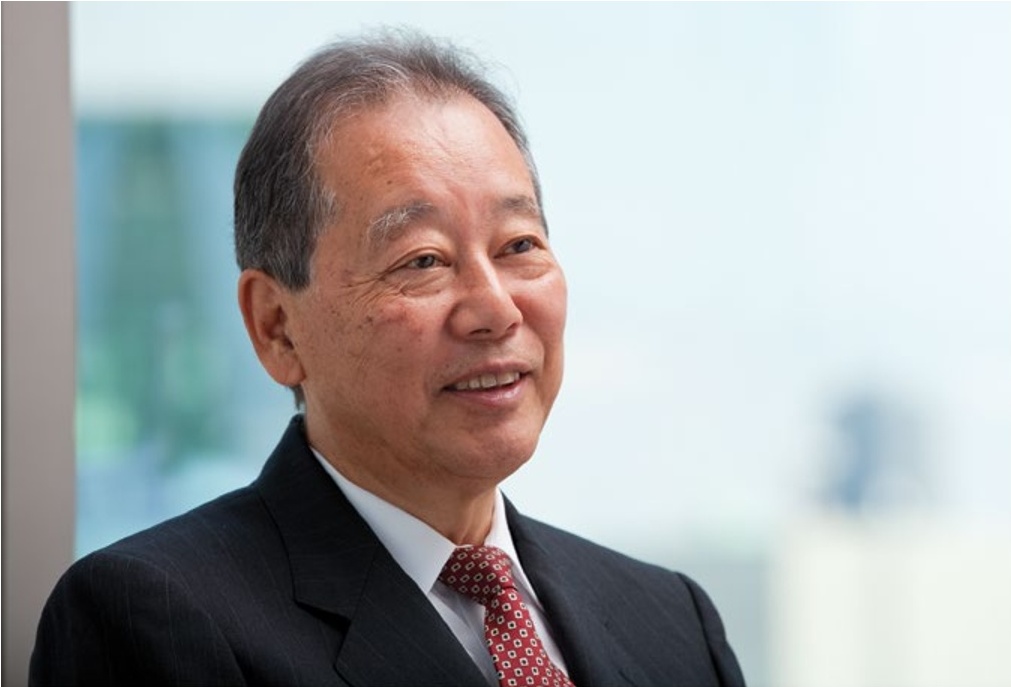
Soichiro Fukutake, former chairman of Benesse Holdings.
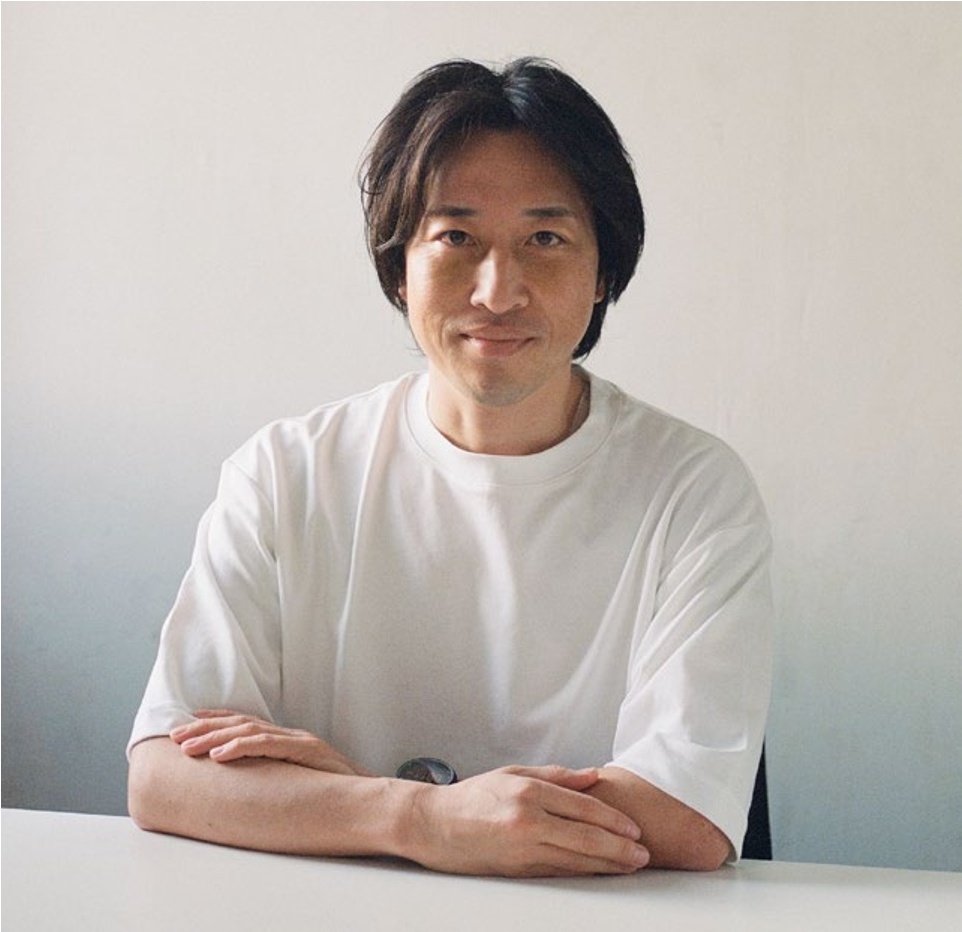
Hideaki Fukutake, No. 2 at Fukutake Foundation and a Benesse board director.
He brought more land in addition to the campground on Naoshima and enlisted the help of Pritzker Prize-winning architect Tadao Ando—known for his smooth concrete, sharp angles and natural lighting—to design the Benesse House Museum and hotel. It was the first of dozens of art sites that today sprinkle the islands and feature works by the likes of Andy Warhol, Lee Ufan and David Hockney. To support the sites and exhibitions, Fukutake started his eponymous foundation in 2004, with the family gifting shares that eventually totaled 8% in Benesse. Now worth $136 million, they provide about $3 million in annual dividends. This is in addition to the family’s own investments that Fukutake estimates at $250 million. The company chips in too, building, then donating, museums to the nonprofit.
His 45-year-old son, Hideaki, Fukutake Foundation’s No. 2 and a Benesse board director, says in a separate interview that while the Triennale festivals have some public funding, the organization doesn’t accept outside financial help to avoid compromising its vision.

“We want to be on the edge and have a viewpoint, but not to the extent that we end up being very exclusionary,” says Hideaki, who joined the foundation in 2012 and Benesse in 2013. “But we don’t want to appeal so much to popular tastes that we lose our uniqueness. That balance is important, and to accomplish that we need to have independent financial resources,” adds Hideaki, who Fukutake says will take over the foundation in the “not too distant future.”
Fukutake’s lodestar is the emotional resonance of the art—something his foundation and Okayama University currently are working to measure scientifically, he says. Still, the economic impact is clear for at least one island community. While other municipalities are losing people, his efforts in part have helped stabilize Naoshima’s population, according to a Kagawa prefecture official. Fukutake shares a national concern over shrinking rural numbers as younger people move to cities, with well-funded government rejuvenation projects across the archipelago having little to no impact. “Those left behind are losing hope and dreams for the future,” he says. “We’ve shown the power of art to revitalize rural areas.”
Teshima may be the best example of a turnaround in local mindset and physical reality. Because of the environmental and reputational destruction, residents there “lost most of their pride in the island and self-confidence,” says Fukutake. Their decades-long struggle to clean up the nation’s largest case of illegal dumping of toxic waste is now reaching a finale. At a mainly taxpayer-funded cost of ¥82 billion, the government expects to finish remediating contaminated groundwater this year, dovetailing with Fukutake’s own philanthropic efforts. Today the island is home to one of the foundation’s crown jewels, the Teshima Art Museum—a white, droplet-shaped concrete structure and art installation designed by Pritzker winner Ryue Nishizawa and artist Rei Naito. Among Fukutake’s chief hopes are that the foundation’s museums “serve as a catalyst” for rejuvenation elsewhere (see sidebar).

Claude Monet’s impressionist masterpieces “Water Lilies” (above) in Chichu Art Museum.
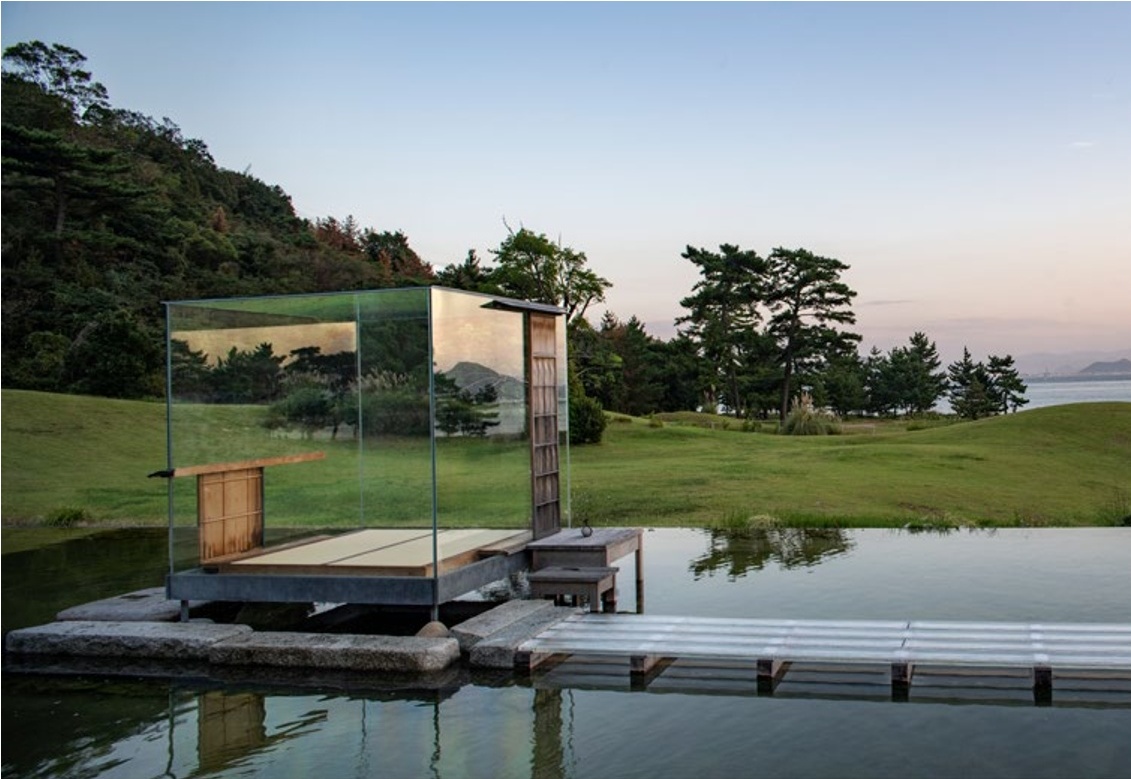
Hiroshi Sugimoto’s Glass Tea House “Mondrian” outside Benesse House Park.
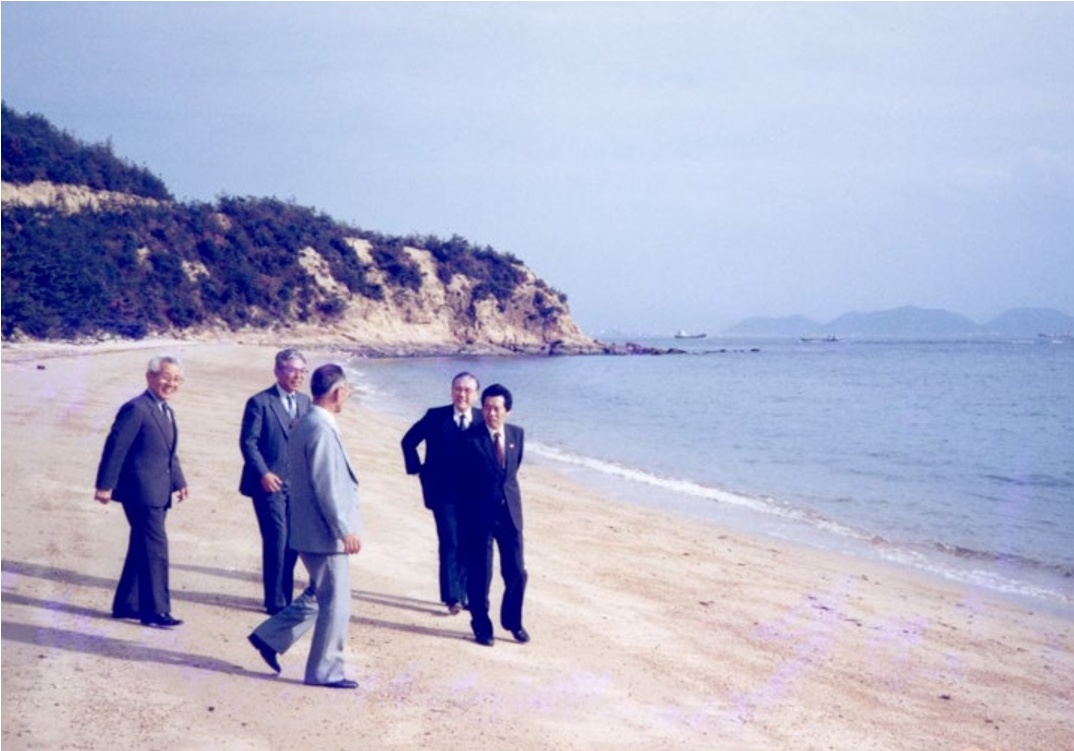
Soichiro Fukutake (far right) during a visit to Naoshima in 1987 with the island’s then-mayor, Chikatsugu Miyake (far left).
While he started on the first art sites in the early 1990s, it was a 2003 visit to an arts festival in northern Japan that planted the seed for the Triennale. Over the next seven years, Fukutake and his foundation worked with local and national governments to hammer out festival plans and hold town halls to gain support. In 2010, the first Triennale opened, the same year as the Teshima museum.
Fukutake says his family’s projects for the 2025 Triennale include building a three-story (two underground) museum on Naoshima that’s focused on Asian artists and converting a former junior high school on Teshima—with a design by a yet-to-be-named Japanese architect—into a gallery. Hideaki adds a key issue is ensuring the foundation’s sustainability through funding, staff development and holding fast to its independence.

Yayoi Kusama’s “Narcissus Garden” installation at the Tadao Ando-designed Valley Gallery on Naoshima (above).
“WE’VE SHOWN THE POWER OF ART TO REVITALIZE RURAL AREAS.”

Teshima Art Museum—a white, droplet-shaped concrete structure and art installation designed by Pritzker winner Ryue Nishizawa and artist Rei Naito.
When the family talks about the long term, they think in decades. “Ultimately, we do have a [return on investment] target, but it’s not measured by a quarter, a year or three years. It’s on a generational basis,” Hideaki says. (The family moved to New Zealand to escape the 50% Japanese inheritance tax that would make it “impossible” to continue family support of the foundation.) “If my son can recover the investment, that’s okay.”
Hideaki faces his own dilemma: Avoiding the temptation, once he takes the organization’s reins, to put his imprimatur on it. “My personality is to want to change things, so it’s a bit of an internal, personal battle. So it will be important to slightly change things to evolve,” he says.
BROAD STROKES
1955: Tetsuhiko Fukutake founded educational publisher Fukutake Publishing in Okayama City.
1989: Naoshima International Camping Ground opened on Naoshima Island.
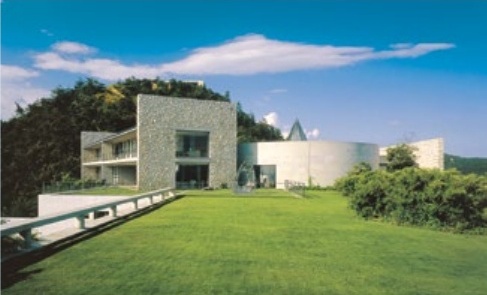
1992: Pritzker Prize winning architect Tadao Ando’s Benesse House Museum and hotel (above) opened on Naoshima.
1993: Fukutake Publishing acquired global language learning firm Berlitz International.

1994: “Open Air ’94 Out of Bounds,” an outdoor exhibition, opened, debuting Yayoi Kusama’s now iconic “Pumpkin” sculpture (above).
1995: Fukutake Publishing changed its name to Benesse, combining Latin words bene (well) and esse (being). In the same year, it listed on stock exchanges in Osaka and Hiroshima.
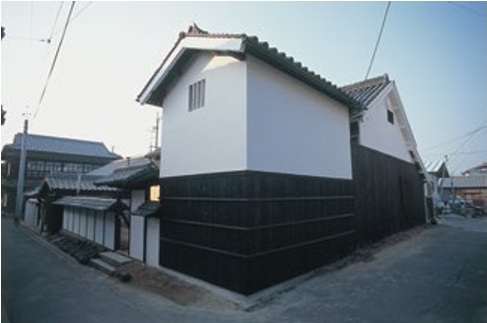
1998: “Kadoya” (above) opened on Naoshima as part of the “Art House Project”—a repurposing of old homes into galleries for permanent and rotating exhibits.
2000: Benesse listed on the Tokyo stock exchange.
2001: Forerunner of the Setouchi Triennale, “The Standard” exhibition kicked off with 13 artists on Naoshima.
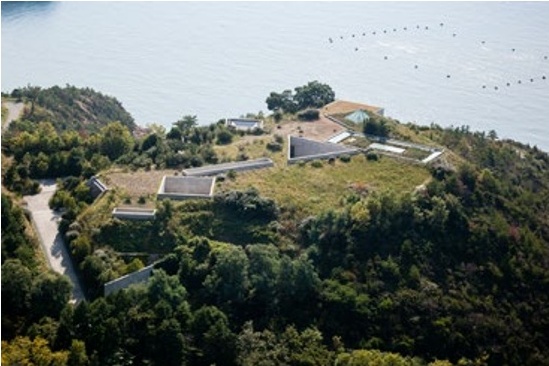
2004: Chichu Art Museum (above) opened on Naoshima, featuring works by Claude Monet and James Turrell.
2008: Inujima Seirensho Art Museum unveiled on the former site of a copper refinery, Inujima Island.

2010: First Setouchi International Art Festival opened across seven islands and Takamatsu City. Teshima Art Museum (above) unveiled.
2012: Soichiro Fukutake and his family gifted 5.2% of Benesse stock to launch their namesake foundation (gradually raised to 8% in 2020).
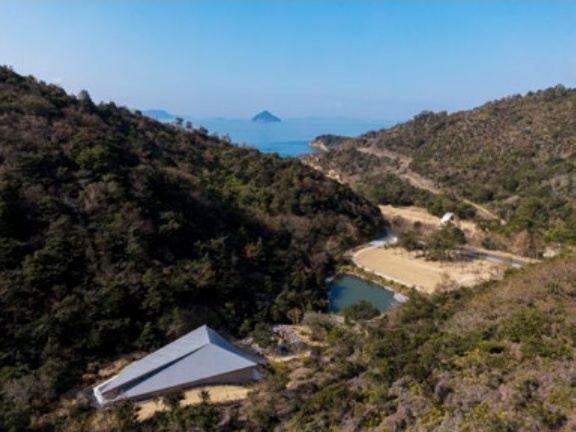
2022: Fifth Setouchi Triennale. On Naoshima, Sugiura Gallery opened and Ando-designed Valley Gallery (above) unveiled.
HOME TRUTH
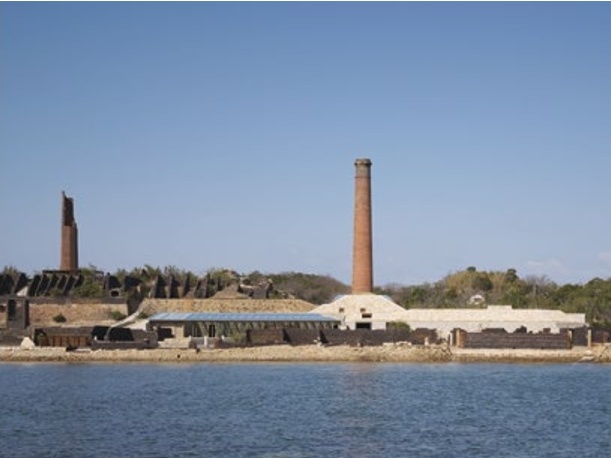
A 30-minute ferry ride from Teshima Island lies the Inujima Seirensho Art Museum, a site that that crystalizes Soichiro Fukutake’s overarching philosophy of rejuvenation. Opened in 2008, the partially subterranean building, with floors of black slag bricks made from copper smelting byproducts, is an immersive philippic against Japan’s singular focus on economic growth after WWII. It also offers a path forward with an environmentally friendly natural heating and cooling system and use of recycled water.
Once home to a copper refinery, Inujima Island narrowly escaped Teshima’s ruinous fate. Plans were afoot to turn an old quarry pit into a medical waste dump, until the former Benesse chairman purchased it in 2001 after Yale-trained Japanese artist Yukinori Yanagi, alarmed at the dump proposal, brought him a plan to repurpose the industrial ruin.
The museum uses parts of the former house—including windows, doors and tatami mats from Fukutake’s own collection—of Nobel-nominated writer Yukio Mishima, who railed against modern Japan’s social ills and committed ritual suicide after failing to incite a military-led coup to restore the emperor in 1970. (Fukutake notes he doesn’t admire Mishima’s political ideology.)
“Collaged into these ruins was the house of a novelist who protested against a Japan that had lost its self-respect during its rapid post-war economic growth, made economic development its supreme value, and ignored its culture and natural environment,” wrote Yanagi in his 2010 book Inuijma Note.
DAICI ANO; MITSUO MATSUOKA; COURTESY OF FUKUTAKE FOUNDATION; BENESSE HOUSE: TADASU YAMAMOTO, “PUMPKIN”: SHIGEO ANZAI, KADOYA PROJECT: NORIHIRO UENO, CHICHU ART MUSEUM: SEIICHI OHSAWA, TESHIMA ART MUSEUM: KEN’ICHI SUZUKI, VALLEY GALLERY: MASATOMO MORIYAMA; CLAUDE MONET SPACE: NAOYA HATAKEYAMA, “TIME CORRIDORS”: SUGIMOTO STUDIO, INUJIMA SEIRENSHO ART MUSEUM: DAICI ANO. HISTORICAL PHOTO: COURTESY OF BENESSE HOLDINGS; “NARCISSUS GARDEN”: MASATOMO MORIYAMA, TESHIMA ART MUSEUM: NOBORU MORIKAWA
• FORBES LIFE •
Daily Life
A new Forbes survey of the world’s richest people found many still do household chores like taking out the garbage and grocery shopping.
By Jemima McEvoy

T he world of the super wealthy may be brimming with private jets, mega mansions and more dough than most could even dream of, but the day-to-day lives of billionaires look a whole lot more typical than many would expect.
That’s at least according to the results of a recent survey by Forbes. The poll of 65 of the richest people on Earth found that, while they could easily outsource, many billionaires still choose to do at least some household chores and other domestic tasks themselves. More than a third said they regularly grocery shop and take out the garbage, while 40% cook and walk their dogs. More than half of the respondents said they watch their children or grandchildren’s sports games. (Perhaps it’s the competitive instinct.)
Still, these ultra-rich have their limits, the survey suggests. Clearly greenbacks do not correlate with green thumbs as just 10% or those polled reported doing yardwork on a regular basis. The only task less popular was laundry, which just 8% of the billionaires said they tend to do.
There are a myriad reasons why at least some members of the superrich still do these ordinary tasks. Amazon founder Jeff Bezos and Microsoft cofounder Bill Gates—the world’s No. 2 and No. 4 richest people worth an estimated $146.8 billion and $105 billion, respectively—have both previously discussed their habits of washing the dishes every night. “Other people volunteer, but I like the way I do it,” Gates reasoned simply in a 2014 Reddit Q&A.
For some, like real estate investor Charles Cohen, whose estimated $3.6 billion empire includes high-end office buildings in New York City and the movie theater chain Landmark Theatres, doing chores is a way to relax outside of work. “It’s funny you bring this up because I’m just driving back from Home Depot right now with some extra sprinklers and light bulbs,” Cohen said in a recent phone call. “I like going out and doing stuff on my own.”
The real estate mogul described tasks like grocery shopping and grilling as a “great way to break up the week.” Cohen said he grew up in the Westchester suburbs of New York with a housekeeper, and that he and his wife try to do more of the work around the house in part to set an example for their children. “It’s all about doing the things you enjoy doing and creating a lifestyle that defines the way you are and the way you want your children to perceive you, and the values you want them to embrace,” Cohen said. (Not that he and his family live a frugal life. They own a 16ha Connecticut estate with a private screening room and a vineyard in France.)
“IF SUCCESS CHANGES YOU, THEN I THINK YOU’VE MISSED THE WHOLE POINT OF LIFE.”
—Frank VanderSloot
Frank VanderSloot, the founder and executive chairman of the health and wellness business Melaleuca, and the richest person in Idaho, said doing household chores feels natural to him because of the way he grew up. The son of a railroad worker, VanderSloot recalls waking up before school to chop wood and milk the cows on his family’s farm in northern Idaho.
“People think that you’re a different person because of the size of your checking account, but it doesn’t work that way, at least I don’t think it does,” said VanderSloot. He noted that he and his wife, Belinda, hired someone to help with cleaning around the house, which has 15 rooms to accommodate their 14 children and 54 grandchildren when they come to visit. But he and his wife handle most household chores, including cooking and laundry; they pay their grandchildren to do their yardwork.
“I think that wealth or success will test your character more than failure ever could, and you’ve got to measure up to that,” he emphasized. “If success changes you, then I think you’ve missed the whole point of life.”
Yet another billionaire, who asked for his comments to remain anonymous, told Forbes he does everything from taking out the trash to washing his clothes—“yes, even laundry and occasional ironing”—because he is “just not comfortable accepting personal services from others.”
Not everyone has quite the same philosophy. After all, as the survey indicates, the majority don’t do all these chores: 60% said they don’t cook; 62% said they don’t take out their garbage and 92% don’t do laundry. Some may have good reasons. Jeff Greene, the Palm Beach-based real estate mogul who first made his fortune shorting subprime mortgages during the Great Recession, insists that while he’s “pretty down to earth,” most household chores and tasks are handled by his staff. “I’m running a multibillion dollar business. I have a lot going on, so it’s obviously not the best use of my time to be doing stuff around the house that I could hire someone to do,” he said.
When he has time outside of work, Greene said he prioritizes spending time with his three young children, who he drives to and from school each day. “We’re very involved with our kids,” he said, adding: “It’s nice to do … Compared to fighting with some contractor about a deadline, I’d rather be stuck with my kids.”
WHICH OF THESE ACTIVITIES DO YOU DO REGULARLY?
Insights from our exclusive survey of 65 global billionaires. Just how normal is a day in the life of a billionaire? Well, more typical than you might expect, with more than a third doing routine tasks like cooking and grocery shopping. But folding clothes? Forget about it.
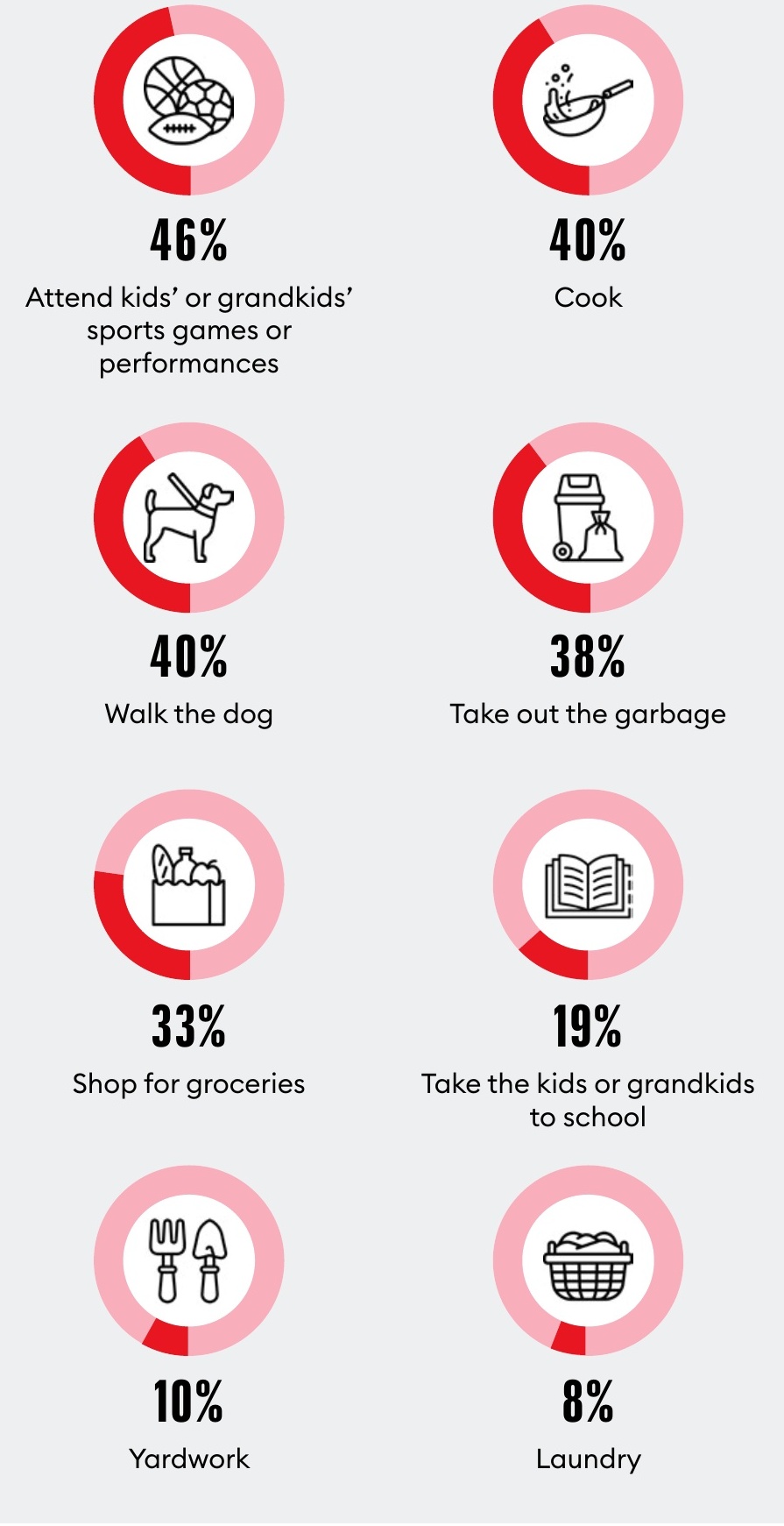
THE BURTONS/GETTY IMAGES
• THOUGHTS ON •
Property
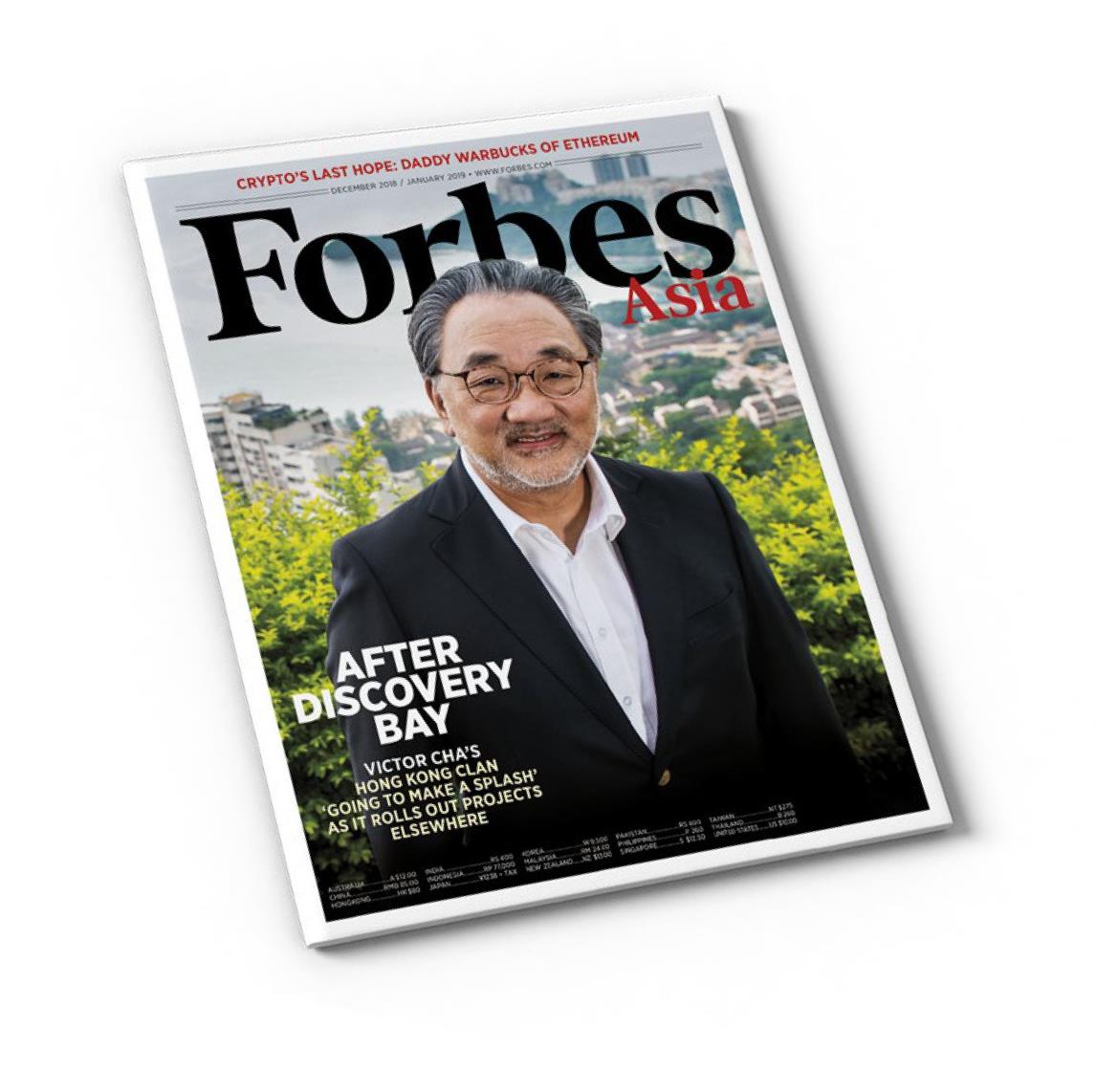
Island of Plenty
December 2018/January 2019
Back in December 2018, Victor Cha and his family’s Hong Kong property firm HKR International (HKRI) were profiled, highlighting their achievements in developing Hong Kong’s Lantau island. Their signature project was Discovery Bay, which the Cha family has been developing since the late 1970s. “For decades, Hong Kong’s largest privately planned community has been the cash cow and driver of the company,” we said at the time. Now that cow is set to get a bit fatter. Earlier this year, the company announced it will be spending $1.9 billion in reportedly the biggest investment into Lantau in over a decade. Done as a joint venture with China’s Citic Pacific, the funds will go to expand Discovery Bay over a period of about seven and a half years. The company has been taking other steps to rationalize its operations, such as disposing of properties in Japan and expanding in Shanghai. “In the face of strong headwinds, the concerted efforts of the company and its subsidiaries have proven to be the best tool to rise to challenges,” said Cha in his chairman’s statement in the most recent HKRI annual report.
“If the world went to hell in a handbasket as it seemed to be doing you could say goodbye to everyone and retreat to your land, hunkering down and living off it.”
—Jeannette Walls
“At one time in the world there were woods that no one owned.”
—Cormac Mccarthy
“Few things in my life have had a more genial effect on my mind than the possession of a piece of land.”
—Harriet Martineau
“It might turn out that without the right to possess, we are not really sure we have the right to speak and to be.”
—Arthur Miller
“A pickpocket is obviously a champion of private enterprise. But it would perhaps be an exaggeration to say that a pickpocket is a champion of private property.”
—G.K. Chesterton
“A human being needs only a small plot of ground on which to be happy and even less to lie beneath.”
—Johann Wolfgang von Goethe
“Land is the only thing in the world that amounts to anything.”
—Margaret Mitchell
“ We come and go, but the land is always here. And the people who love it and understand it are the people who own it—for a little while.”
—Willa Cather
“If any could desire what he is incapable of possessing, despair must be his eternal lot.”
—William Blake
“As a man is said to have a right to his property, he may be equally said to have a property in his rights.”
—James Madison
“An object in possession seldom retains the same charm it had in pursuit.”
—Pliny the Younger
“Do not move your neighbor’s boundary stone set up by your predecessors in the inheritance you receive in the land the lord your god is giving you to possess.”
—Deuteronomy 19:14
“Fifty percent of something is better than a hundred percent of nothing.”
—Chuck Barris
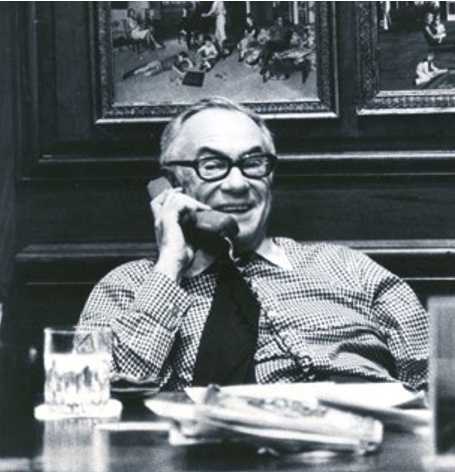
FINAL THOUGHT
“A home of one’s own is realizing the American dream. The fact that homeownership mostly turns out to be a good investment makes for added happiness.”
—Malcolm Forbes
SOURCES: CHILD OF GOD, BY CORMAC MCCARTHY; THE OUTLINE OF SANITY, BY G.K. CHESTERTON; THE SORROWS OF YOUNG WERTHER, BY JOHANN WOLFGANG VON GOETHE; SALESMAN IN BEIJING, BY ARTHUR MILLER; O PIONEERS!, BY WILLA CATHER; HALF BROKE HORSES, BY JEANNETTE WALLS; THE LETTERS OF THE YOUNGER PLINY, BY PLINY THE YOUNGER; YOU AND ME, BABE, BY CHUCK BARRIS; GONE WITH THE WIND, BY MARGARET MITCHELL; THE COMPLETE POETRY AND PROSE, BY WILLIAM BLAKE.
Next Act
With more autonomy and perspective following her divorce, MELINDA FRENCH GATES’ take might be just what philanthropy—and society at large—needs to solve for today’s most intractable issues.
By Moira Forbes
100 to Watch
Asia-Pacific’s small companies and startups on the rise
Edited by John Kang and Catherine Wang
Space Race
Trained as an engineer, JAMES YENBAMROONG cut his teeth at defense giant Northrop Grumman before launching his own satellite company in Thailand. Mu Space is burning through capital to get his vision off the ground.
By Ron Gluckman
Patient for Profits
Chua Thian Poh has strengthened HO BEE LAND with well-timed condo sales in Sentosa Cove, a cash-generating commercial play and deals overseas.
By Jonathan Burgos and Gloria Haraito
SINGAPORE'S 50 RICHEST
Safe Harbor
While Singapore continued to draw wealthy foreigners, global headwinds took a toll on the combined fortunes of the nation’s richest this year.
By Naazneen Karmali and Jane Ho
Midas Touch
Veteran venture capitalist JENNY LEE made her mark backing some of China's top tech startups. Now southeast Asia may offer her similar early-stage opportunities in the region's fast-growing digital economy.
By Jonathan Burgos
Reality Check
The maker of Photoshop and Premiere Pro gave the world AI-powered tools to create convincing fakes. Now CEO SHANTANU NARAYEN wants to clean up the mess.
By Aayushi Pratap
Bring It On
JEE DONG-SEOB aims to have Seoul-based SK ON lead the global EV battery market by 2030, besting some powerful rivals from around the globe.
By Catherine Wang
Betting Big
China's property market turmoil hasn't deterred Hongkong Land's CEO ROBERT WONG from taking an $8.4 billion bet on an iconic Shanghai project—he says now is the time to seize opportunities.
By Zinnia Lee
Double Vision
In 2020, Adam Neumann’s family office became a lead investor in real estate tech company Alfred. Less than two years later, the ex-WeWork CEO announced a new venture, Flow, with $350 million in funding. Its similarities to Alfred’s business raise questions about Neumann’s motives—and concerns about possible conflicts of interest.
By Iain Martin, Alex Konrad and Cyrus Farivar
Into the Light
Hospitals have long used ultraviolet light to zap viruses, but the devices were too expensive for businesses and schools. Spurred by the pandemic, an unlikely trio started R-ZERO to develop a lower-cost alternative.
By Amy Feldman
Art of the Turnaround
Japanese education tycoon Soichiro Fukutake used his fortune to transform the industrially ravaged Seto Islands into a global art destination—giving a boost to the region’s economy along the way.
By James Simms
View Desktop Version
Subscribe Now

























































